 |
India’s north-east states – hill villages, tea estates and a rhino in a wildlife park,
with a train ride to Bangladesh and a paddle steamer to the Sunderbans
Feb-March 2016
|
Our route from Calcutta by train to Dhaka in Bangladesh, by paddle steamer down the river and bus back to Dhaka, then through Tripura, Mizoram, Manipur, Nagaland, Assam and Meghalaya in north-east India, finishing off with RandR in Darjeeling and a quick trip to Pelling in the mountains of Sikkim before returning to Calcutta. |
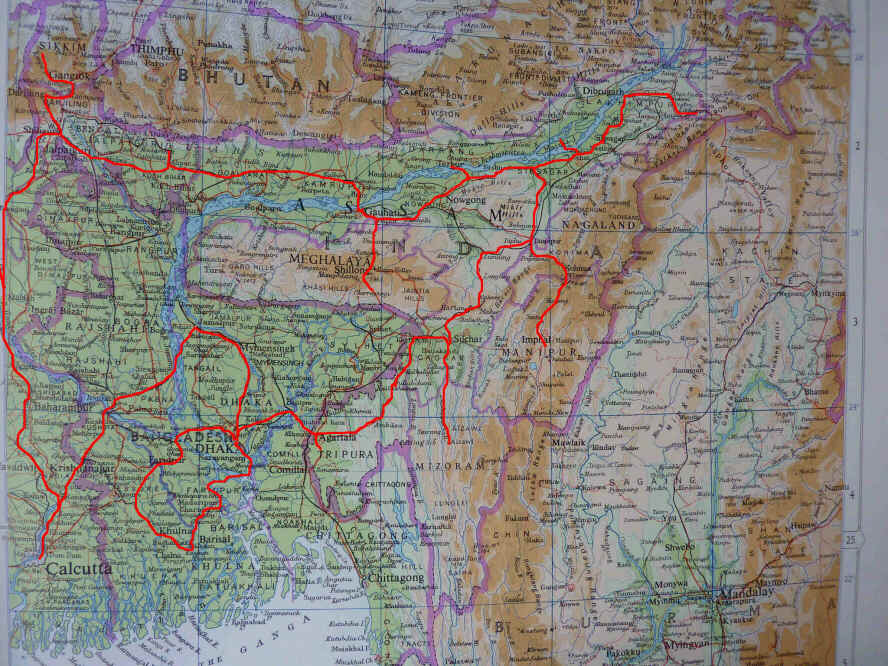
|
Calcutta (Kolkata), India
|
Wed 3rd – Thurs 4th Feb. An extremely long day. We left home at 8:30am in the taxi to Gatwick and flew with Emirates via a quick change in Dubai to Kolkata (Calcutta), arriving at 8am local time, 2:30 am in the UK. We checked into the Lalit hotel, formerly the historic Great Eastern Hotel, which claims to be the longest continually-operating hotel in the world and which Rudyard Kipling described as the best hotel east of Suez. The hotel staff were extremely welcoming and helpful. After a quick wash and brush-up we went to the railway booking office at Fairlie Place and after some bureaucratic confusion about which form to fill in and which desk to go to, we booked AC seats on the Maitree Express to Dhaka on Sunday. We then set off on our second mission to get a permit to visit Arunachal Pradesh state, which is a sensitive tribal area so everyone who goes there has to jump through bureaucratic hoops. Our first problem was to find the Arunachal Pradesh Bhavan (government house) which was way out in the Salt Lake suburb of Calcutta. The hotel concierge gave the taxi driver directions to get there but that didn’t work so we spent an hour or so going from street to street getting conflicting directions from passers-by. Eventually we found what looked like a locked-up, derelict building with Arunachal Bhavan written on it and were walking about outside when bystanders pointed us to a side entrance down the street. We then spent a couple more hours with a very persuasive man who tried to sell us expensive tours for much longer time periods than we had available, who told us we couldn’t travel independently and how complicated the timing was to get a permit (we didn’t realise until later that he was a travel agent, most annoying). We gave up and decided to try again another year when the rules may have changed. Nearby was a nice-looking restaurant called Oudh 1590 but it didn’t open till 6:30 so we headed back to the hotel. Exhausted by now, we walked over to Jimmy’s, a favourite restaurant from our previous visits to Calcutta, and had a delicious Chinese meal with Kingfisher premium beers (no Cobra beer in India, unfortunately) - good food and cold beers but in quite ordinary surroundings.
Fri 5th. After a good night’s sleep we had a much nicer day walking about shopping and sightseeing. We walked over to Sudder Street and booked to stay in the Fairlawn Hotel, one of our previous haunts, for when we return to Calcutta at the end of the trip. Room 6 was highly recommended although it was occupied at the time so we couldn’t see it. Try as she might (and she can be quite trying as some of you will know) Sheila couldn’t persuade me to go back to the Great Eastern - much too expensive. We did some shopping in the market and in the nearby streets and had a restorative drink in Blue Sky Café (another haunt from our previous visits, always full of tourists but with a good menu), then went back to the Great Eastern and went with two of the nice lady staff on the fascinating ‘heritage tour’ of the hotel and the adjacent old bakery. Then we set off on the ‘Second City of the Empire’ walk from the Walks in Calcutta book that I purchased from a bookstall last time we were here. This walk took us past the gate of Raj Bhavan, the West Bengal governor’s residence and as we were standing by the gate (you can’t go in) police materialised everywhere, closed off the road and a convoy with sirens blaring and the governor in a nice car in the centre, swept out of the gates down the road. We walked past several other once-impressive Raj-era buildings to St John’s Church, a haven of peace from the hooting traffic, with substantial memorials in the churchyard to notable people from the early days of the British presence. |
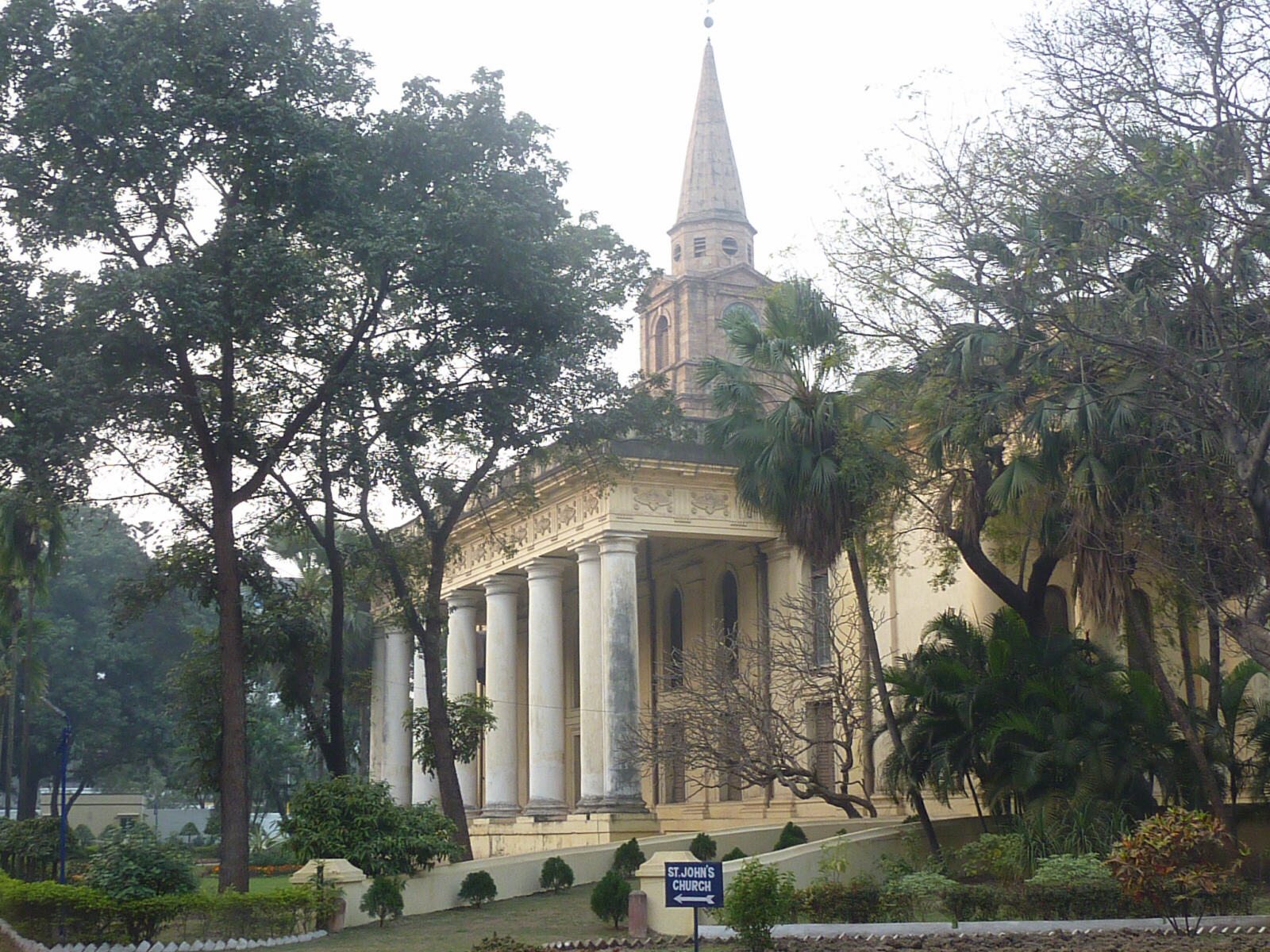
|
Then on past other 19th century buildings including the Post Office, the most impressive of all, with a huge rotunda at the corner and facades of tall Ionian pillars. It was getting dark now and the gardens around the lake and fountains in Dalhousie Square were closed (although it’s not clear if they are ever open) so we weaved our way through the manic traffic back to the hotel. |
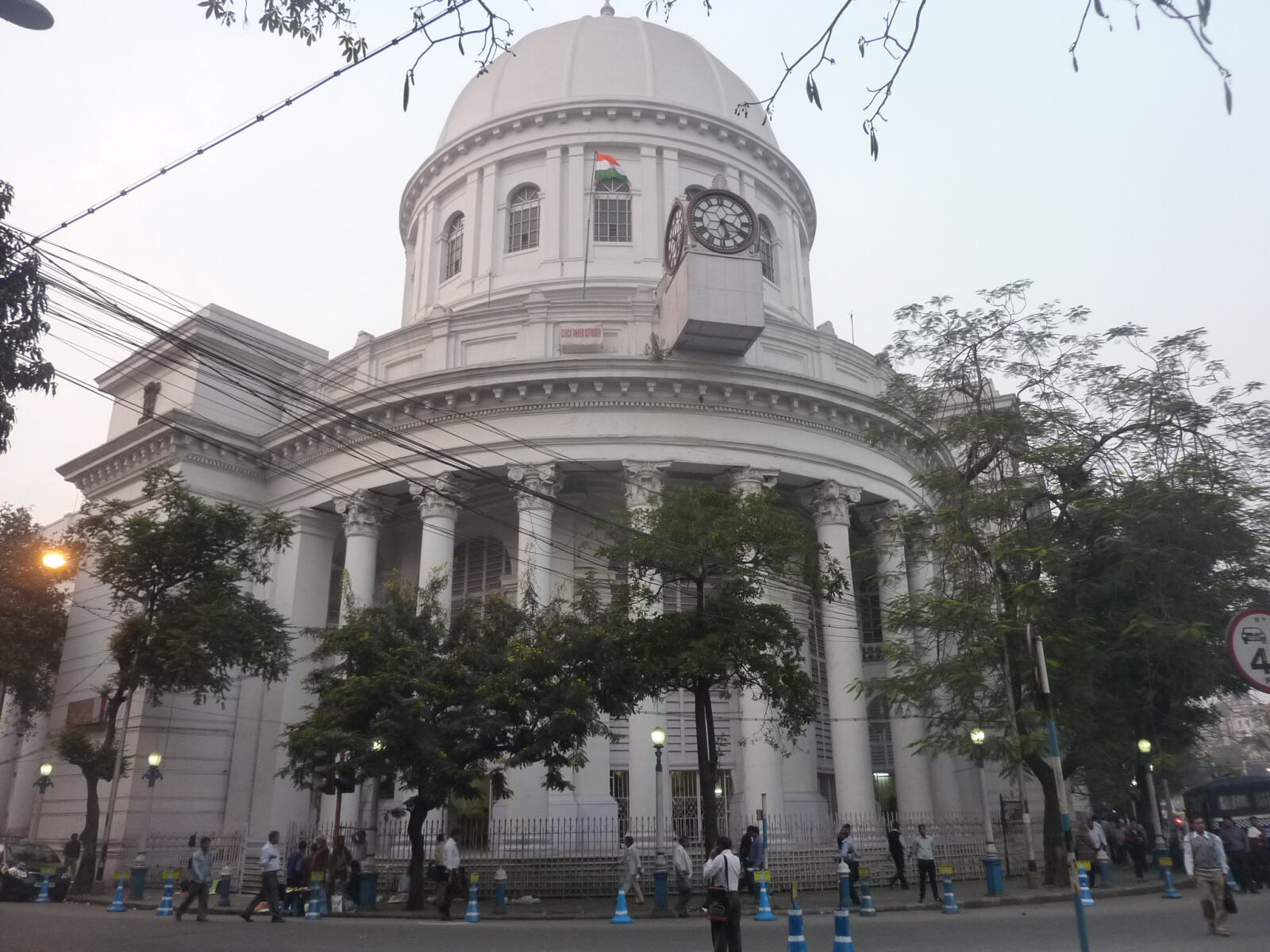
|
We set out to go to one of our other favourite restaurants but thought we would check out some of the bar/restaurants along Waterloo Street, the side road outside our hotel. We were expecting gloomy men-only drinking dives which many of them are, but by luck the first place we went into, the Manthan Restaurant, was bright and cheerful with friendly staff and served excellent, tasty food. We had a really nice Indian meal (they offer Chinese too) with the obligatory Kingfisher beers (there was a wine menu but none was available unfortunately) for a very reasonable price, and retired to the hotel having had a very pleasant day.
Sat 6th. Sheila needed some persuading to leave the lovely hotel, but eventually we went on an expedition to a tourist sight that hardly any tourists visit. We got a taxi out to the suburbs along Jessore Road to just past the junction with Dum Dum Road, then down a little side road on the left we found Clive’s House. After the battle of Plassy, Robert Clive built a substantial house on a small hill to use as his ‘garden house’ when he was in Calcutta. Now it is a ruinous red-brick shell with some brick columns inside, covered in creepers and scaffolding built by the Archaeological Department who are supposedly renovating it. Although we couldn’t go inside it was a fascinating, atmospheric place. |
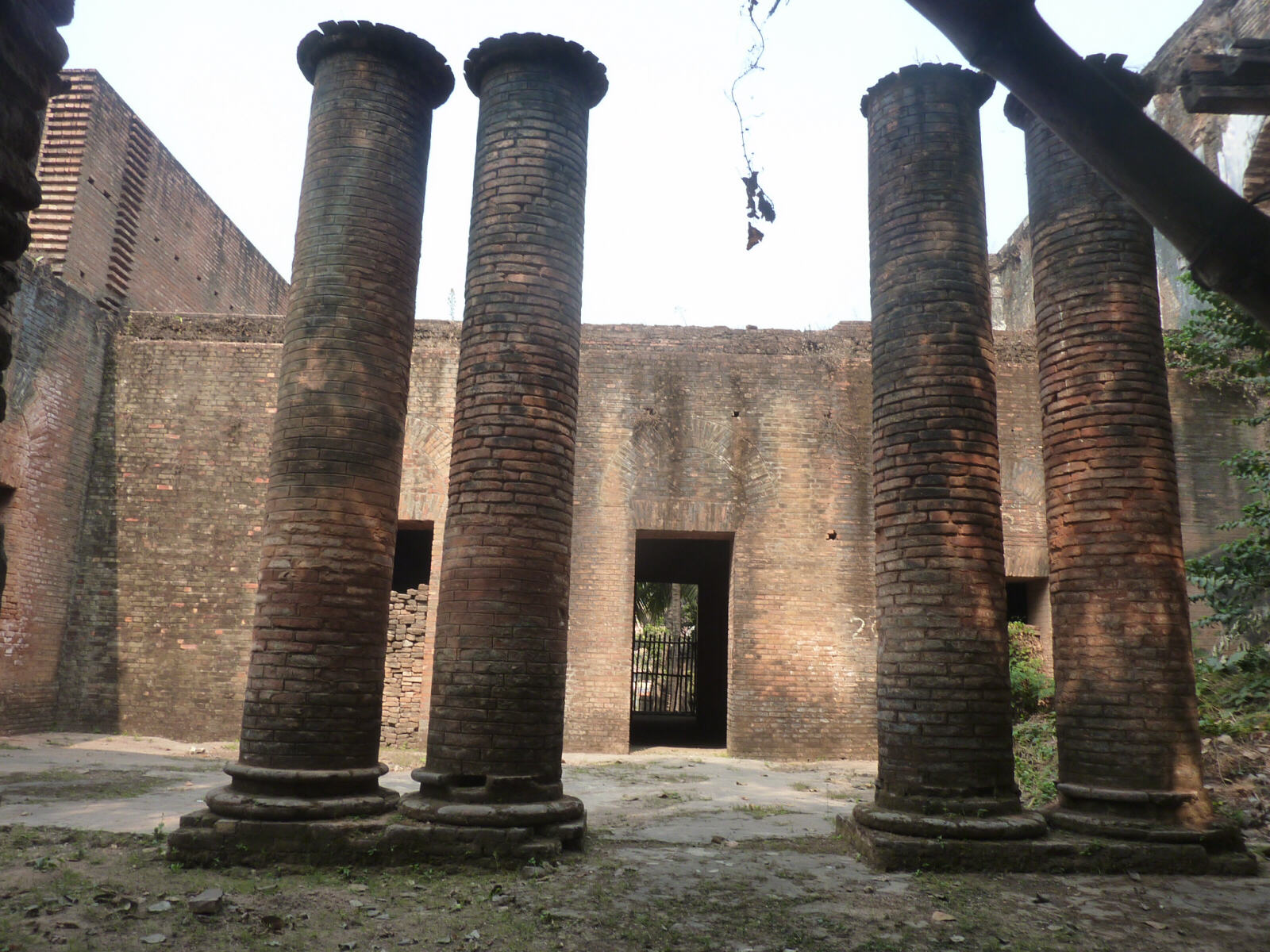
|
The taxi ride back to the city was another entertaining ride through the wild traffic and the roadside markets. We had a quieter afternoon with an expensive coffee and cake at Wilson’s Bakery by the hotel, then walked down to the New Market for a bit of shopping. We walked up to Park Street to try to find the restaurant with singing ladies where we used to eat but it seemed to have disappeared, so we got a taxi back to the hotel and had another delicious meal at Manthan restaurant across the road. |
Dhaka, Bangladesh
|
Sun 7th. We were up early and got the 7:30 Maitree Express international train from Kolkata to Dhaka in Bangladesh. The train ride was fun, the other passengers were friendly and the passing view of endless green farms and paddy-fields, especially on the Bangladesh side, was picturesque. Even the four hours of bureaucracy and mayhem at the border was fun once you got stuck into it, and on the India side we and one other European were taken to the front of the queue and given an easy time. It was when we arrived in Dhaka about 6 or 7pm that it all went horribly wrong because no ATMs would accept our cards and we were stuck without cash. We changed some of our Indian currency to Bangla Taka at a money change shop but that won’t last long. Eventually after some difficulty finding it the nice taxi man dropped us at our hotel, the Anchorage, which was in a back street miles from anywhere. The hotel was quite new and very pleasant, with lots of hot water, clean rooms, a nice restaurant and all the staff went out of their way to help us. We ate in the hotel and put it on the bill which we can pay by credit card to save our precious cash.
Mon 8th. We sat around the hotel all morning and most of the afternoon, reading books while various things sorted themselves out. After extensive consultation with the hotel accountant, the nice man on reception decided they could cash us £80 on our debit card, which gave us some local money which was a great relief. We started making plans to travel on to India, but then it turned out that the owner of the hotel also owned a major shipping line and probably due to his connections, the steamer office called back to say that we had a reserved cabin on the historic old ‘Rocket’ paddle steamer tomorrow. Feeling much better and with money in our pocket, we got a cycle rickshaw for 20 pence to a shopping plaza on the main road. Or rather, opposite the plaza on the wrong side of the road, so risking life and limb through the nightmare traffic and lethal bus drivers (the worst driving we have EVER come across and that’s saying something) we managed to cross and Sheila bought a nice pottery mosquito-coil holder in a department store for £1 for a birthday, anniversary and valentine’s present (we will see if it gets home in one piece or that’s a pound wasted!), We started enquiring where we could find a bar to get a beer and three rickshaw rides later, after being refused entry to a members-only club and several other misdirections, a nice man pointed out the Orchid Recreation club, a rather smoky but otherwise interesting bar on two floors (one with live music), where we got several local beers for £1.70, a fraction of the £4.30 they charge for the same things in our hotel, as well as a selection of tasty starters from their extensive menu. All around us local Bangladeshis, singly or in groups of up to six or more, were quaffing whiskies and having a great time.
Tues 9th. The Anchorage hotel was in Uttara district which is way to the north of Dhaka city and everything we wanted to do was to the south, so that meant some marathon taxi rides through the traffic chaos. Sure enough it was a 2½ hour, £12 ride (mostly at a standstill) to the Inland Waterways reservation office on Dilkhusha Street in the old town. We met Mr Faisal and he had kept the reservation I made by phone from England (or maybe it was the influence of the shipping owner at the Anchorage) and we bought tickets for a first-class cabin on the Rocket for £32. The Rockets are nearly 100 years old and used to be the fastest way to travel around Bangladesh. Now there are just two left and they go on Tuesdays and Sundays. We thought the area looked familiar and just near the waterways office we noticed the Purbani Hotel, opposite the statue of some herons, where we stayed 20 years ago on our previous visit to Dhaka (that time Sheila said ‘never again’!) The Rocket departs initially from Badam Toli ghat (jetty) and then calls at Sadar Ghat before leaving Dhaka. We had a few hours to kill so we got a cycle rickshaw from the waterways office to Sadar Ghat and went for a half-hour boat ride on one of the uncomfortable little wooden ferry-boats .... |
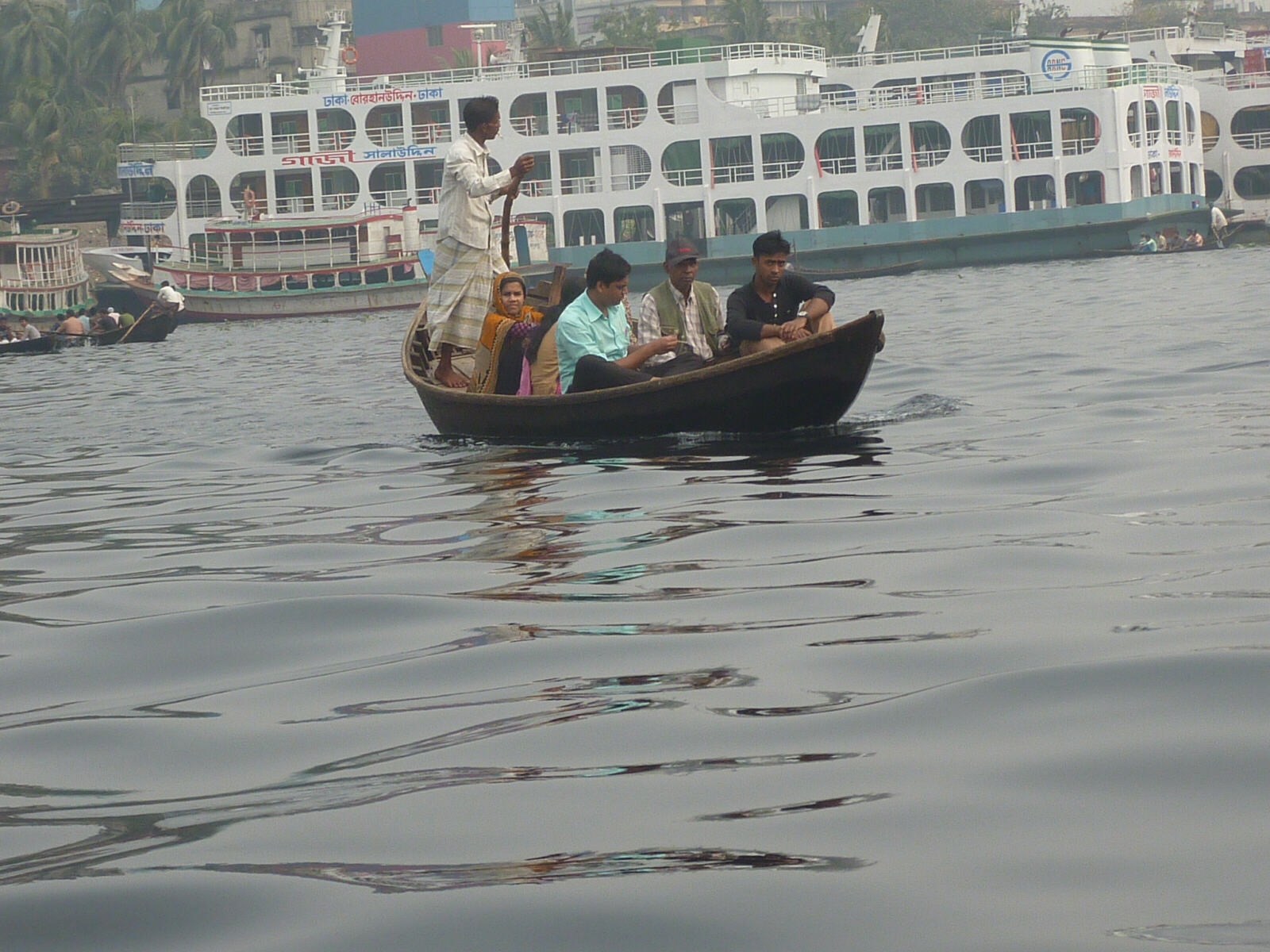
|
.... then walked up and down watching the boats of all shapes and sizes coming and going ....
|
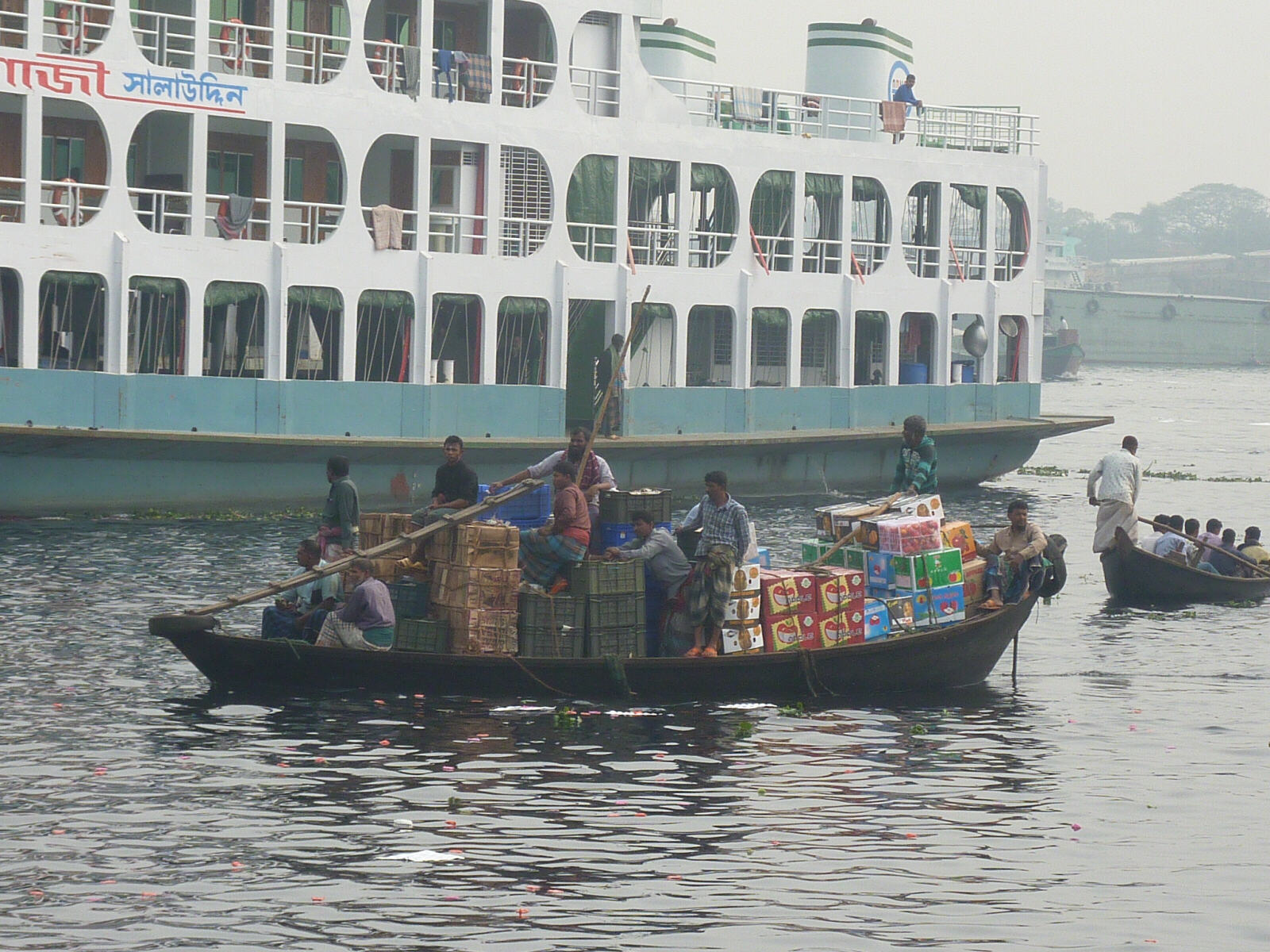
|
.... and the amazing range of fruit and veg in the riverside market strung out all along the ghat.
|
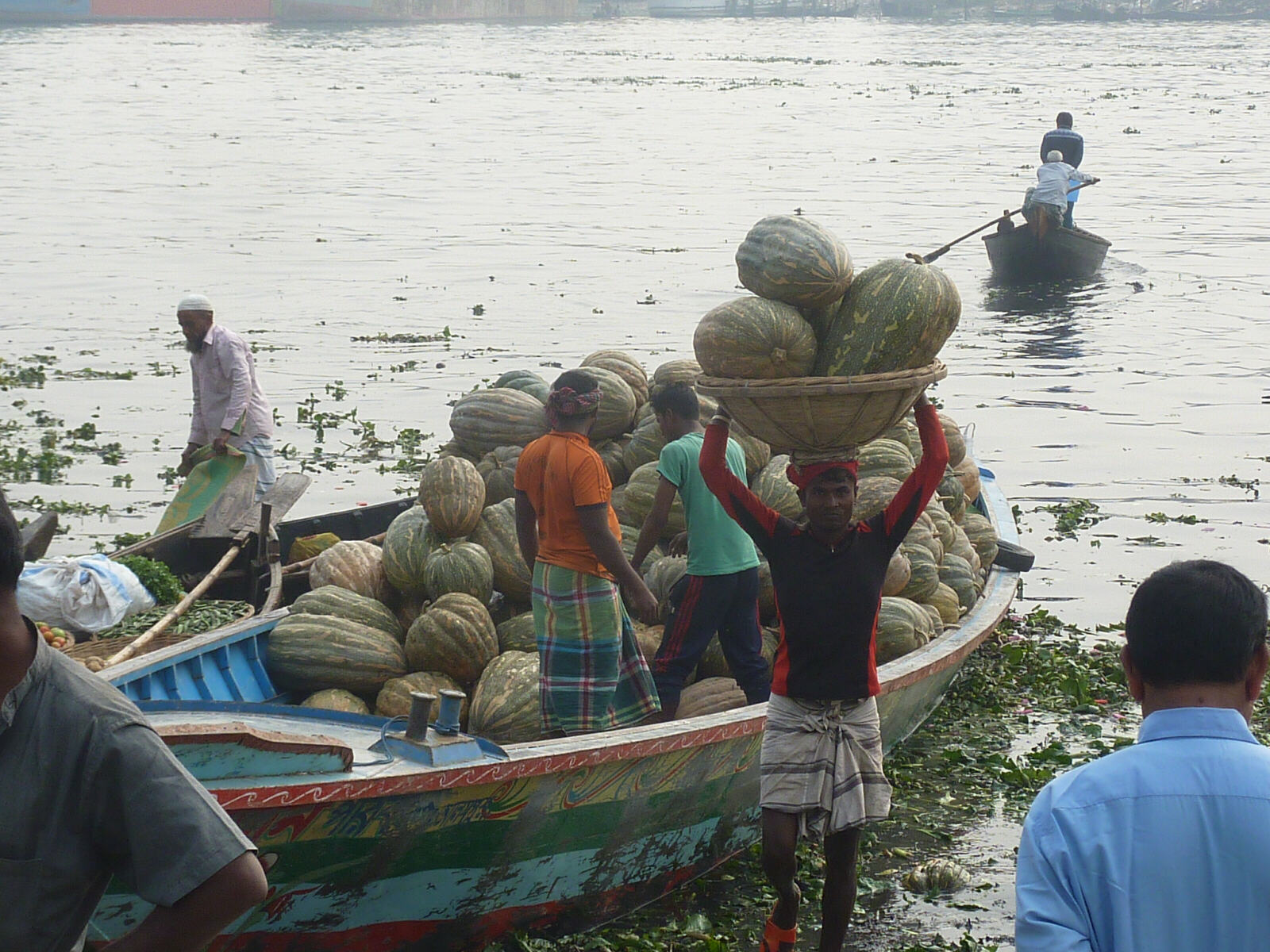
|
People were unloading and carrying huge baskets of cauliflowers, aubergines and sacks and boxes of other stuff on their heads, and everyone in the market was friendly and cheerful and loved being photographed (and often took a photo of us in return!) |
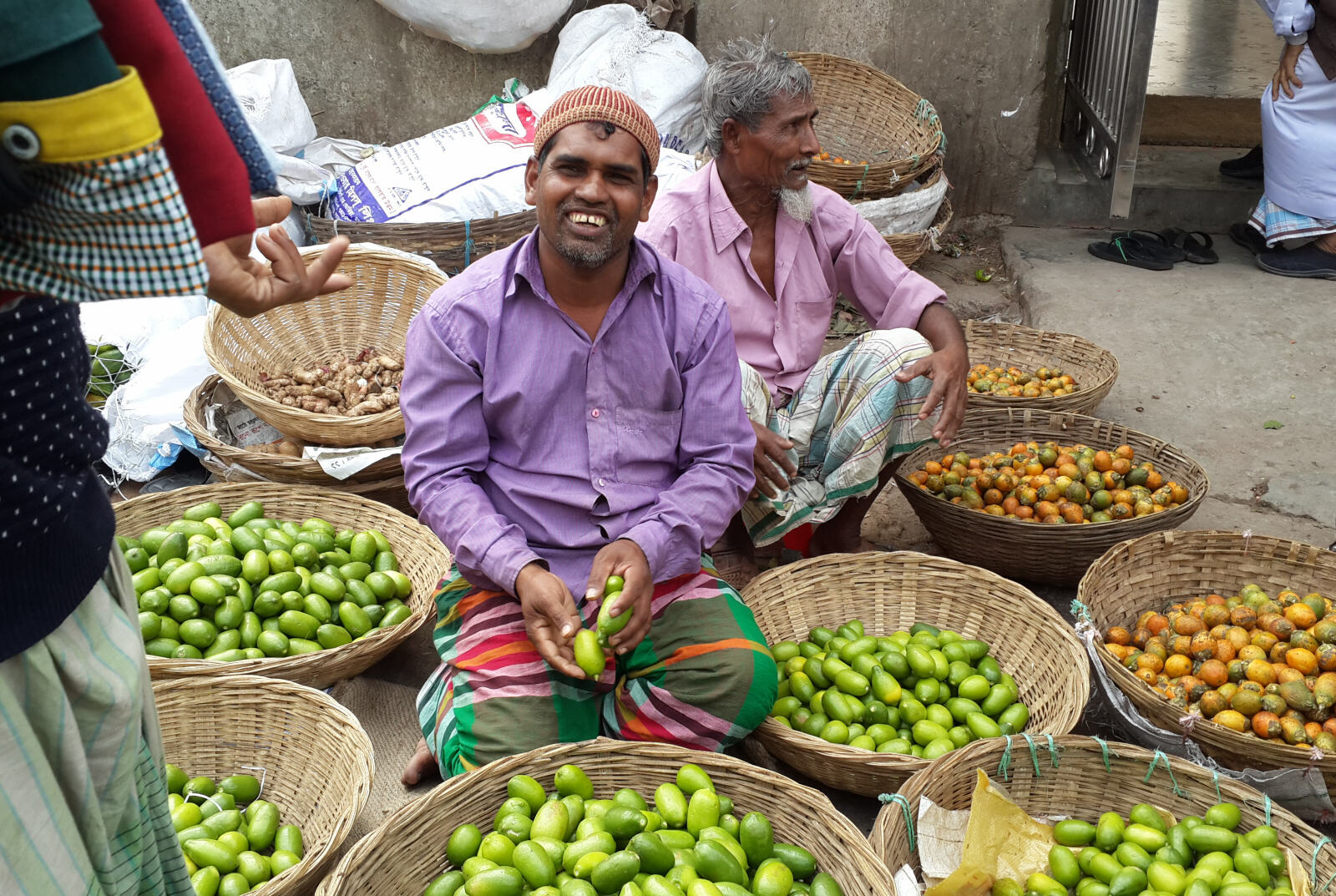
|
The Rocket paddle steamer, Bangladesh
|
After a refreshing glass of tea at a chai stall we got another rickshaw to Badam Toli, boarded the Rocket steamer ‘Mahsud’ (built in 1920) and settled into our nice, wood-panelled cabin with two beds, a table, chair, sink, fans and a TV set. Outside in the central area between the first class cabins stewards were laying the table, we hoped for dinner because we were pretty hungry by then, while downstairs in the third-class areas families were claiming their territory on the deck by laying out blankets and spreading their belongings on them. |
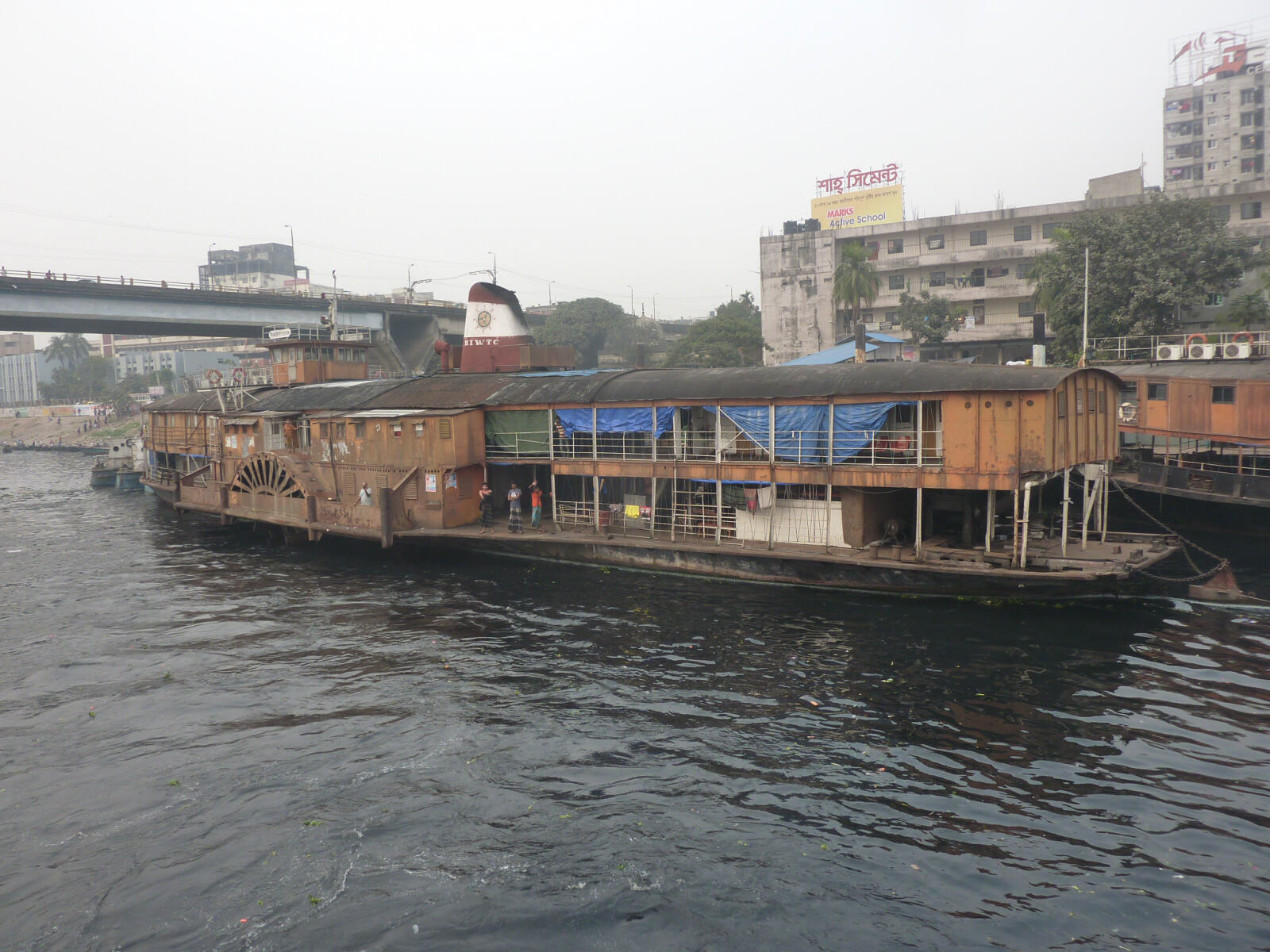
|
The Rocket left Badam Toli and moved a short way down the river to Sadar Ghat, past the renovated and very pink Asan Manzil palace. There was an hour and a half’s wait at Sadar Ghat so we went onto the quayside where there was a row of food sellers and had a couple of tasty concoctions costing pennies mixed up and served on the spot, then followed it by a glass of tea at the chai stall at the top of the ramp (never eat roadside food, salads or ice cream they say – I’m afraid we don’t take any notice, but we only drink bottled water). All the while we were helped along by friendly and curious onlookers who kept offering us more food. We went back on board and at 6:30 we set off leaving the host of small and big boats and all their passengers and sellers behind. |
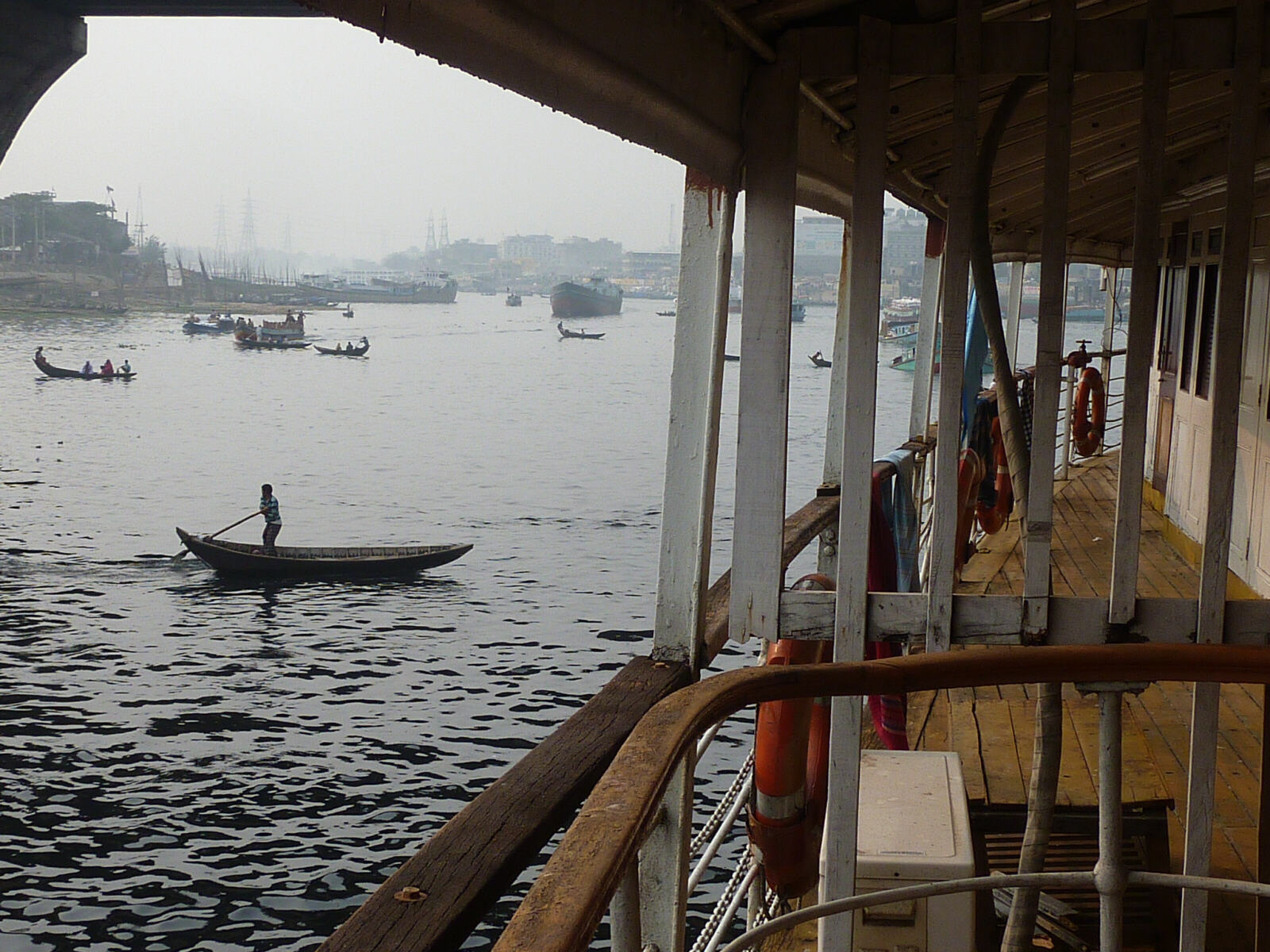
|
The riverside grew dark and featureless so we retired to our cosy cabin. At 8:30 a knock on the door announced that dinner was served, and we sat at a huge, 18-place table set for three groups of two foreigners, apparently segregated as far from each other as possible! We had one English and one Bengali meal and each one had some good elements and some less so, although the main problem was that most of the food was luke-warm at best. After a quick look over the railing at the dark river we retired to our cabin.
Wed 10th. We had a very good night’s sleep and woke up about 7am as we moved away from the jetty at a small town on the river. |
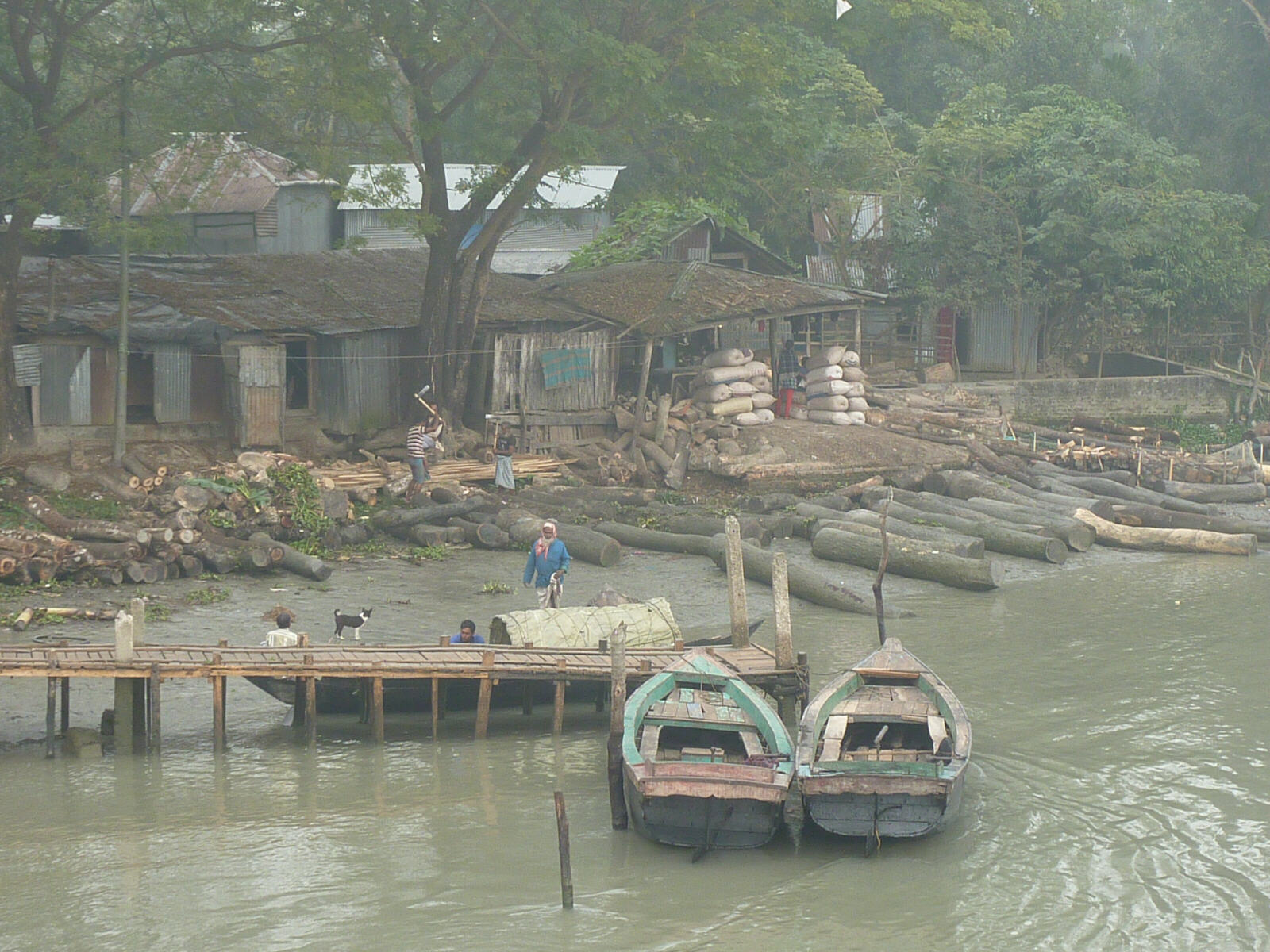
|
Breakfast was an eclectic mixture of omelette and fish and chips (last night’s leftovers). About 10:30 we arrived at Hularhat, our destination, and got a smooth electric rickshaw through the villages and paddy-fields for an hour to Bagerhat, a Unesco world heritage site with a number of historic 15th century mosques spread over several kilometres. We went into the impressive Sait Gumbad mosque, a big red-brick structure with 77 domes and four corner minarets, set in a well-kept garden. Then we walked around the nearby lake and along a brick path to Bibi Begni’s mosque, a smaller single-domed structure in the middle of village houses and ‘tanks’. |
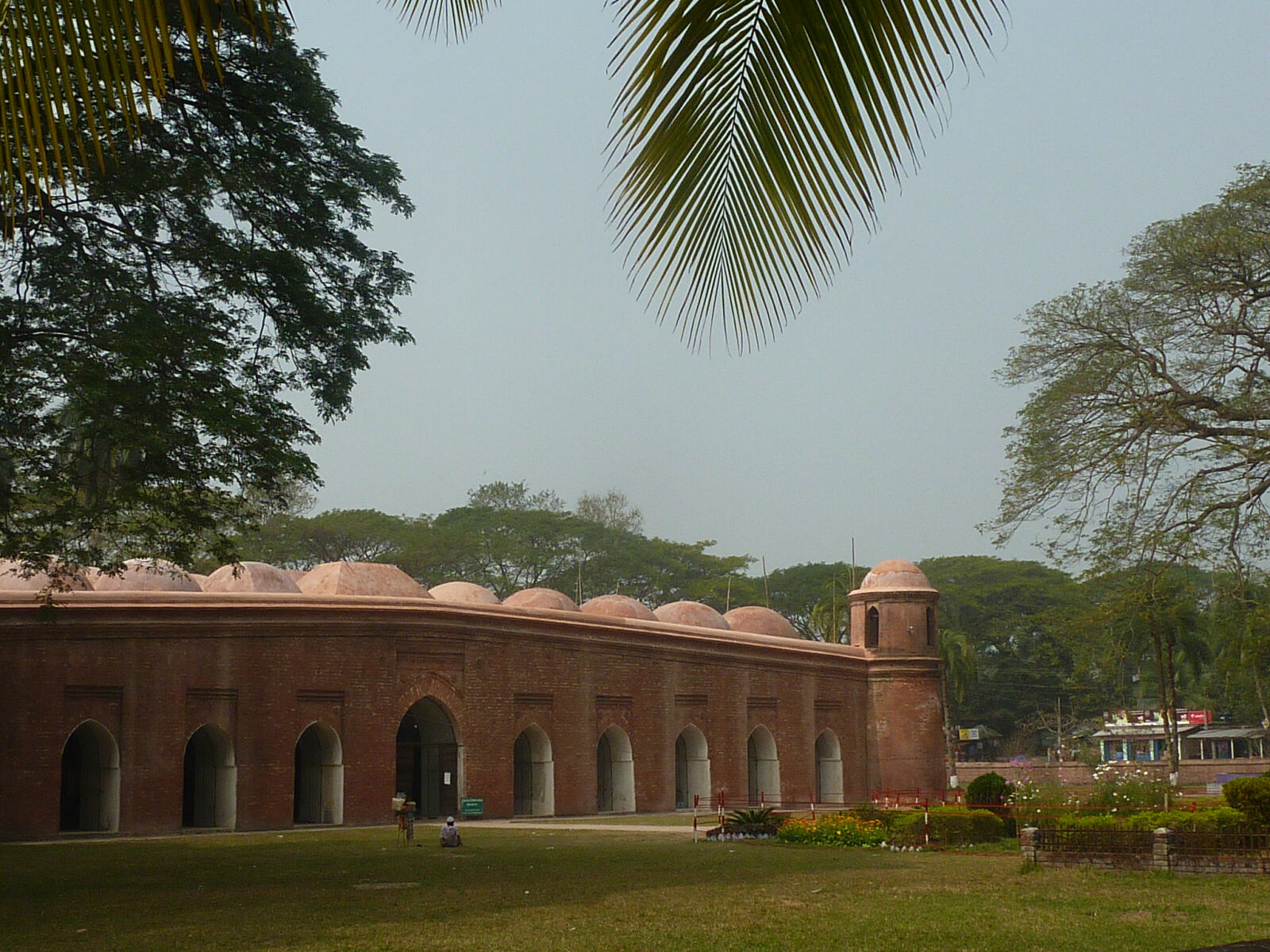
|
All along the way everyone was very friendly and greeted us with ‘how are you’, then when we stopped at a tea stall a school-full of 20 or 30 teenage girls and boys and their headmaster clustered round taking photos of us and ‘selfies’ of themselves with us, and we couldn’t get away until every single one had got two or three shots of us with them or their friends. |
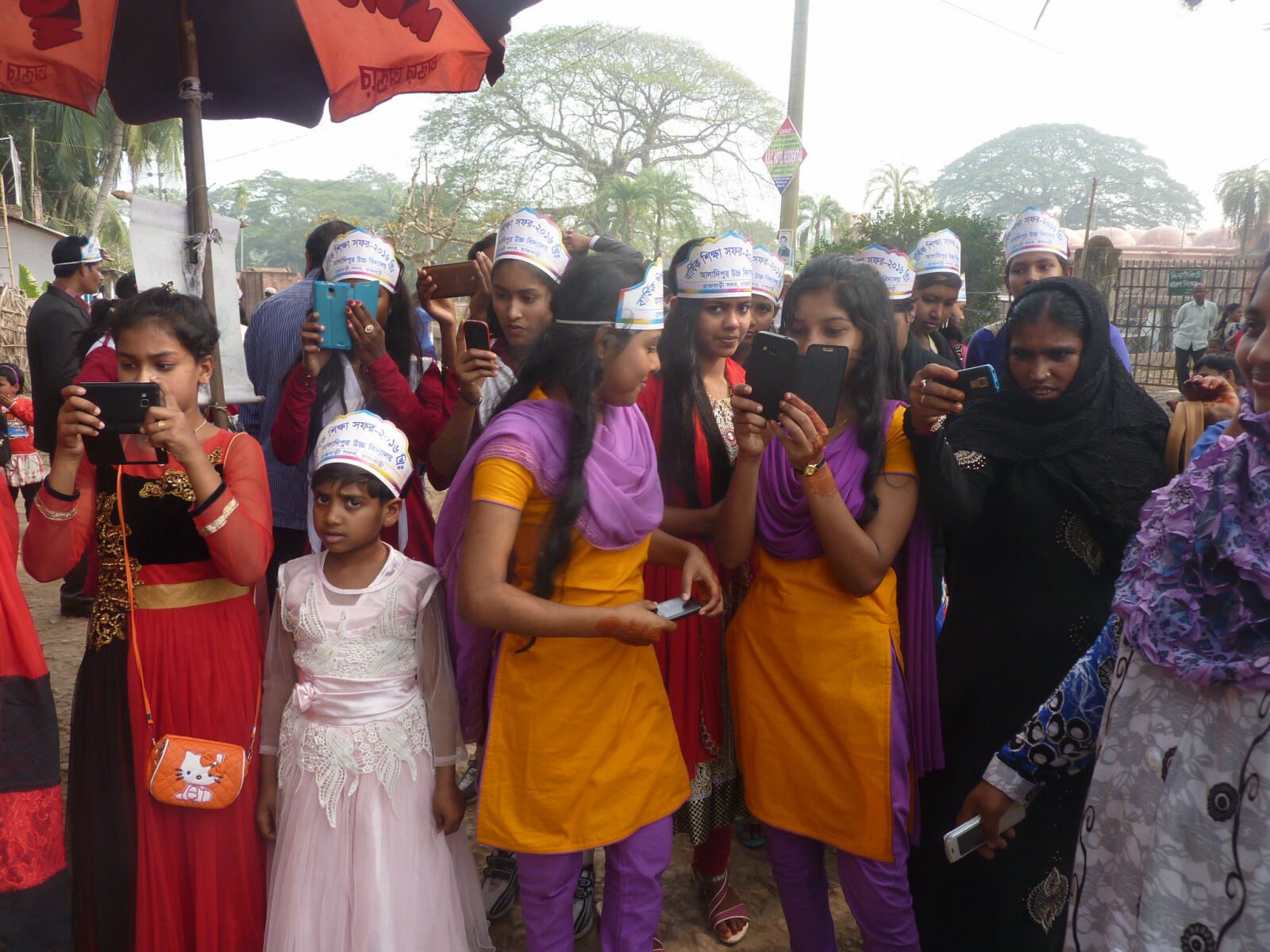
|
We got another rickshaw for the 1½ hour ride to Khulna, which started out fine through more picturesque villages but then deteriorated as the surroundings became more industrial and we were forced to the side of the road by endless lorries and buses. The driver tried to drop us in the middle of nowhere rather than in Khulna itself but Sheila refused to get out so he had to carry on. At the entrance to the town we were stopped by the ‘rickshaw mafia’ who intimidated our driver and said we would have to get out there and go with them, but we said we’d already paid him and refused and they eventually let us through. We hoped our driver didn’t get into trouble on his way back. There is not much of interest in Khulna but it’s a transport hub and we had been recommended to stay at the Royal Hotel which was conveniently opposite the Eagle bus office where we booked an AC luxury bus to Dhaka tomorrow. Our room at the Royal was reasonable for £20 although the bed was indistinguishable from sleeping on the floor, but the restaurant was rather soulless so we went across the road to the only other option we could find, the Castle Salaam hotel (which would have been a better choice) and in their busy western-style café Bistro-C, had an interesting selection of chilli fries, pepperoni pizza and a sizzling chocolate brownie with ice cream, helped along by a strange-tasting Mojito ‘mocktail’.
|
Dhaka again
|
Thurs 11th. The Dhaka bus was indeed quite luxurious with wide comfortable seats and lots of legroom and amazingly we set off on the dot of 8am as advertised. The AC was fierce but the conductor gave us blankets. Along the way there were rice paddies, villages and animals including bullocks ploughing the paddies, but also quite a lot of jute mills and many brickworks and other blighted industrial sites. Even though it is well into the dry season there was water everywhere in ponds, pools and paddies across the flat landscape. We stopped for lunch at one of the bleak coach-stop restaurants and our bus conductor was horrified when I went instead to a nearby tea stall by the roadside and had a glass of chai sitting on the bamboo benches being scrutinized by the curious local clientele. We set off again but about 2pm we stopped in a long queue. The reason became clear when we eventually got to a jetty on a huge wide river, presumably a main branch of the Ganges / Brahmaputra, where queues of smoky old vehicle ferries were coming in and out loaded with buses and lorries while smaller boats went back and forth to a mud landing stage nearby and people were washing themselves at the adjacent washing ghat. We chugged across the river and got going again around 4:30. About 5:30 the inevitable happened and we had a crash. The driver suddenly did a full emergency stop, throwing us into the seat in front and collided slightly with a motorbike. No-one was hurt but a vitriolic argument erupted. Luckily, from the motorcyclist’s point of view, we were beside a brickworks so he concluded the argument by smashing the bus driver’s window with a brick and drove off. No safety glass here and the bus crew swept lots of long shards of glass off the bus onto the roadside; there are no pavements of course so tough for the pedestrians in flip-flops. At 8pm the bus finally stopped by the road in Dhaka and we all got off. With the help of a friendly English-speaking lady passenger we got a tuk-tuk (auto rickshaw) for the 1 hour+ drive to the hotel. Bangladesh tuk-tuks are all enclosed in sturdy metal mesh cages like a prison cell and we wove through the manic traffic not sure if we were safer inside or out. The maniac bus drivers made sure we had one of the most dangerous rides of our lives but luckily we got to the Anchorage hotel without incident and the receptionist welcomed us back like old friends. Not bothering to wash or unpack we dumped our bags in the room and set off in a cycle rickshaw to the Orchid bar for a well-earned few beers and tasty satay and reshmi kebabs. It was just as well we went there straight away because an hour later they rang the ‘last orders’ bell and started cleaning up and switching lights off.
Fri 12th. After all the kerfuffle yesterday we had a lie in and a quiet day arranging things, then went for a superb meal at the Mainland China restaurant at the top of one of the towers on the main road. We had table 3 with a great view of the traffic chaos down below, and although the restaurant does not serve alcohol you can bring your own, and we took the precaution of bringing four cans of local Hunter’s beer from the Orchid bar last night. At first we couldn’t work out why the nearby tables kept moving until we realized that the central part was a revolving restaurant, but the outer tables (the ones with the view) didn’t move. The food was excellent and we had an interesting chat with the manager who had worked at restaurants all over England and Scotland. Finally he gave us a free sizzling chocolate brownie and ice cream for pudding for Sheila’s birthday. |
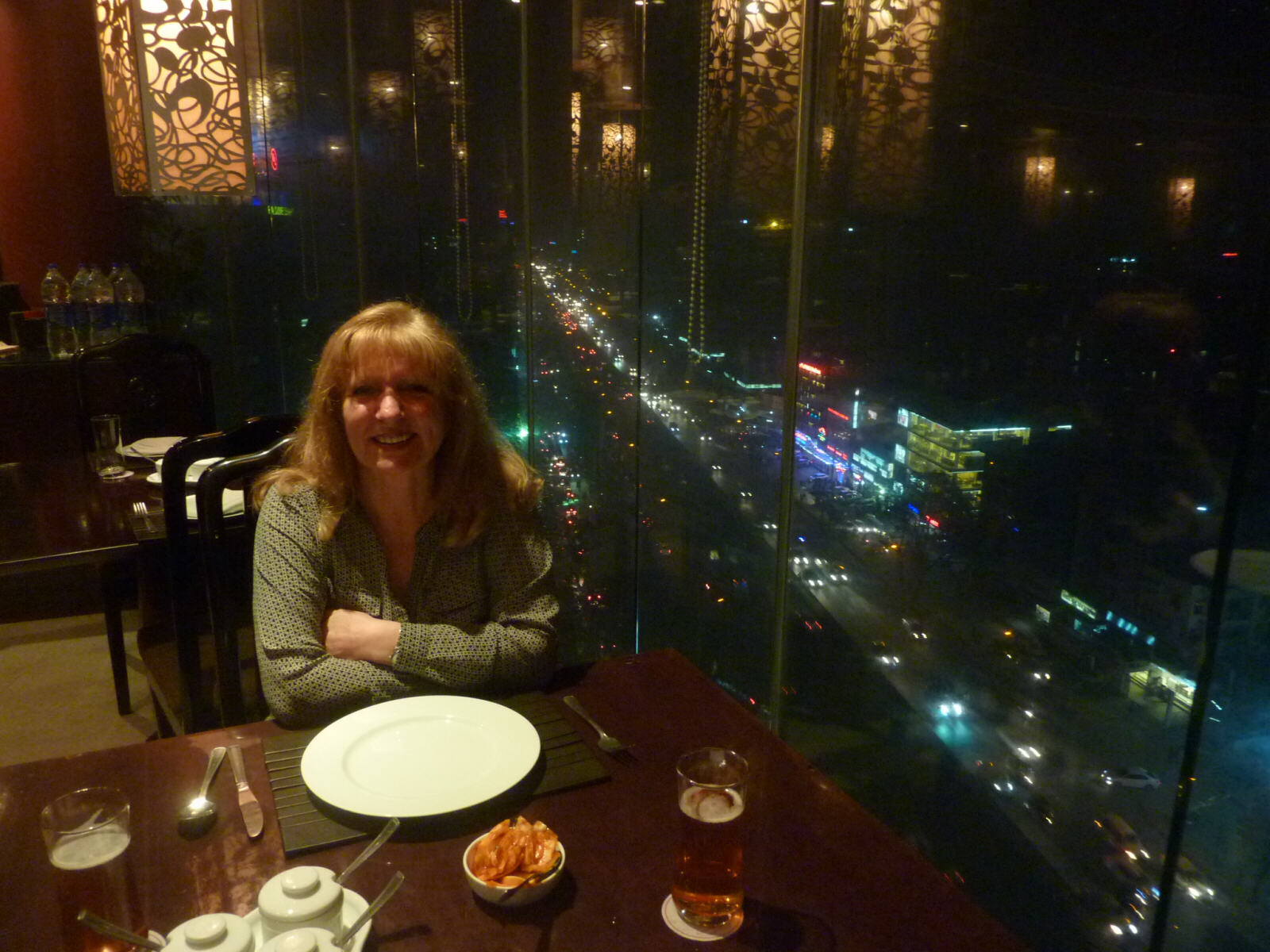
|
India
Agartala, Tripura state
|
Sat 13th. After fried eggs for breakfast in the hotel’s top-floor dining room, our expensive car arrived to take us east to the Indian border. We went past a long queue of lorries coming back into India with stones that had been mined there, crushed in Bangladesh and re-imported. The border formalities were straightforward and, because we were almost the only foot passengers crossing, quite quick. The border post typified the differences between Bangladesh and India – the Bangladesh side was a couple of huts, one for collecting the £5 ‘travel tax’ to get out, where the surly staff insistently wanted ‘backsheesh’ or ‘tips’ as well. We didn’t pay and told them they should be ashamed of themselves. The other hut was a nice old immigration office piled with dusty ledgers, into two of which they painstakingly wrote our details, and with friendly staff who didn’t ask for tips. Across on the Indian side there was a big new almost airport-style ‘passenger terminal’ with lots of space and relatively clean toilets, all for just us and one other passenger in the whole place. The staff here (both of them, one immigration and one customs) were relaxed and helpful as they entered our details into a computer. Outside there was one single auto-rickshaw driver who took us to the Ginger Hotel in nearby Agartala which looked nice on Booking.com and was very pleasant. Being quite a nice hotel it had coffee/tea-making facilities in the room which was most welcome. It has a restaurant but doesn’t serve alcohol and there’s a Coffee Day café but apart from that there are no other dining options nearby. We got an auto-rickshaw down to the tourist office but it was closed because today is a festival and public holiday, so we started walking round the lake taking pictures of the impressive 19th-century former maharaja’s palace across the water. |
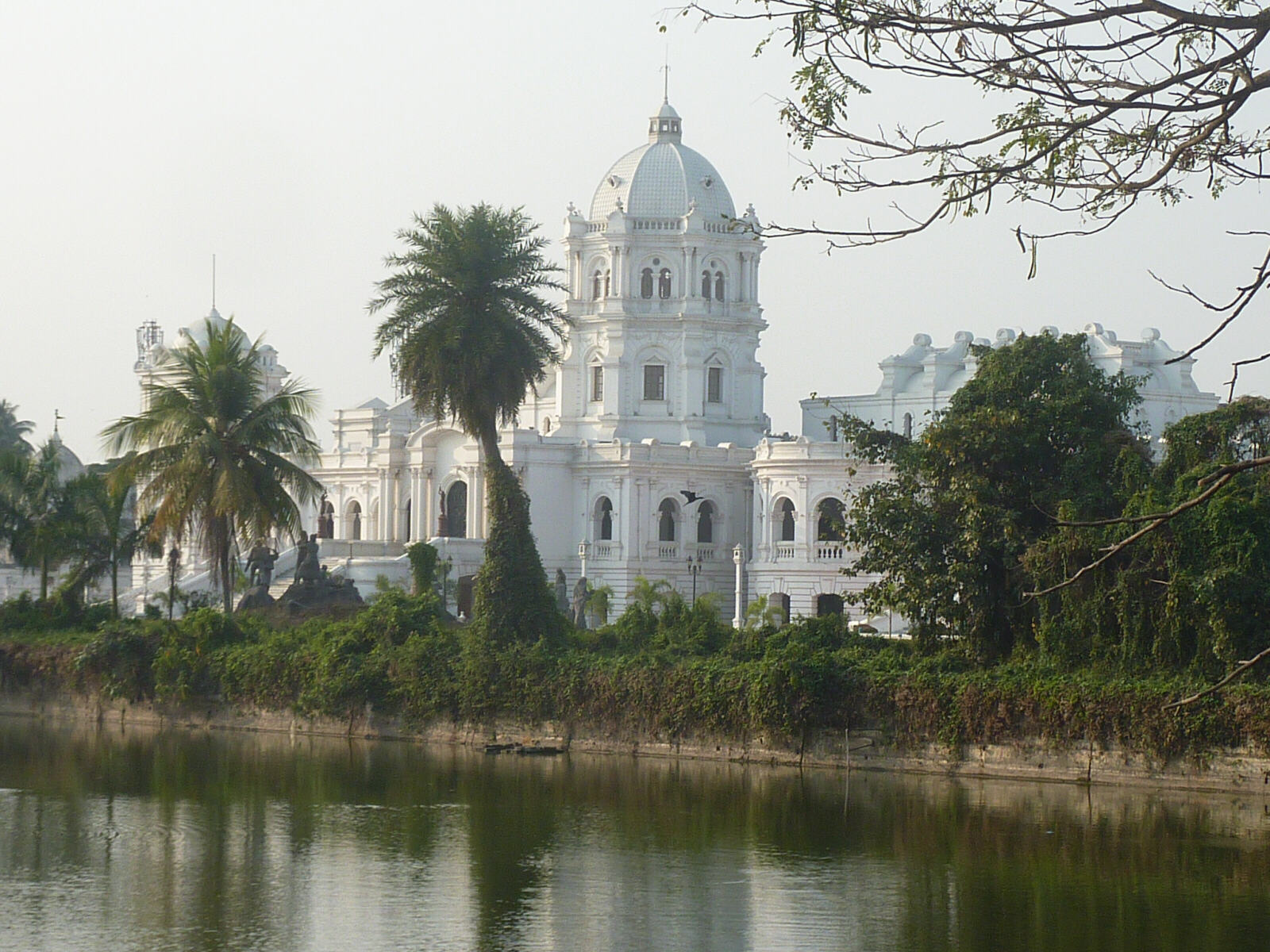
|
The nearby Tax office had been transformed into a festival venue and all the workers there were celebrating and as we walked past they insistently called us in. They had set up a colourful shrine to the goddess and beside it was a ‘statue’ of Shiva, which was actually a man covered in grey paint and colourful makeup, standing completely still. They told us he didn’t blink for the entire day and he certainly didn’t while we were watching. |
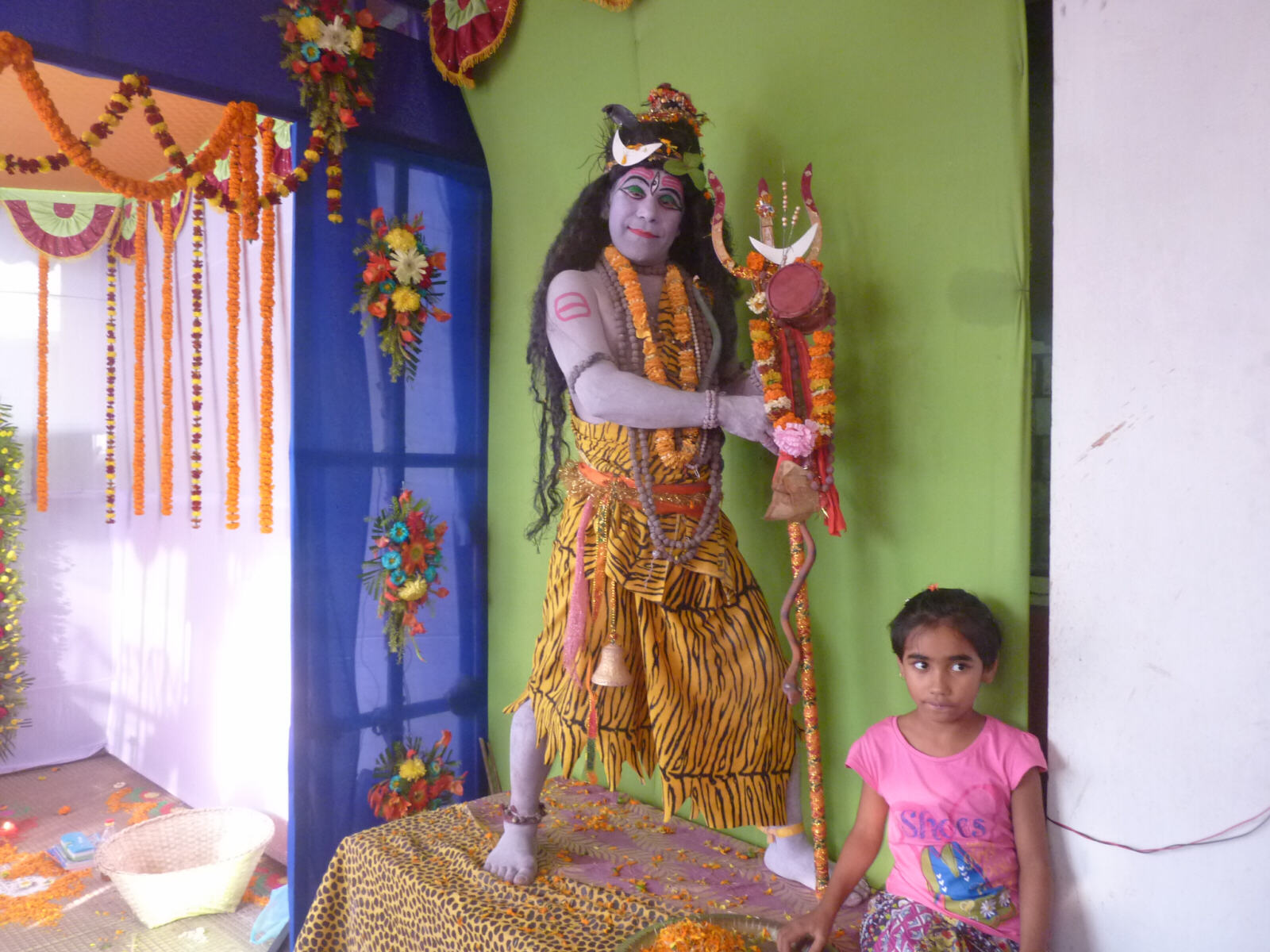
|
Then the people invited us in to share their festival feast and we sat at a table with plates in front of us and huge servings of dal, curried vegetables and fried aubergine were ladled onto them from silver-coloured buckets. It was delicious, and finished off with a big ball of sweet, sticky gulab-jamon type sweet. I ate it all with my fingers like everyone else but they took pity on Sheila and brought her a spoon (she says she has delicate fingers which burn easily). All the time the ‘official photographer’ was snapping away then the session ended as always with everyone taking photos on their phones of each other with us. We carried on walking round the pools and went into the Jaganath Mandir (Juggernaught temple) which was a riot of idols and ‘wedding cake’ architecture painted in ice cream sundae colours, full of ladies dressed in beautiful colourful saris for the special occasion. By the time we had finished walking round and being on passer-by’s ‘selfies’ it was getting dark so we walked up to the main road and got a tuk-tuk back to the hotel. We were still full after the festival meal so we had teas in our room and watched ‘Castle’ on the TV.
Sun 16th. As a Valentine’s day treat we went to Udaipur – no, not the one in Rajasthan (some treat Sheila says!) We went on a hotel-organised guided tour to the other Udaipur, the former capital of Tripura State, about an hour away, where there are several 17th century temples. Well, in fact I became the guide because our taxi driver took us to one dirty, modern, uninteresting temple then said ‘back to hotel now?’ I had to tell him to get directions first to Bhuvaneswar, a nice compact renovated red-brick temple overlooking the river, then to (another) Jaganath Mandir, a huge, crumbling un-renovated temple covered in creepers with trees growing out of the roof. |
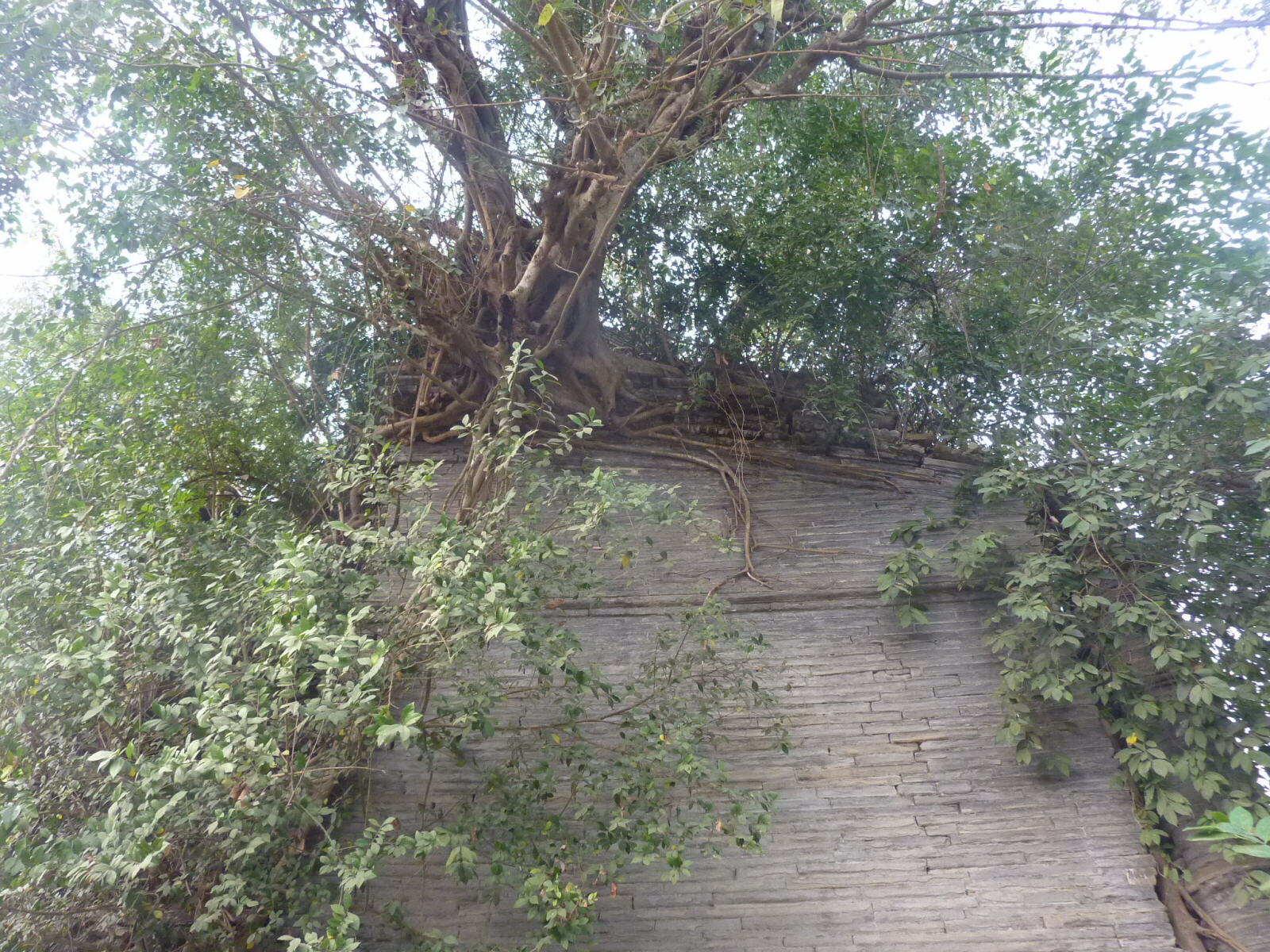
|
We stopped in at another strange old temple complex with arched roofs topped by mini-stupas. Back in the Ginger hotel we had egg curry in the restaurant then prepared for an early start tomorrow. |
Aizawl, Mizoram state
|
Mon 15th. We set off at 6:30am for the long drive to Aizawl (pronounced eyes-all), the capital of Mizoram, the next state over. However, because of the mountains in the way we had to go a long way round via Assam to get there and it cost £120. We had a very good driver and a very comfortable car, and enjoyed the journey although a lot of the roads were terrible. We started off on the winding, up and down road through the hills in Tripura state, then as soon as we got to Assam the land was completely flat but the road was appalling, just a dusty, bumpy unsurfaced track (and this is the only road in and out of Tripura). After hours of bumping through the dust the road improved a bit and we started going uphill and soon reached the border of Mizoram state. We stopped at the check point and our details were copied into a big ledger, but they didn’t ask for a permit which used to be required until recently. Now the road surface was quite smooth but the hills were even hillier and more winding. There was no flat land at all and villages were strung along the road, with little shacks level with the road at the front but supported by immensely long poles at the back. We stopped a couple of times at little grimy cafés for tea and boiled eggs. When we had asked the man in charge in Agartala how long the journey would take he said 14 hours then joked “unless there’s a landslide”. After 14 hours we were just approaching Aizawl when we came to a traffic jam. Everyone switched their engines off and waited and waited, until word filtered back that there had indeed been a landslide and the road was completely blocked. The taxis started doing U-turns and going back down the hill, so we followed one who took off up a dirt road over the hills and for an hour we bumped through the dust until we came into town from another direction. We then had the usual performance of asking directions to our hotel, compounded by the fact that our driver spoke only Hindi while the local people spoke the local language. All the local people here and in the villages in the hills, look much more Thai or Burmese than Indian, and their language seems more like Vietnamese. Aizawl is entirely vertical, stacked up on a steep hill and there don’t seem to be any horizontal surfaces at all. With relief we found and checked into the Grand Hotel (but it certainly wasn’t) about 10:30pm. The restaurant and room service were long finished but they kindly brought a flask of hot water to the room and we had soup and tea from our emergency supplies. |
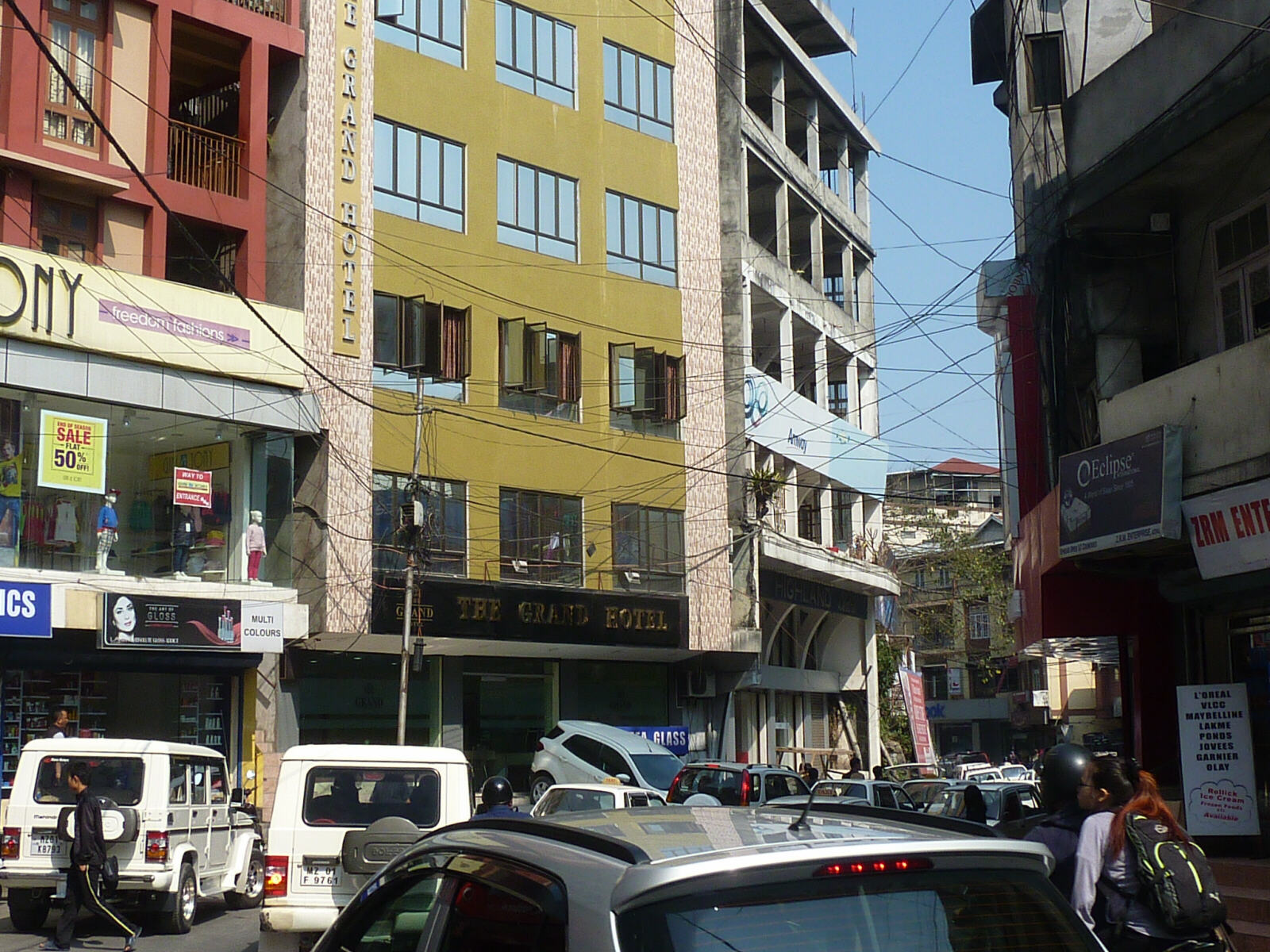
|
Tues 16th. Our sightseeing tour of Aizawl involved walking up and down the main road a bit. First we walked along to Sumo point to book seats in a sumo (shared jeep) for this afternoon. In the booking office was a cardboard box full of cute puppies, waiting to go for a ride. Then we walked up to the other end of town and found a small post office down a flight of steps and posted a letter. We spent the rest of the morning on the complicated process of buying an Indian SIM card for the phone. When we went to get the jeep the box of puppies was closed up but Sheila wouldn’t let them put them on the roof where they would have been boiling in the sun then freezing when it went dark. At 1pm we left and the jeep raced down the mountain, swinging from side to side round the bends. We passed the site of yesterday’s landslide where the road was still covered in earth and big diggers were moving it away. Most of the roads were good but on the occasional rough patch clouds of dust flew in through the open window. We raced along a ridge-top inches away from huge drops down to the mist-filled valley below. It was an interesting ride but rather cramped in the two front seats and the driver couldn’t change into second gear because my leg was in the way. The jeep wasn’t full so he moved the passenger in the second row over and suggested I sit there which was better because I could brace myself round the corners. Of course we hadn’t been going long when the driver had to stop for a glass of tea. Fuelled by some sort of green leaves he was chewing the driver accelerated to even greater speeds. He was lucky, he could hang on to the steering wheel but we didn’t have much to brace against. At one point a man and a boy got in and as soon as we started swinging round the bends again the boy started being sick into a plastic bag and continued until they got out just after we reached Assam and the road straightened out. |
Silchar, Assam state
|
Despite all this we enjoyed the ride until it got dark and we crawled the last few miles into the suburbs of Silchar in a traffic jam. The jeep came to its terminus beside a cluster of auto-rickshaws and we went in one of them to the Borail View Hotel, a big old place which could be nice if it employed an army of cleaners with vats of bleach and Jif and a redecoration team. Sheila was thrilled to find our room had a bathtub, but looking closer we saw you’d be dirtier when you got out than when you got in. We went unwashed for a day! We were soon in the restaurant and had some much-needed beers and a very tasty meal, including an extremely tasty boneless Handi chicken (we have learned always to ask for boneless and not too many chillies). Nearby a large table of students having a pleasant dinner suddenly started arguing and fighting and one was thrown against the curtain and smashed a big window. I had to restrain Sheila from joining in – she thinks she can save the world.
Wed 17th. We got a rickshaw to the shared taxi office to book a taxi to Imphal but found that the road was closed and no taxis were running. Some said it was because of a ‘demonstration’, others because of attacks by insurgents, or it could have been a landslide, who knows? So rather than wait we decided to go a long way round and booked an overnight bus to Dimapur in Nagaland. We spent the rest of the morning walking back to the hotel via markets and phone shops. We had a very tasty late lunch in the hotel (the same as last night’s dinner but without the beers) then sat in reception reading until the swarms of mosquitoes drove us back into the restaurant and we waited there until it was time to get a rickshaw to the bus stop. We sat on a bench over an open sewer outside the bus office as Silchar shut up for the night and large lorries, which are only allowed through at certain times, thundered through the town. The bus finally arrived two hours late at 10pm. Once everyone had settled down it was an unexpectedly comfy ride, with nice big reclining seats with arm rests and lots of leg room. We had come prepared for the cold and were really cosy and the bus rode easily over the appalling road surface. Of course there were several tea stops, cigarette stops, men with weak bladder stops and in the middle of the night in the middle of nowhere we stopped at a truckstop restaurant shack where all the bus passengers except us tucked into huge plates of rice. |
Kohima, Nagaland state
|
Thurs 18th. We must have slept quite a bit because in no time the sun came up and amazingly we arrived in Dimapur feeling relaxed and rested. We got a town taxi to another taxi stand which the shared taxis to Kohima depart from and we bought tickets for the three seats in the middle row in the next taxi. In no time our baggage was loaded on the top, the other seats were filled and we were off. The bus ride had been fairly flat but now we were in the hills and weaving from side to side round the corners again, but he was a good driver and we enjoyed this ride too. Along the way we liked the safety signs put up by BRO (Border Roads Organisation) such as: Drive Slow see scenery drive fast see cemetery, Be alert accidents hurt, Travel light but not at the same speed, The trouble with drinking and driving is the mourning after, Hug your kids in the house then belt them in the car, Don’t stick your elbow out too far or it might go home in another car and Open defecation is a curse (not a lot of people know that!).
Dimapur is in Nagaland but the first checkpoint seems to be halfway to Kohima and there we stopped for our details to be entered into another big ledger. Kohima is another town built along, up and down precipitous hills with great views from every vantage point. We got a local taxi (there don’t seem to be any auto-rickshaws, maybe the hills would defeat them) to the Heritage hotel, a former District Commissioner’s bungalow with high-ceilinged, wooden-framed rooms and verandahs furnished with armchairs for relaxing and admiring the view. The bathroom was large, light and airy and also timber-framed, but when you stood in the roll-top bath to shower it rocked from side to side, plus the wind was blowing in through the broken windows. Also, both mornings we noticed an odd thing: the soap which had been on the washstand ended up on the far side of the room and appeared to have teeth-marks in it! |
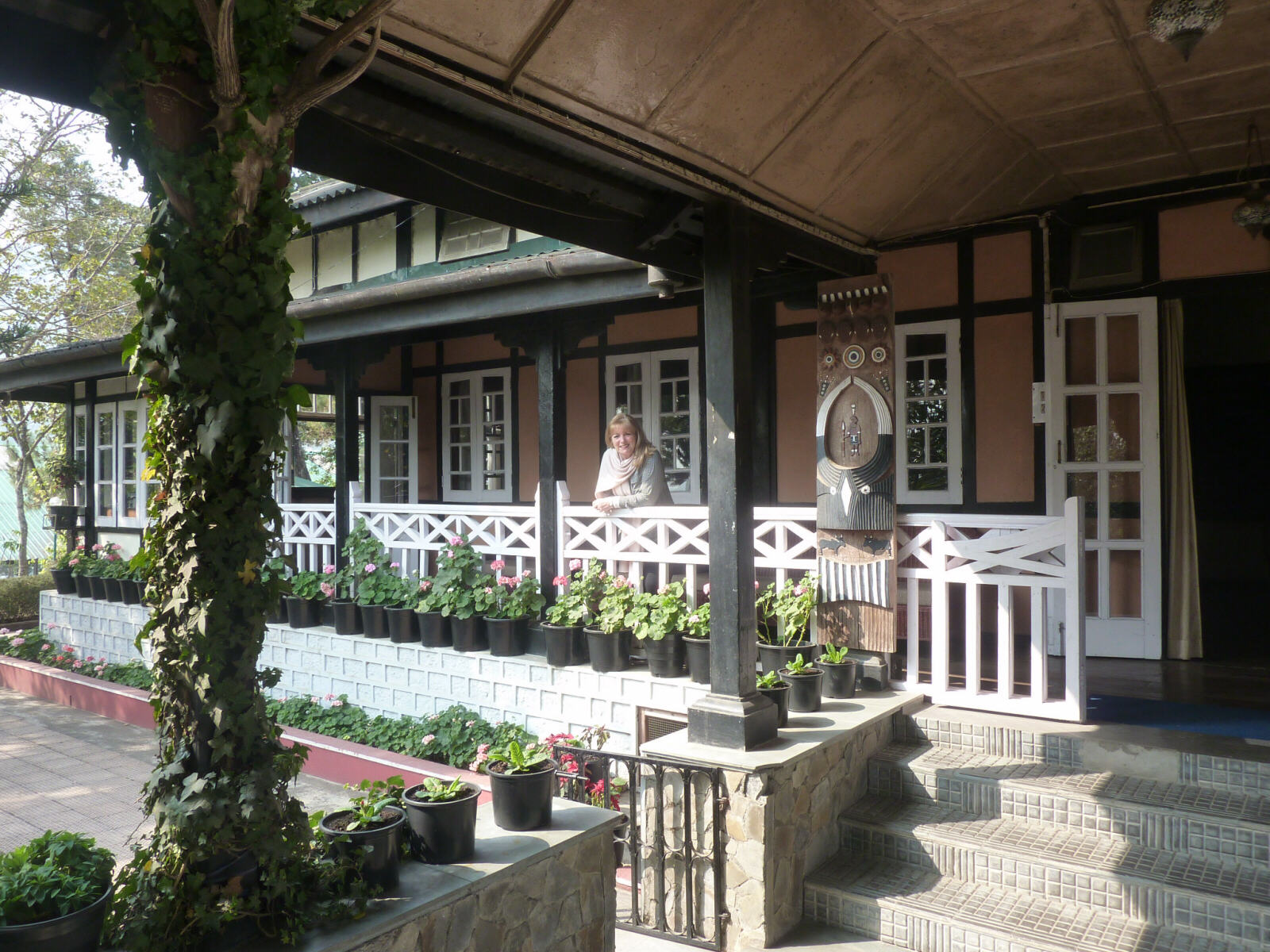
|
It was now about 1pm so we went straight for a late breakfast/brunch of pakoras and butter chicken (on the bone unfortunately, we forgot to ask) in the dining room set in one of the verandahs. |
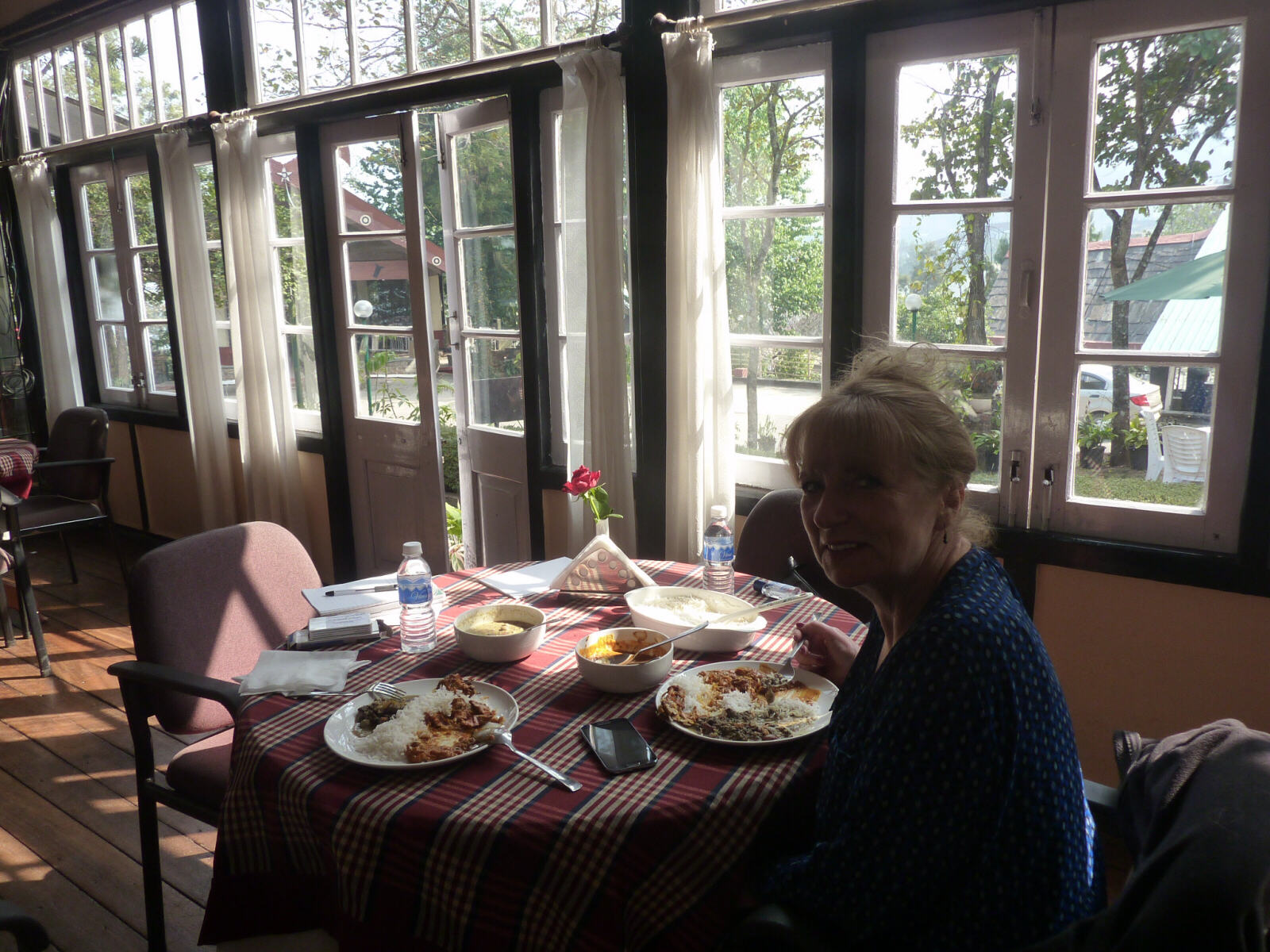
|
I went for a walk round the nearby part of town and by a stroke of luck found the Ministry of Tourism where they gave me a nice map of the town. Back at the hotel, the restaurant closes at 7pm (and everything outside in the town closes even earlier) so we went and had a couple of (pre-ordered) locally-brewed, strange-tasting Foster beers and some pakoras and spring rolls for dinner and called it a day. We were up in the hills and it was freezing; the warmest room was our bedroom which had two halogen heaters, each with one bar working. Sheila couldn’t even do her heat-seeking missile act because we had separate beds. She went to bed with socks, tights, thermal vest, a fleece and a scarf. We must invent something to keep that nose of hers warm.
Fri 19th. We set off for a day’s sightseeing. A nice taxi driver took us to Kisama Heritage village, an open-air museum of traditional Naga houses with elaborately carved portals and huge hollowed-out drums. There was nobody there and some of the houses were locked but it was very pleasant and picturesque to wander around.
|
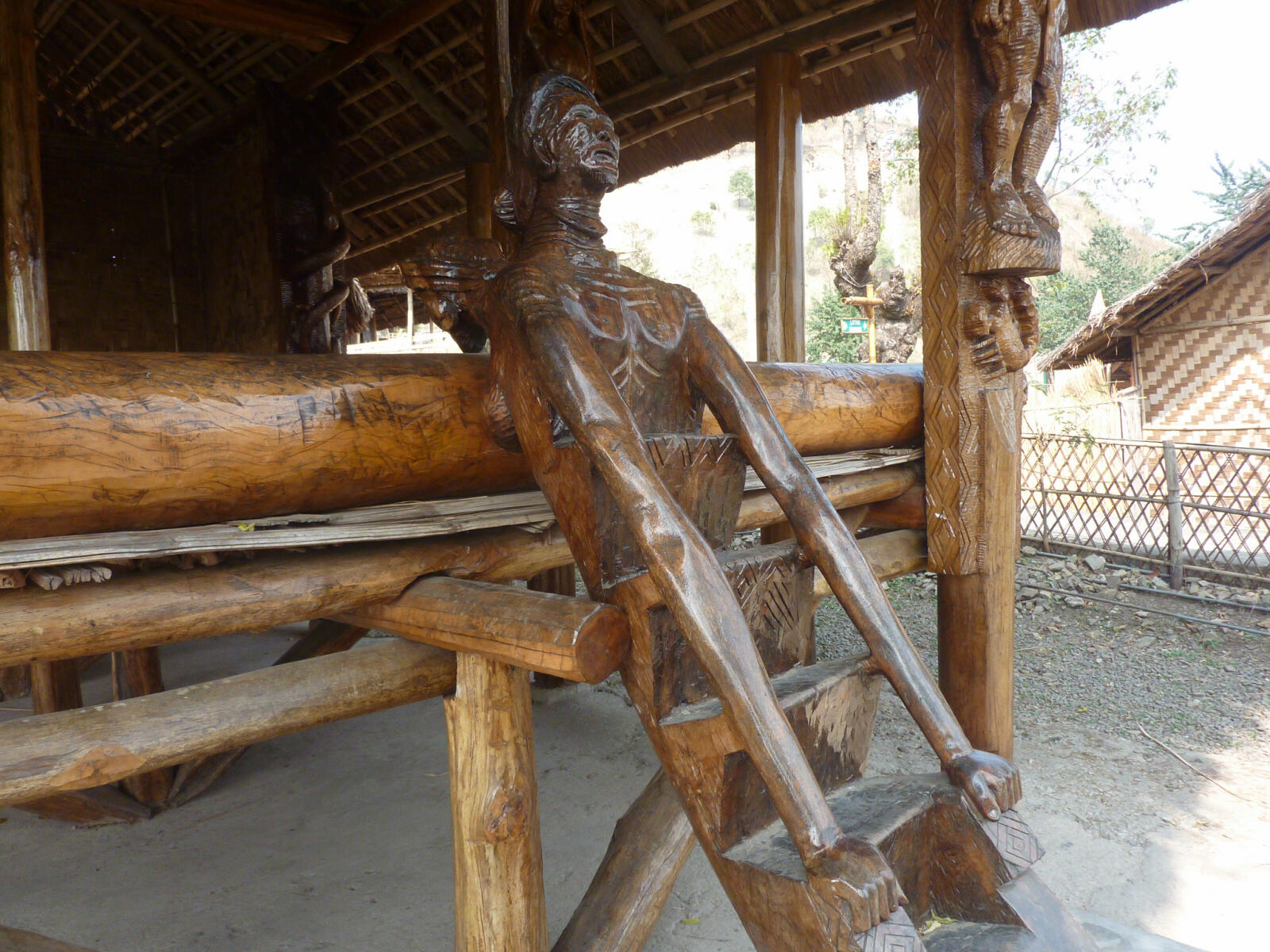
|
On the way back we went into the big modern Catholic Cathedral built on one of the many hilltops so that you can see it from everywhere. From the hotel we walked down the hill to the immaculately-kept war cemetery and walked up and down reading the very moving inscriptions for all the soldiers, killed mostly in April and May 1944 in the battle that halted the Japanese advance into India. |
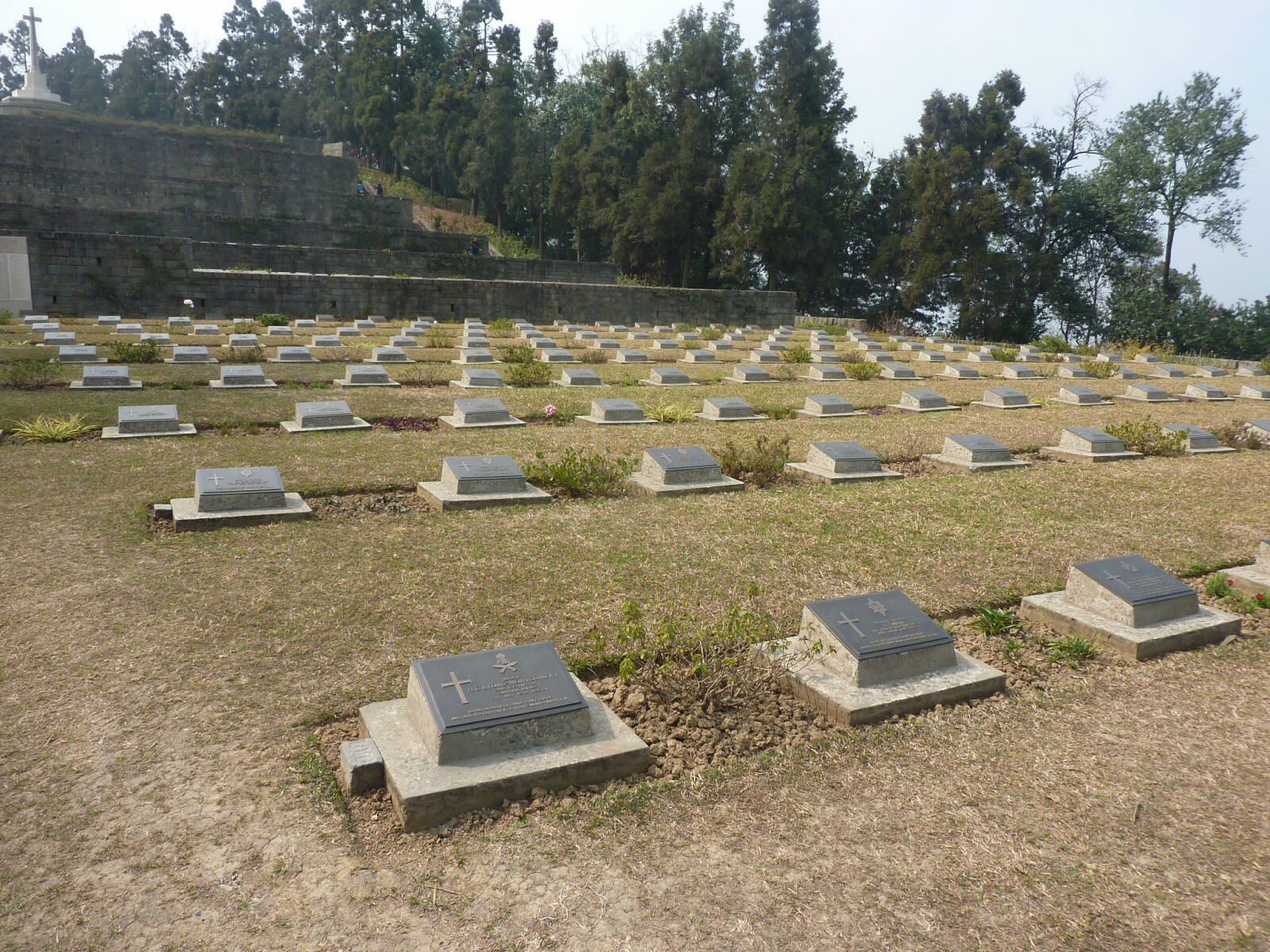
|
We walked up and down the main street a bit then went by taxi to the big modern Japfu hotel which someone had recommended, but it was a cold, soulless place and the restaurant was closed for a wedding party so we walked back to the hotel buying chocolate cakes for our afternoon tea on the way. Kohima shuts up early so we read for a while then had another nice snack dinner and an early night. |
Imphal, Manipur state
|
Sat 20th. It’s funny how things work themselves out in India. All yesterday we asked all sorts of people if we could get a taxi all the way to Imphal in Manipur state and they all said not possible because of the paperwork, you have to get a shared jeep to the border town called ‘Mao’ then a different shared jeep from there. The driver who took us to the heritage village yesterday said he would ask a friend if he could take us by taxi to Mao and he’d let us know, but we didn’t hear any more about it. So after breakfast this morning we checked out and asked for a taxi to take us to the sumo stand for Mao (every destination has a different stand). The taxi arrived and the nice hotel man said ‘he will take you to Mao’ – that’s good, we thought, but the taxi driver said no, he’d take us all the way to Imphal! It turned out he was the friend of yesterday’s driver. Normally the fee would be £50 plus £10 for ‘one way’ trip (in lieu of the return fare) but he dropped the extra £10 and we thought it was a worthwhile luxury and set off. He was a good driver and the road was good in parts, except for the lengthy army convoys with hundreds of soldiers and jeeps with mounted machine guns travelling in both directions who held everybody up. We arrived in Mao in Manipur state where there was a checkpoint but our driver just drove straight past it, so this time we didn’t get written into the dusty ledgers. The first part of the journey was the usual winding road through hill country but then the road flattened out in a wide, long valley full of rice paddies and villages of bungalows with corrugated-iron roofs. The hills were quite bare of trees and everything seemed drier and dustier than usual, but we are four or five months into the dry season so I suppose that’s normal. Imphal, the state capital, seemed flat and sprawling and bigger than the last towns we’d been to. We had been recommended to stay at the Classic hotel which was very nice and clean. Sheila upsold us to a deluxe corner room with lots of space and a nice view out of the window. The hotel is quite centrally located opposite the north wall of the Kangla fort in the centre of the city. I had a bit of a walk round and a cappuccino in the café in the hotel. We got all unpacked and sorted out, had a load of laundry done for a remarkably cheap price and went for dinner in the restaurant – I had the weekend buffet and Sheila had delicious Thai crispy lamb.
Sun 21st. There was a general strike today, organised by the Maoists in protest at some government outrage, so everything was shut up tight; no shops, no tourist sights. We had a lazy morning then went for a walk to the only ‘sight’ that was open as usual, the War Cemetery for those killed in the battle for Imphal in 1944. We walked up and down more rows of plaques with moving inscriptions amongst the groups of local teenagers picnicking among the gravestones. We spent the afternoon sending emails from the ‘business centre’ in the hotel, which was a single computer in a corner, but it was easier than doing it on the smartphone. That evening we were the only people in the hotel’s restaurant but we had a wonderful meal, I had the special Manipuri thali, pre-ordered yesterday, with seven different spicy vegetable dishes and a bowl of rice on a copper platter lined with a banana leaf, and seven more little dishes made of banana leaves cleverly folded into little boats with more tasty spicy dishes in them. Sheila had a tasty egg curry and onion kulcha. |
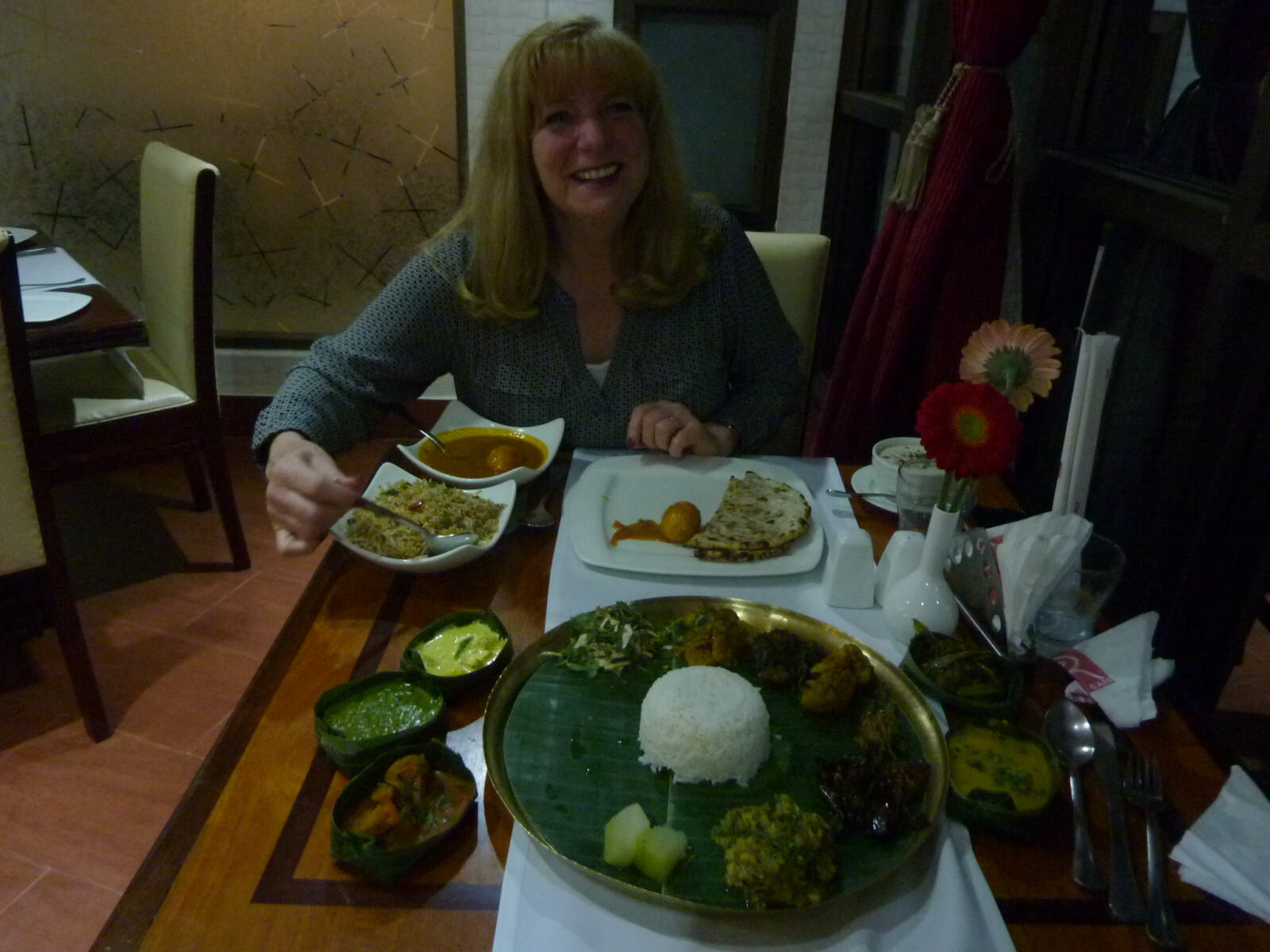
|
Mon 22nd. We went out for a good day’s sightseeing in Imphal. Everything is a bit spread out so first we got an auto-rickshaw to the Ima market (women’s market). As we approached down the street it didn’t look much, but then we found that it spread out over a large area of open ground and covered market halls, full of fascinating local ladies selling all sorts of colourful vegetables .... |
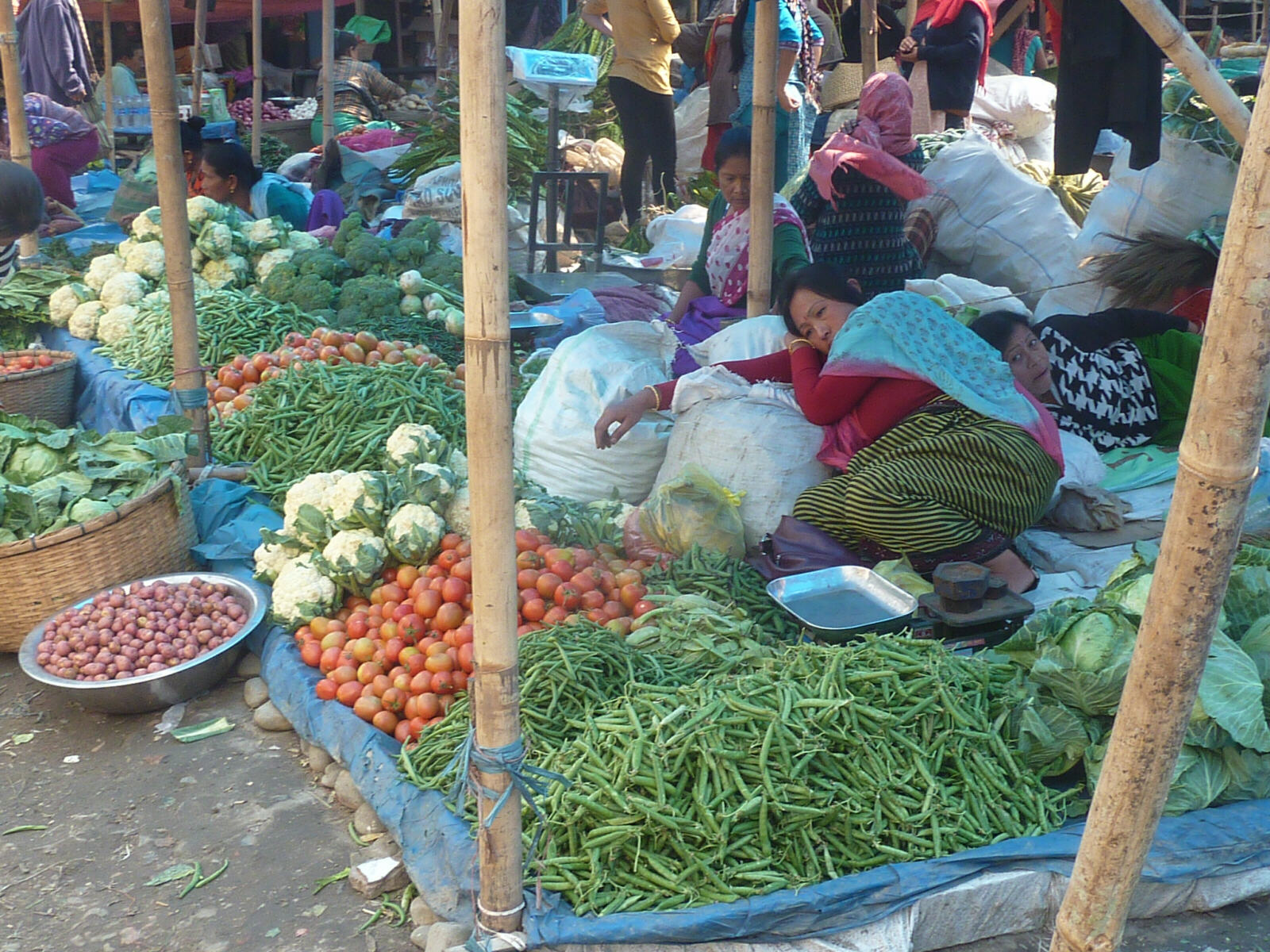
|
.... arguing over long strands of some sort of beans ....
|
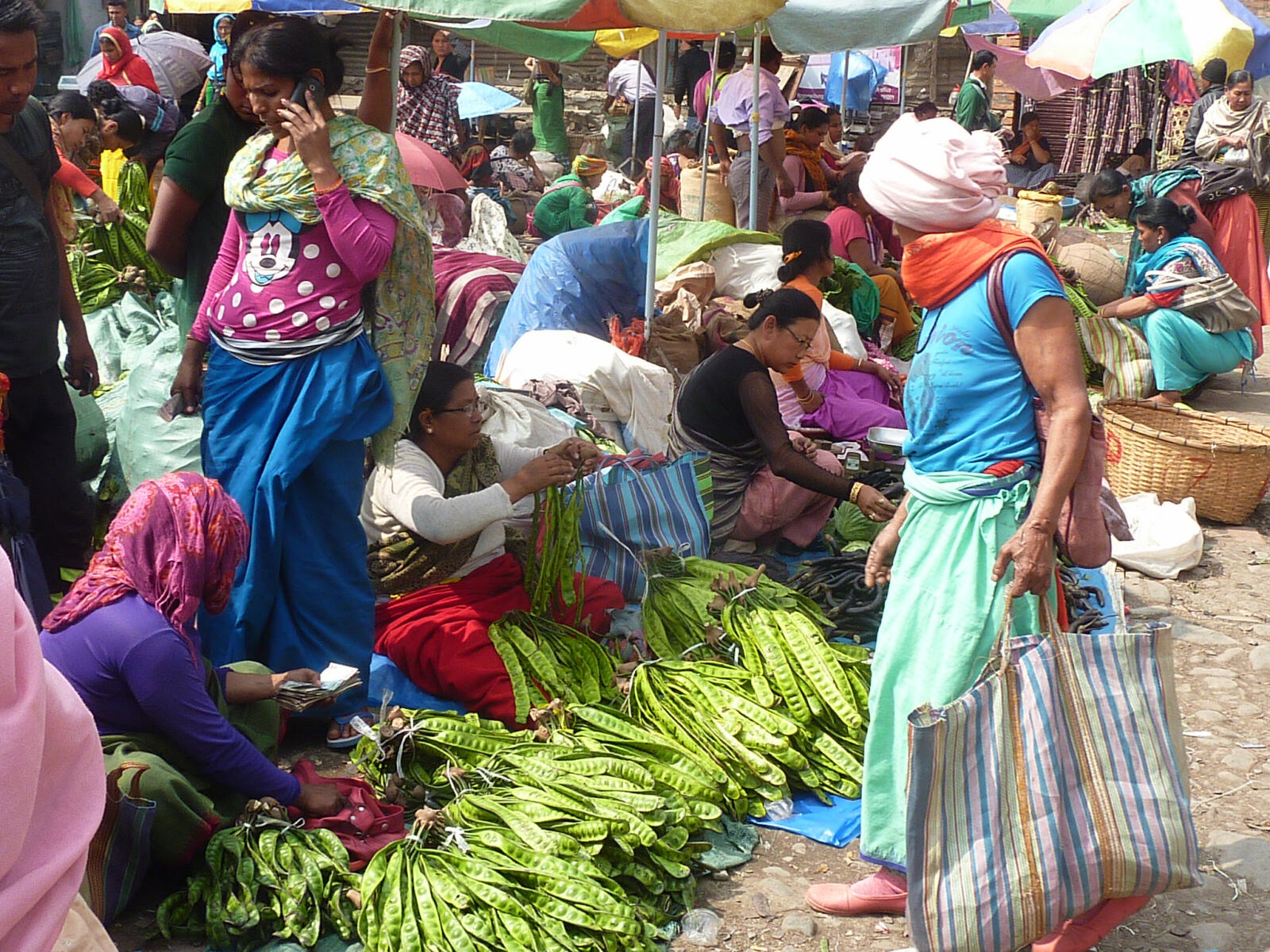
|
.... and cooking up something that looked like fish heads in oil at little café stalls (we didn’t bother to try them, we were too full from breakfast, and even if we hadn't been full ......).
|
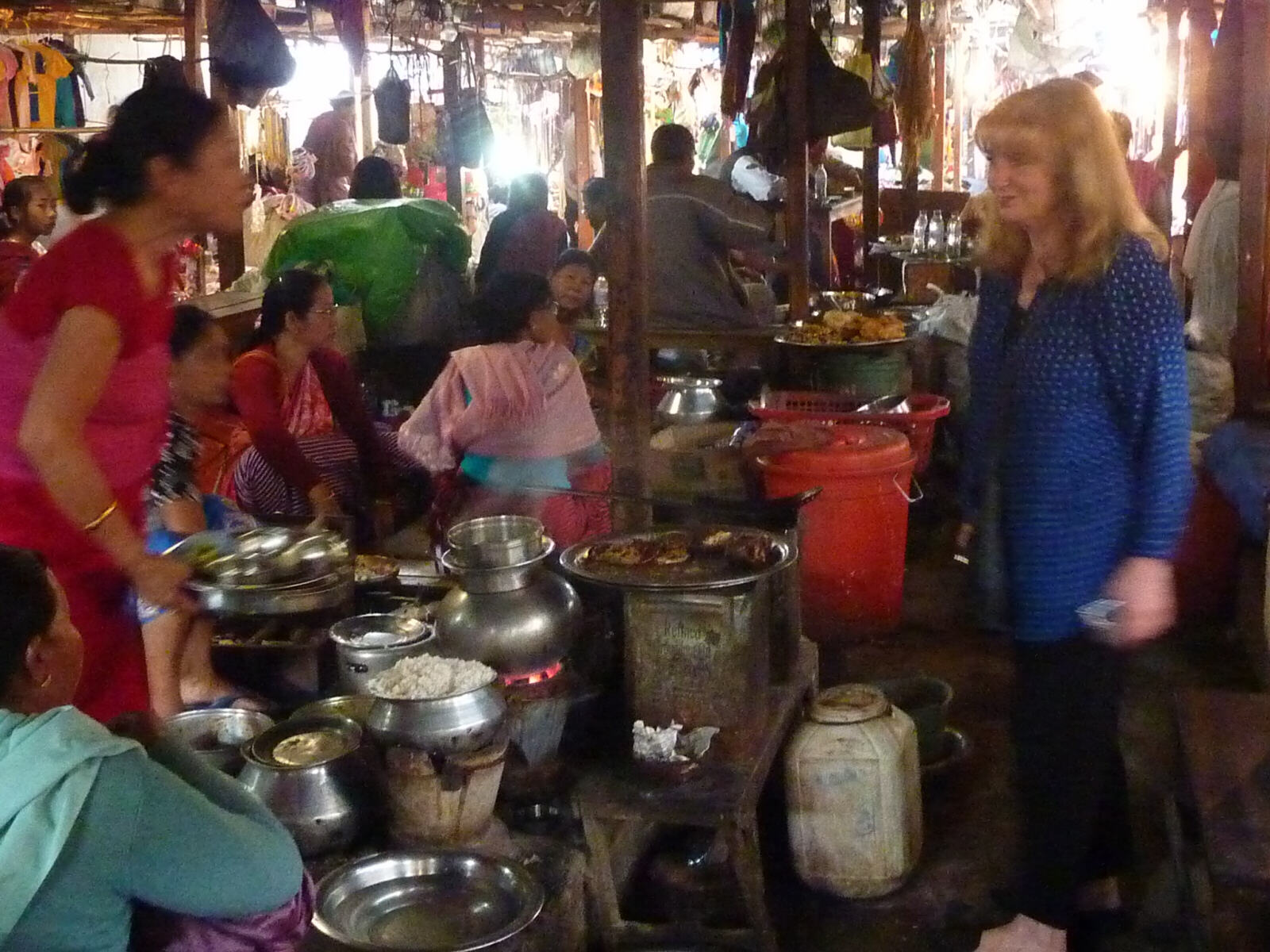
|
Imphal is a long way from the sea, yet there were a lot of fish. |
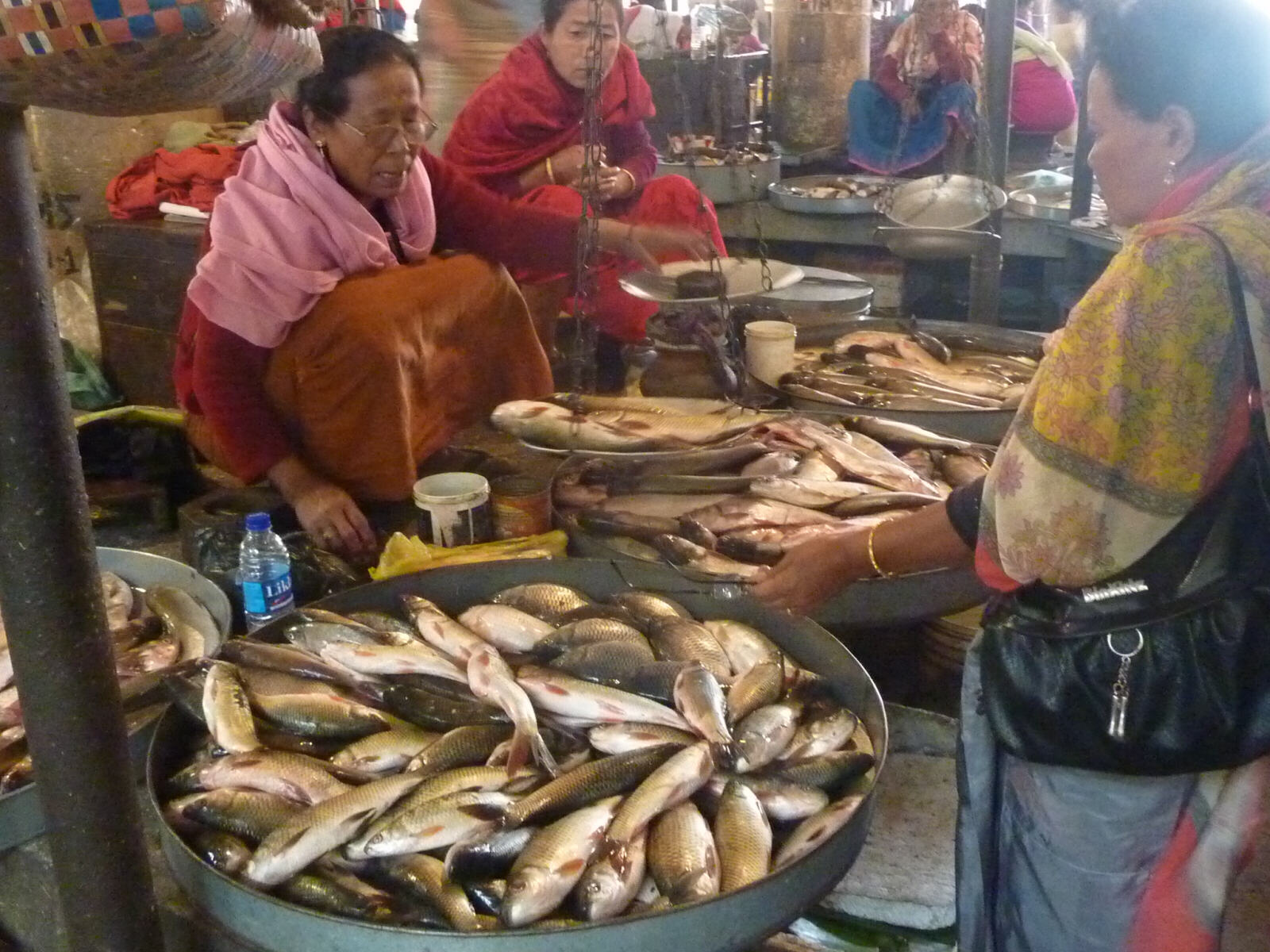
|
After walking round for some time we walked up to the main road and got a rickshaw to Govindajee temple but this was rather disappointing. The historic old temple building was locked up and a nasty old lady shouted at us for walking on the platform round it (at least we thought that's why she was shouting, it was hard to tell), a man with a megaphone blasted us unintelligibly, the modern building was bare and uninteresting and nearby workmen were making an awful din demolishing a small building in the grounds. Again we walked back to the main road but had some difficulty finding a rickshaw because they were all full. Eventually a smartly-dressed policeman flagged a shared rickshaw down for us, told the driver where to stop and told us to only pay him 10 rupees (10 pence) each. If in doubt, ask a policeman with a gun to help you! Our final stop was Kangla, the fortified complex at the centre of Imphal and the centre of Manipur history. It is a large, square complex with moats and walls 1 km long on each side, so just inside the gate we hired bicycles for 20p per hour each, and set off down the straight, flat road through the centre of the complex. |
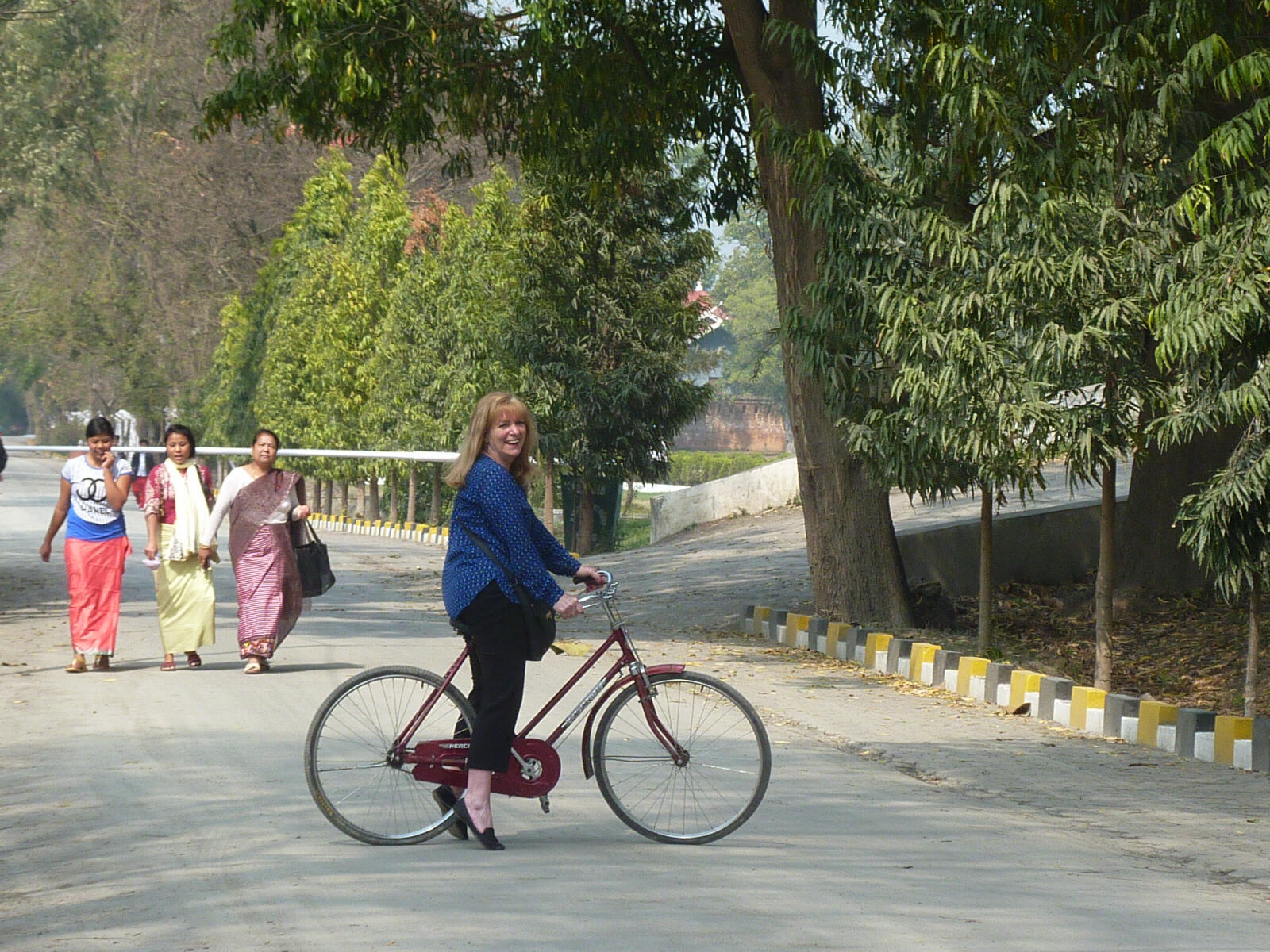
|
There were temples, including an interesting red-brick complex partly restored and set in a nice garden, and British-era bungalows including the one that was Field Marshal Slim’s HQ during the war. Once again all the auto-rickshaws were full and we had to ask a soldier to commandeer one to take us back to the hotel – he stopped one for us with the help of his big stick! |
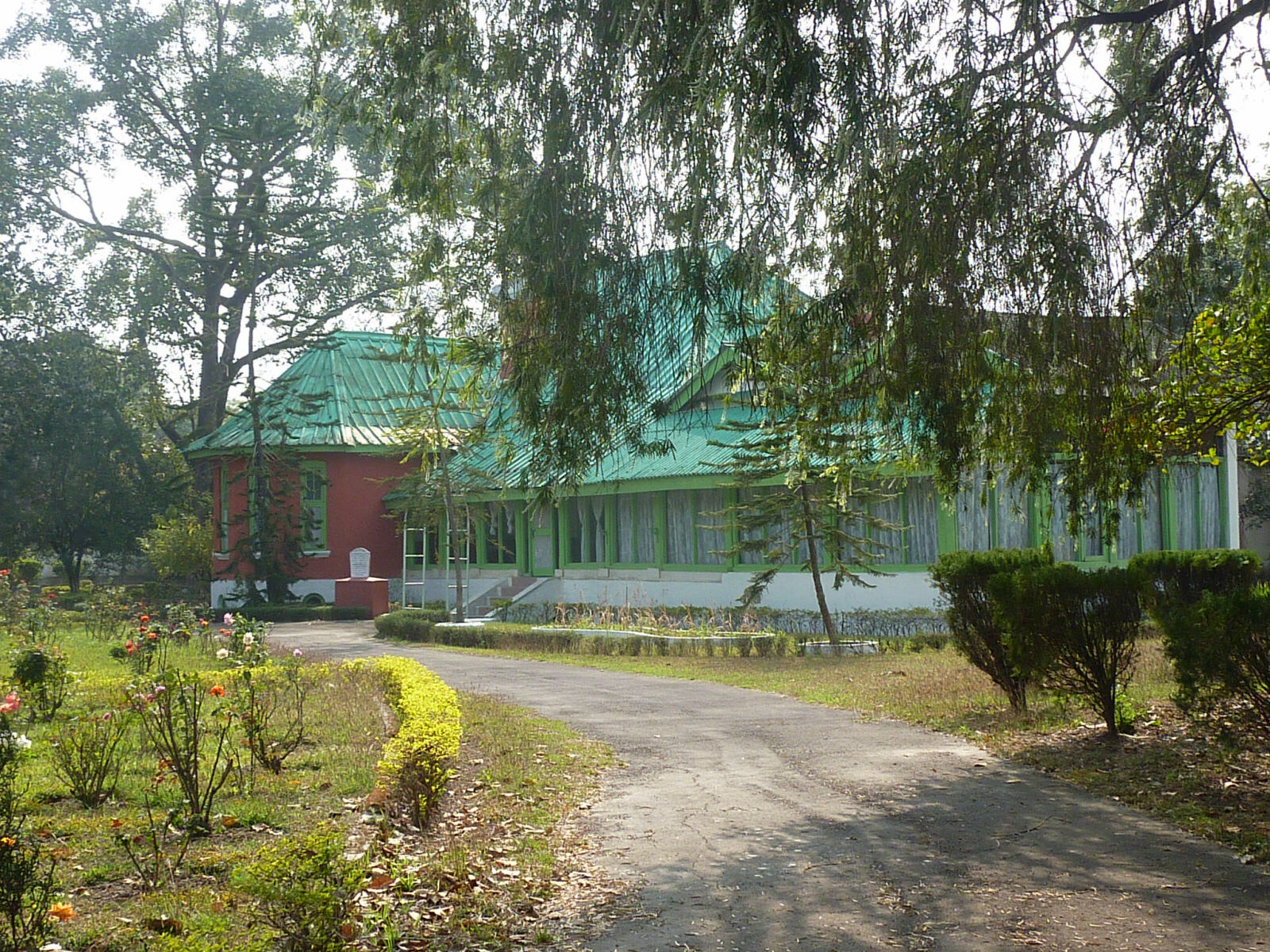
|
Dimapur, Nagaland
|
Tues 23rd. We got a ‘winger’, a 12-seater small bus the size of a transit van, to retrace our steps through Kohima to Dimapur. The winger should have been quicker and more comfortable than the bus but our driver was completely incompetent – he had no anticipation and was constantly surprised by obvious obstacles, and no spatial awareness and was constantly wrenching the steering wheel this way and that to make unnecessary jerky maneuvers. Sheila was in the front, a bad idea when the driver has no skill whatsoever, and as she peered over the edge of bottomless cliffs she kept saying “Jesus wants me for a sunbeam”! We had only been going for half an hour when we stopped at one of the dreary coach-stop cafés and we all had to wait while two passengers had their plates of rice. We got going again and immediately stopped for petrol, even though the tank was already three-quarters full. We actually got going for a couple of hours before a loud slapping noise made it clear that one of the tyres was disintegrating. It was obviously a shoddy retread and the top surface was just peeling off. The driver changed to the spare tyre and we went another half an hour before the spare went completely flat. Undismayed, he cut the loose flap off the disintegrating tyre and swapped it back, and amazingly it got us to Dimapur. We went to the Acacia hotel and at first were rather disappointed but when we realized the room only cost £13 we decided it wasn’t so bad. The hotel’s restaurant had been entertaining a huge party of guests but once they drifted away we had it more or less to ourselves and we had an extremely tasty meal of pad-thai noodles, garlic vegetables and sweet chilli chicken (very spicy, more chilli than sweet!) |
Jorhat, Assam
|
Wed 24th. After breakfast we walked the short distance up to the railway station and caught the 10:45 Jan Shatabdi Express train to Jorhat, which departed exactly on time, to the minute. The Jan Shatabdis are the luxury class express trains on Indian railways and it rocked along at a fast pace (far faster than the cars or buses we’ve been in) while we relaxed in our comfortable reclining seats with lots of legroom and tea and snack sellers walked up and down. In Jorhat we got a room overlooking the street at Jura Palace hotel (not bad for £16 but we nicknamed it the mothball hotel) and went to their restaurant for a tasty lunch of vegetarian curries and onion kulcha. I walked around the town and found the tourist office but they didn’t have a street map of Jorhat, and the MD Continental hotel, which looked similar to ours but had a bar as well. In the evening we went to the bar at MD Continental and had tasty pakodas with a Kingfisher beer and some glasses of Nine Hills red wine from Nasik (first wine for three weeks). |
Majuli Island, Assam
|
Thurs 25th. At 9:30 the taxi took us a few miles out of town to the ferry ghat on the Brahmaputra river. The upper deck of the small wooden ferry was crammed with cars and motorbikes .... |
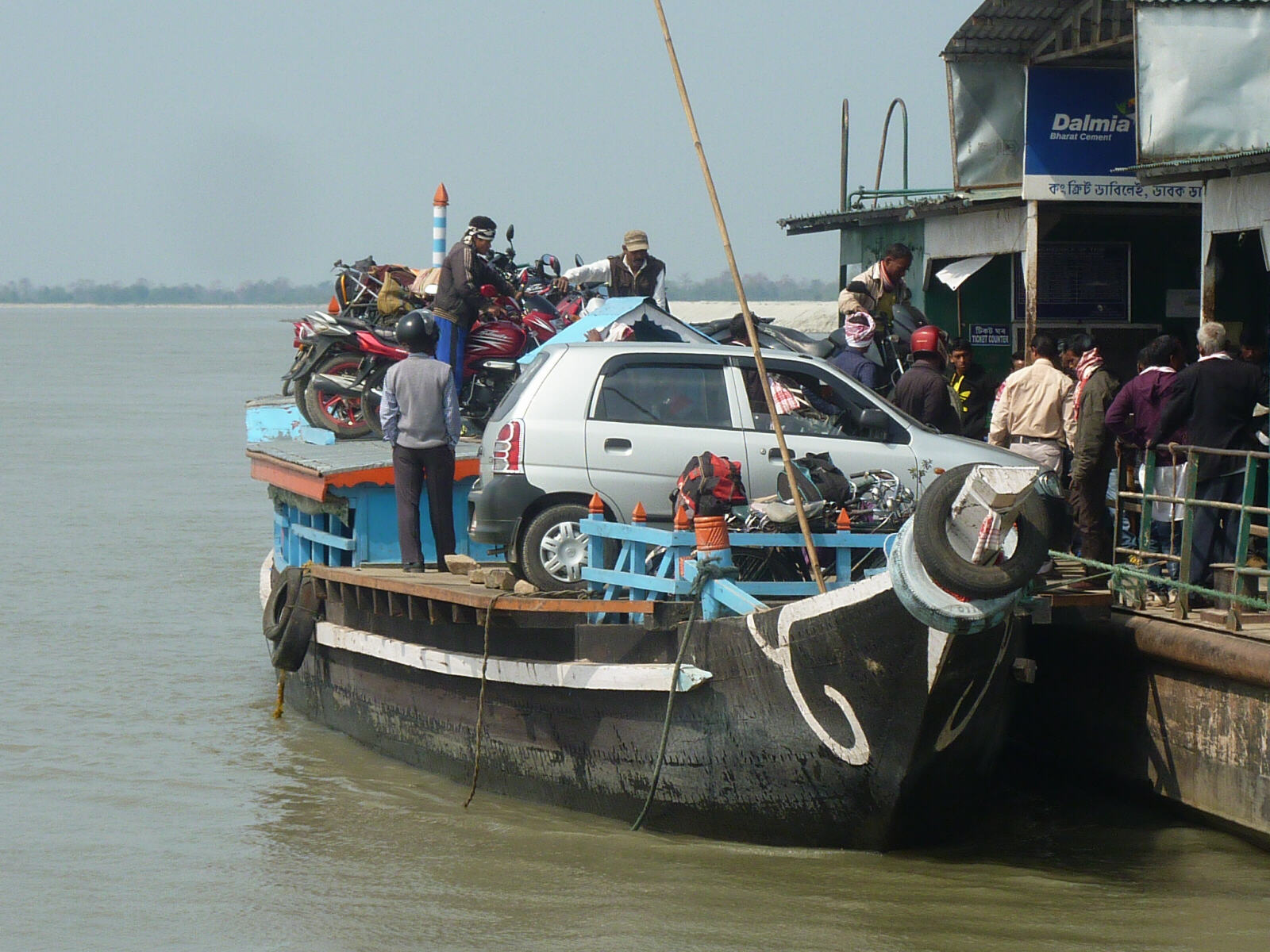
|
.... and the deck below was crammed with people sitting on benches the length of the cabin. It appeared completely full but people beckoned us in, shuffled about and a couple of places magically appeared.
|
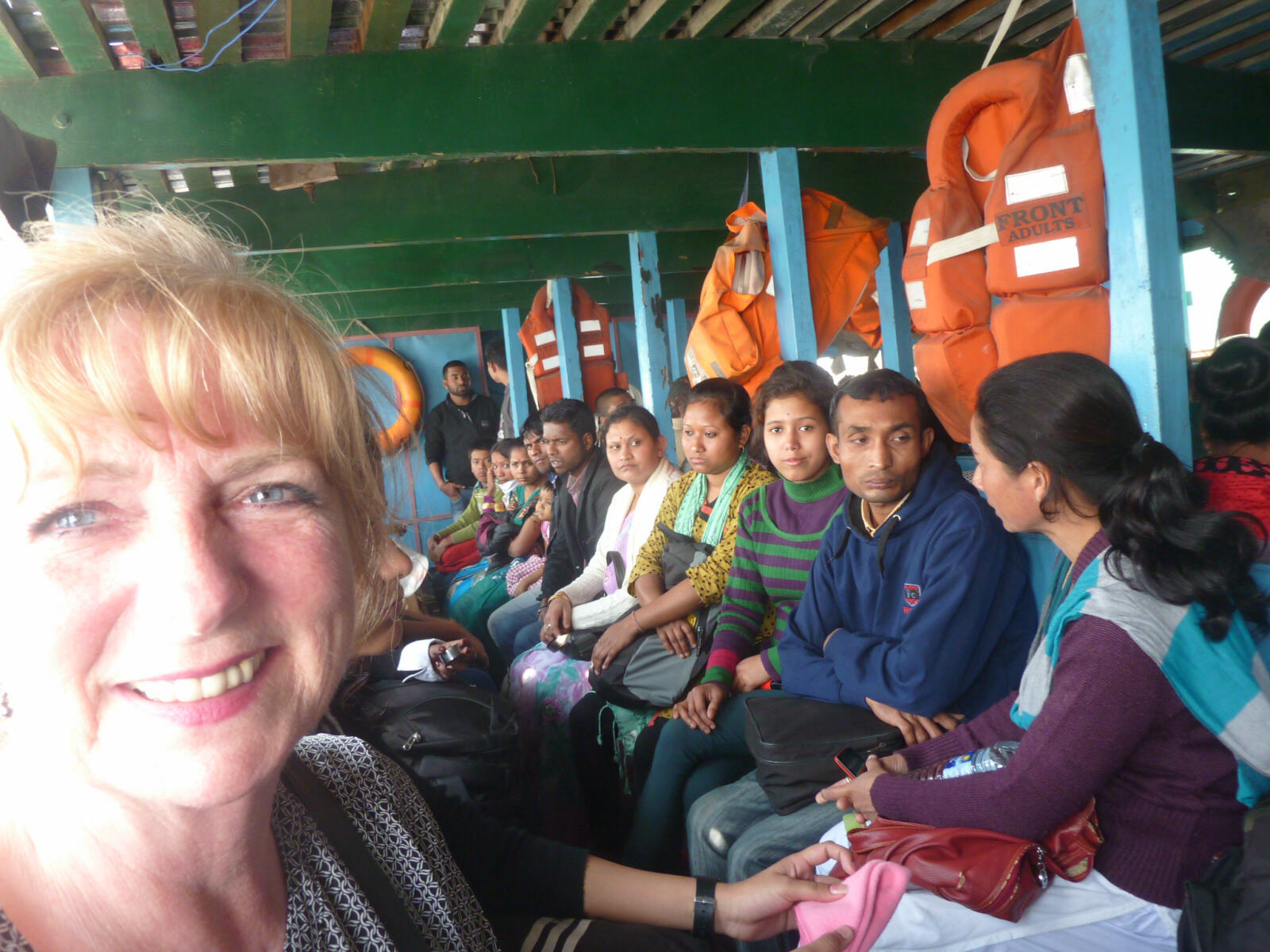
|
We set off and chugged for nearly an hour along the wide Brahmaputra river with low sandy banks on each side, then arrived at a similar ghat on the other side, where we disembarked onto Majuli Island, the biggest river island in the world. The people at the hotel in Jorhat had arranged a car and driver to take us on a tour of the island and he met us from the ferry and took us down long roads to what seemed like all four corners of the island, past villages and endless fields full of cows with their attendant egrets. |
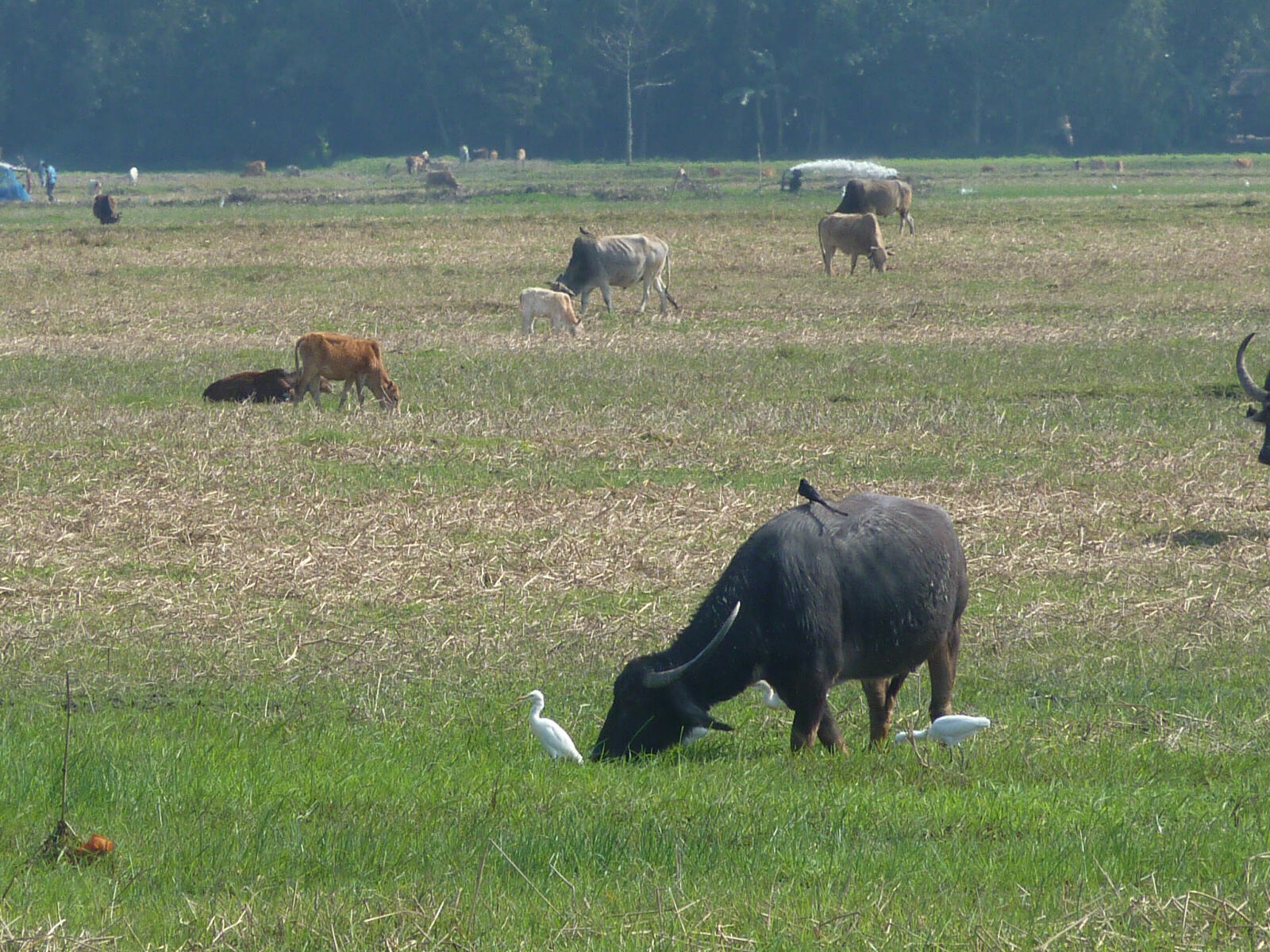
|
We visited two satras, very old and historic Hindu shrines with colourful images and at one of them a party of pilgrims caught up with us and performed their puja in front of the idols. We also visited a mask-maker who had lots of the colourful, scary masks all over his wall, and pictures on his phone of the many tourists who’d visited him from all over the world. About 3pm we ended up at Dekasang ‘Resort’, a picturesque two-storey bamboo ‘bungalow’ beside the other branch of the Brahmaputra, where we will stay tonight. We wandered around taking photos then sat on our bamboo balcony outside the room overlooking the river, listening to the jungle noises in the peace and quiet, and enjoying the pollution-free and dust-free air. |
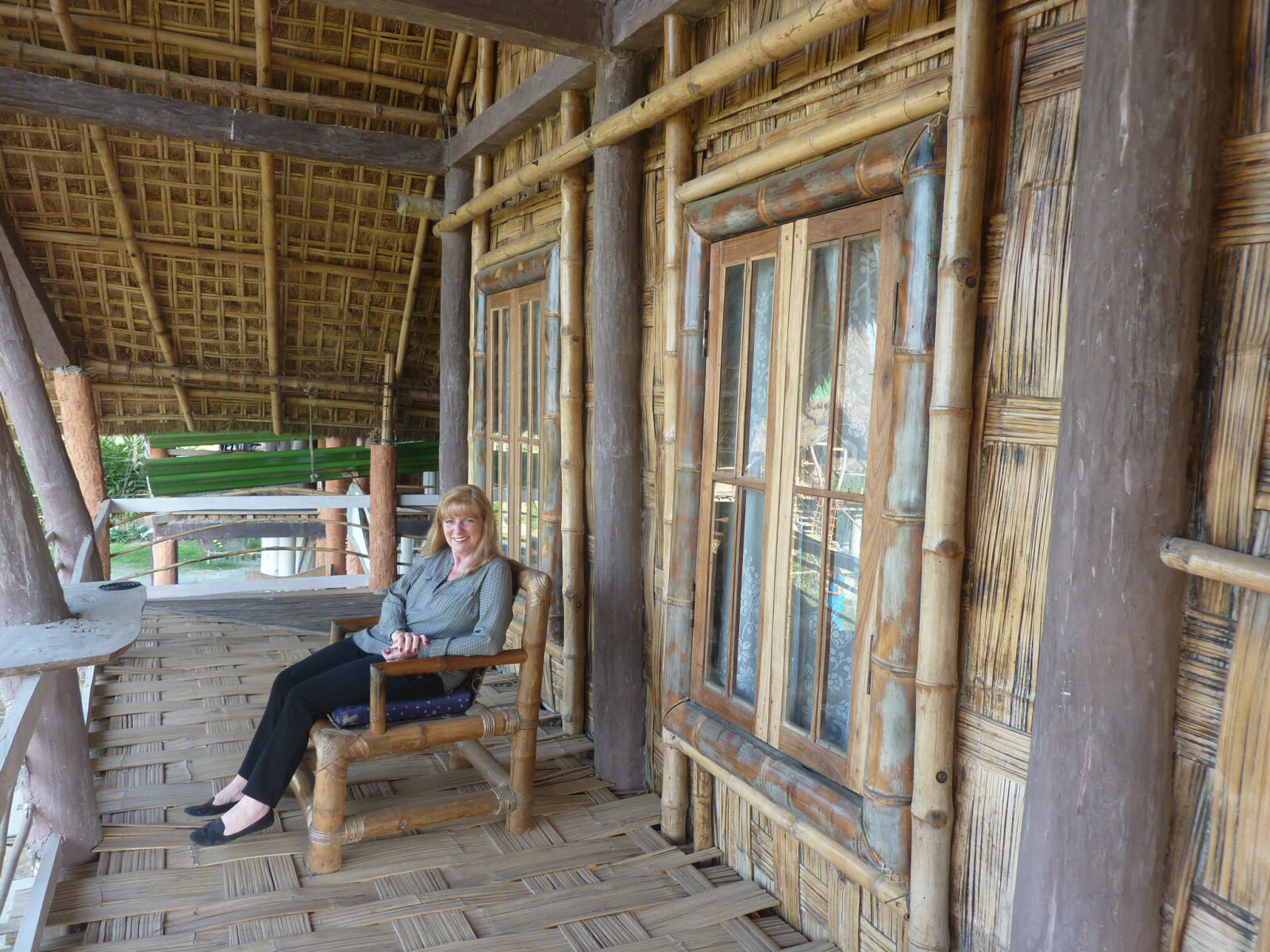
|
They called us for dinner just after it went dark and we sat on the verandah outside the little kitchen bungalow, having an amazingly tasty selection of six or seven vegetable dishes and chutneys, with all the ingredients freshly picked from their garden.
Fri 26th. We slept really well in the comfy bed under the huge mosquito net and it was still wonderfully peaceful in the morning, with the calls of the tropical birds as they pitter-pattered about on the roof of our bamboo hut. At 7:30 our ‘wakeup call’ was a cup of tea brought to the room, then we had breakfast sitting at the tables outside the kitchen in the morning sunshine. The ferry ride back to the mainland took much longer (1½ hours) than the journey here because we were going upstream, but it was very pleasant chatting to the other passengers including a monk from Majuli and several college students going to school on the mainland. I had a samosa chaat for lunch and chocolate cake for afternoon tea, one after the other at the MD sweet stall/café, then before long it was time to go back to the bar at MD hotel for glasses of wine and tasty pakodas for dinner. |
Sivasagar, Dibrugarh and the Burma Road in Ledo, Assam
|
Sat 27th. After breakfast in the room our car was waiting and we set off for Sivasagar an hour down the Assam Trunk road. We went to a former palace and a two-storey grandstand where the 18th century kings used to watch the games in the surrounding arena, then to Shivadol Mandir .... |
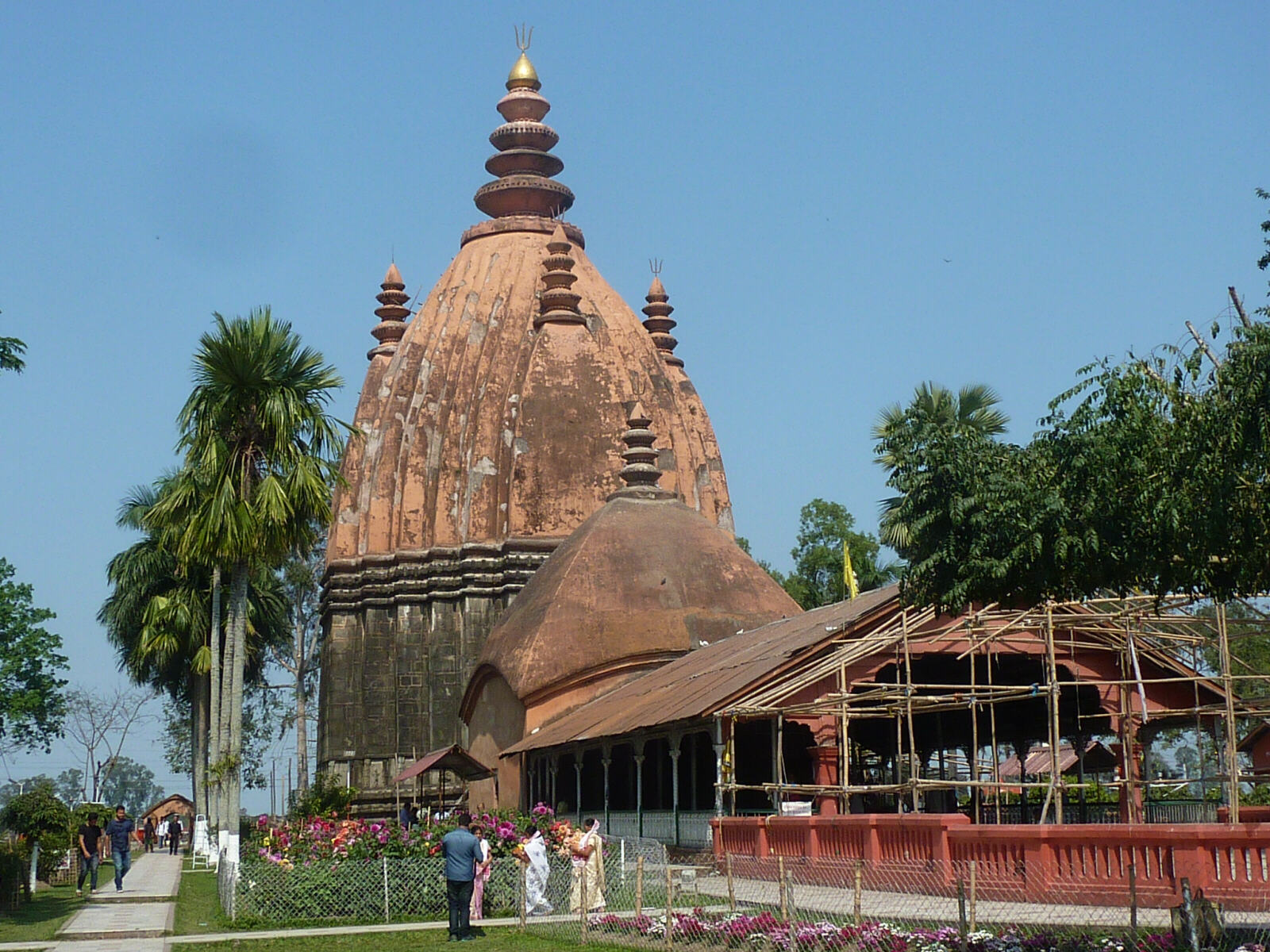
|
.... the most genuine and fascinating Hindu temple we’ve been to, where nobody asked for money and the resident priest was friendly and welcoming ....
|
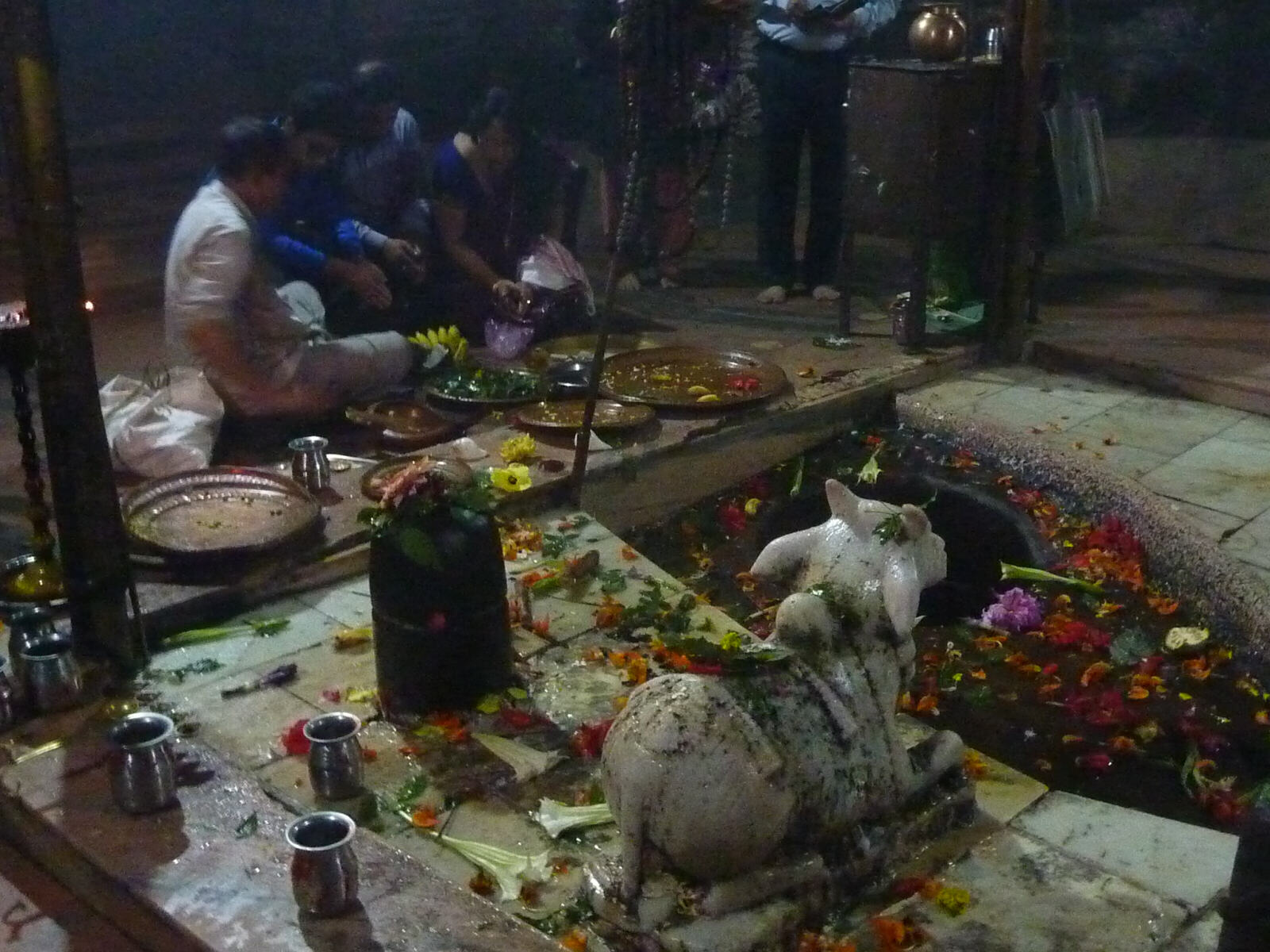
|
.... as worshippers were making offerings and breaking coconuts and pouring the milk over Shiva’s lingam in the inner sanctum.
|
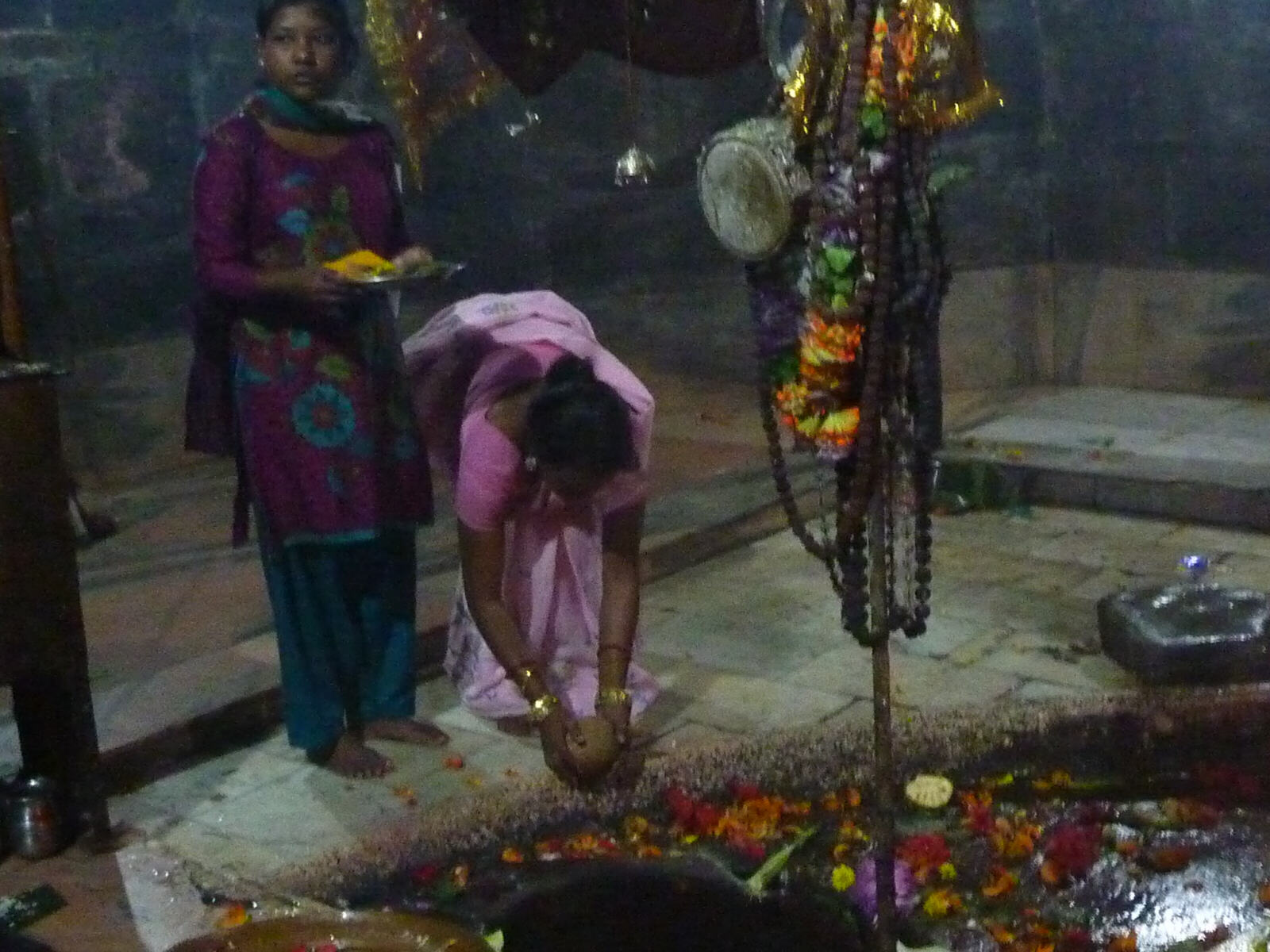
|
We carried on down the road and stopped at a chai house/sweet shop/café where we had an aloo dosa and a couple of chais. Then we carried on and arrived in Dibrugarh where we had booked into the Club House, which was the hotel attached to the Gymkhana Club with a nice clubhouse (built in 1924), restaurant and well-stocked bar. |
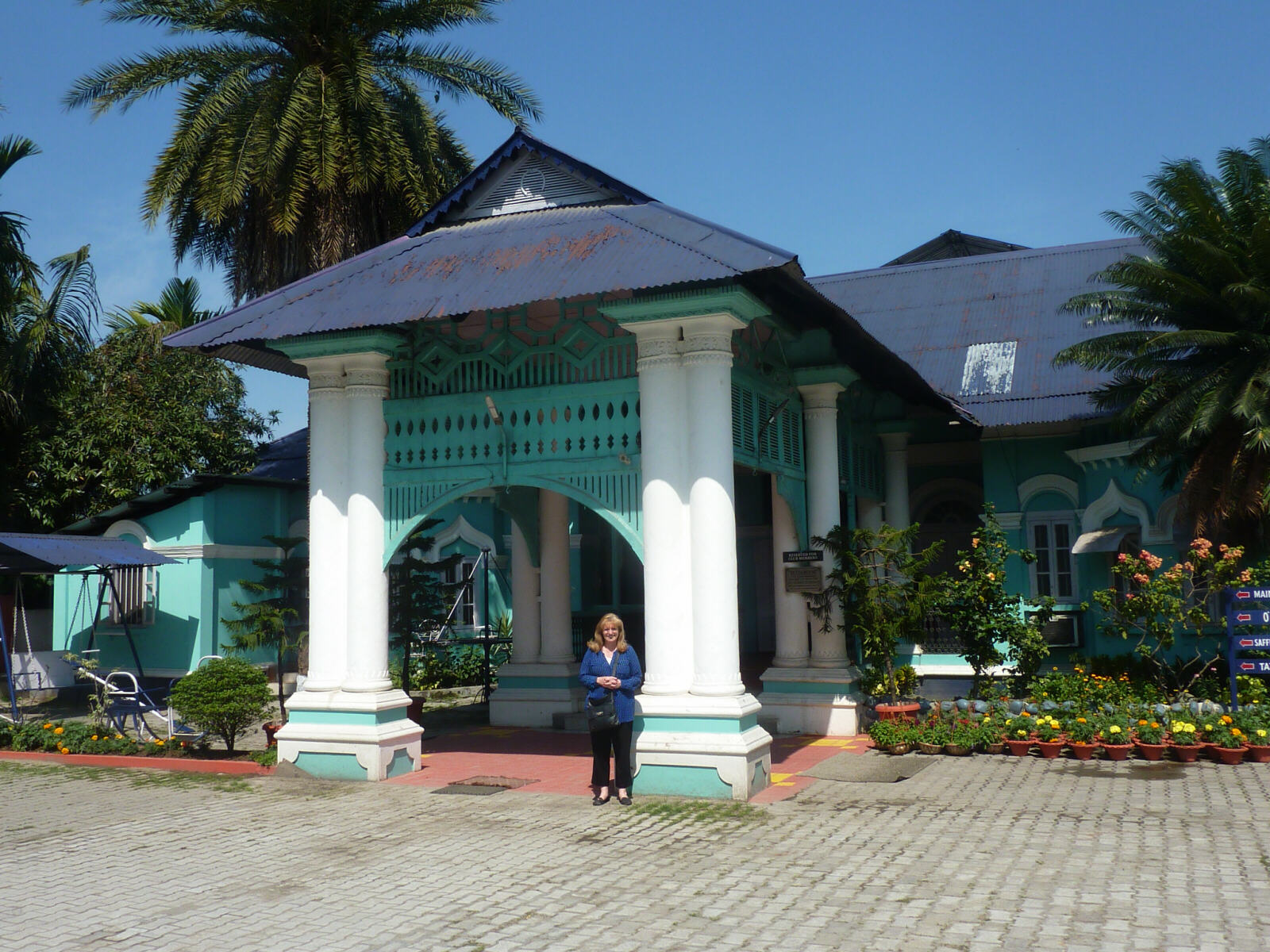
|
After relaxing in the spotless bath tub with lots of hot water (a real treat, before you could say Jack Robinson she was stripped off and in for a long soak) and the very nice clean hotel room, we went to the members’ bar (we were members by virtue of being residents in the hotel) and had very reasonably-priced bottles of wine with tasty nibbles of pakodas and masala green peas, while watching India vs. Pakistan in the Asia cricket championships. |
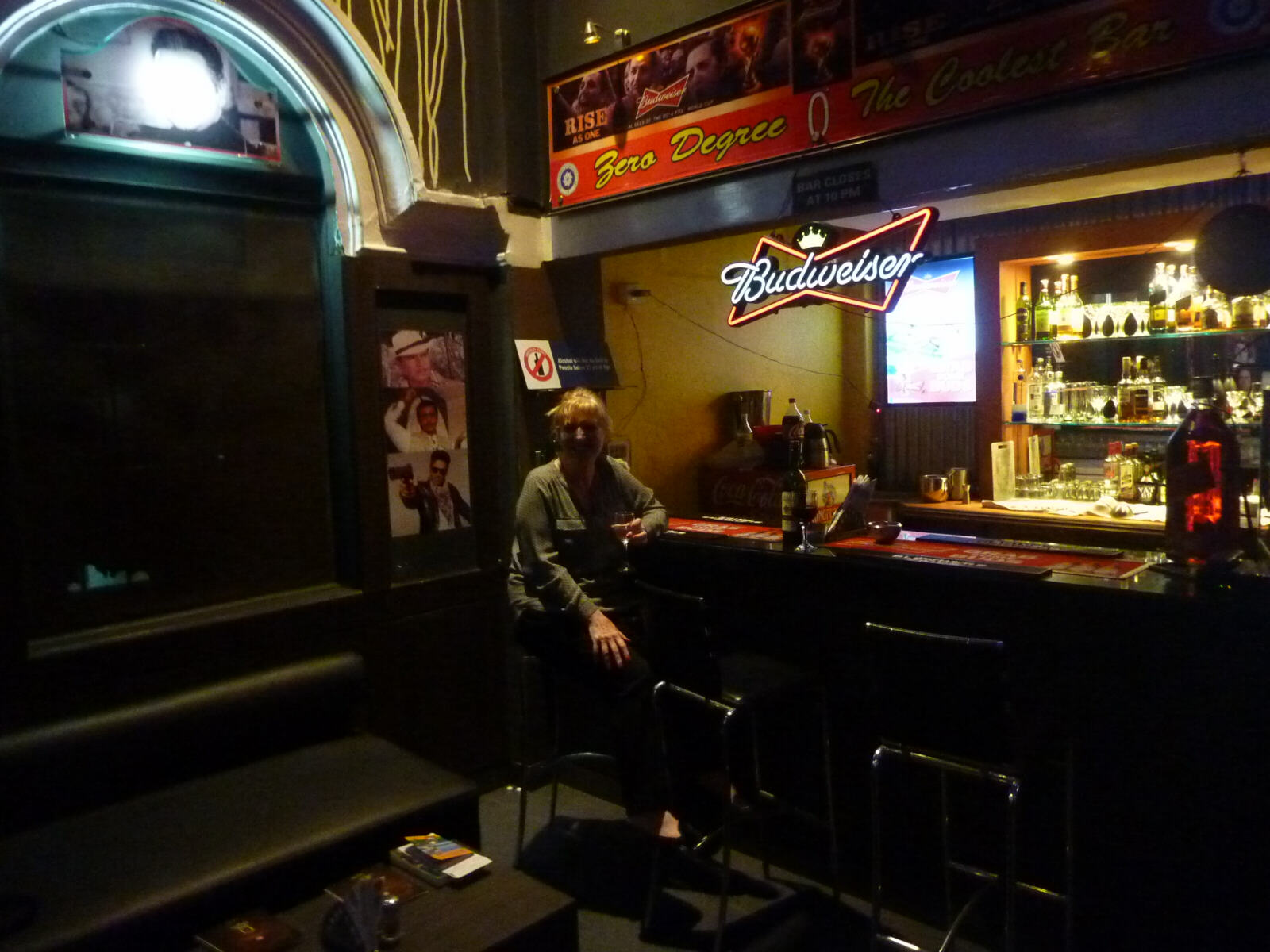
|
Sun 28th. We set off in the hotel-arranged car for the 3-hour drive to Ledo at the far end of Assam and the start of the wartime ‘Burma Road’ across the mountains through Burma to China. It was an interesting ride, through a mixture of tea plantations and coal mines, and two or three towns with vegetable markets spread all over the road causing long traffic jams. The driver drove confidently as if he knew where he was going, but after we had gone through Ledo town he slowed down and said something to the effect of “OK that was Ledo, now what?” We took Sheila’s sensible suggestion and asked a rickshaw driver where the ‘Stilwell Road park’ at mile zero of the Burma Road was. He pointed us further down the road and we found the small park with information boards, but it was locked up. Sheila decided she’d come all this way and wasn’t going to be thwarted and climbed over the gate, at which point a man with a key ran up and let me in. |
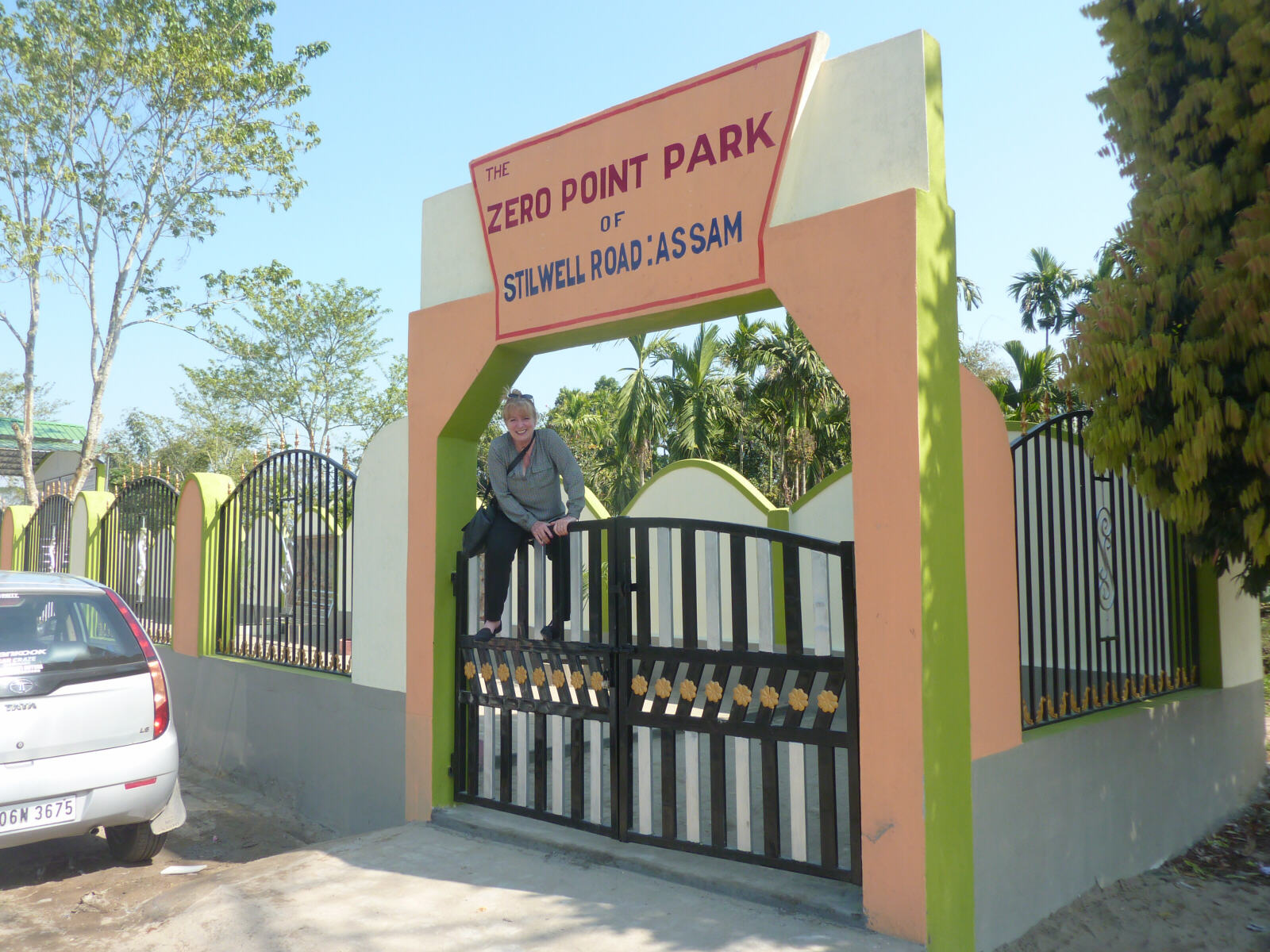
|
There wasn’t a lot to see but the information displays about General Stilwell and how they built the road through the enemy-held mountains and jungle were interesting. |
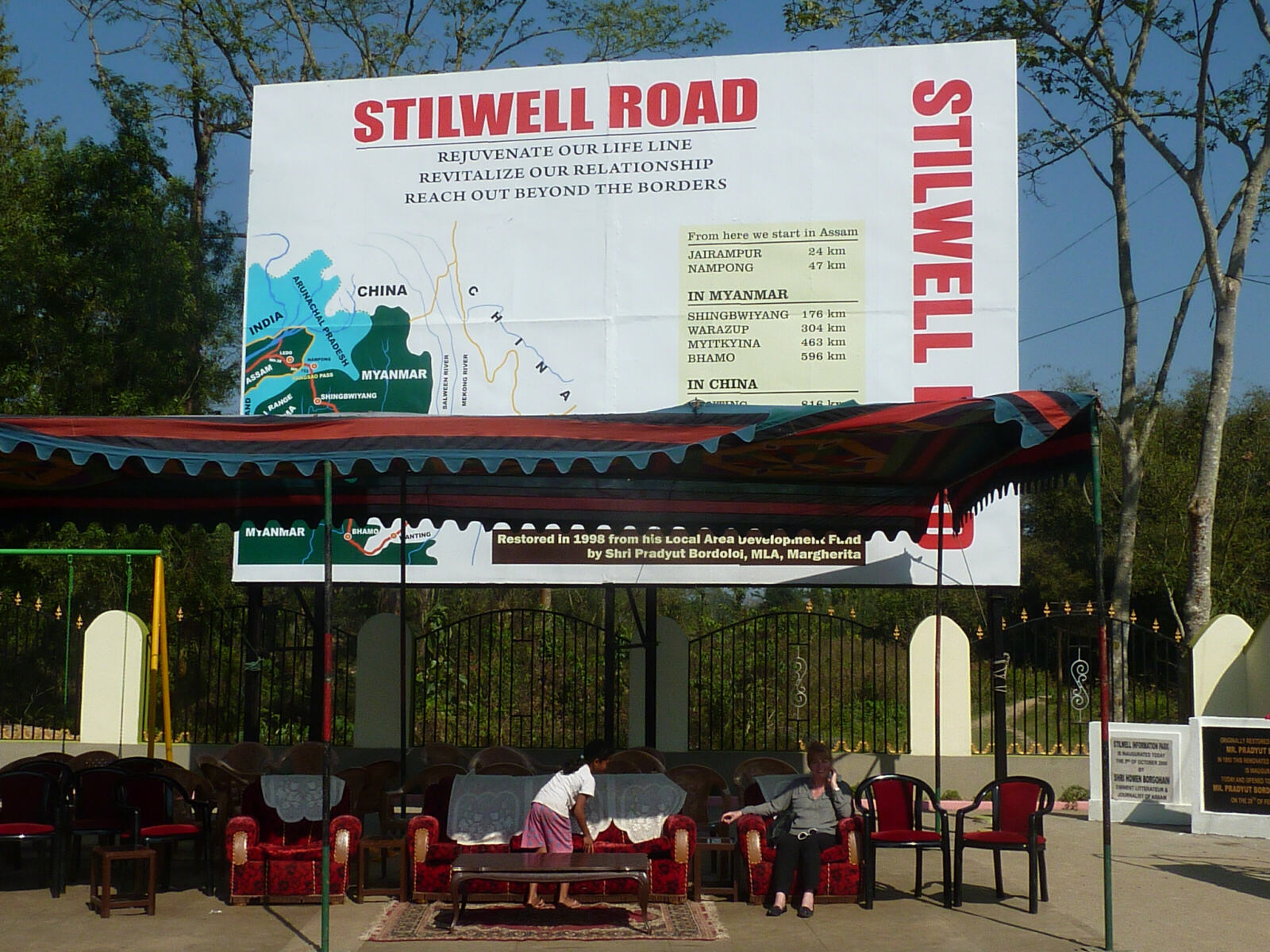
|
We set off back the way we had come until we spotted a couple of elephants trudging along the road, apparently going home after a day’s work, and had to stop to take photographs. |
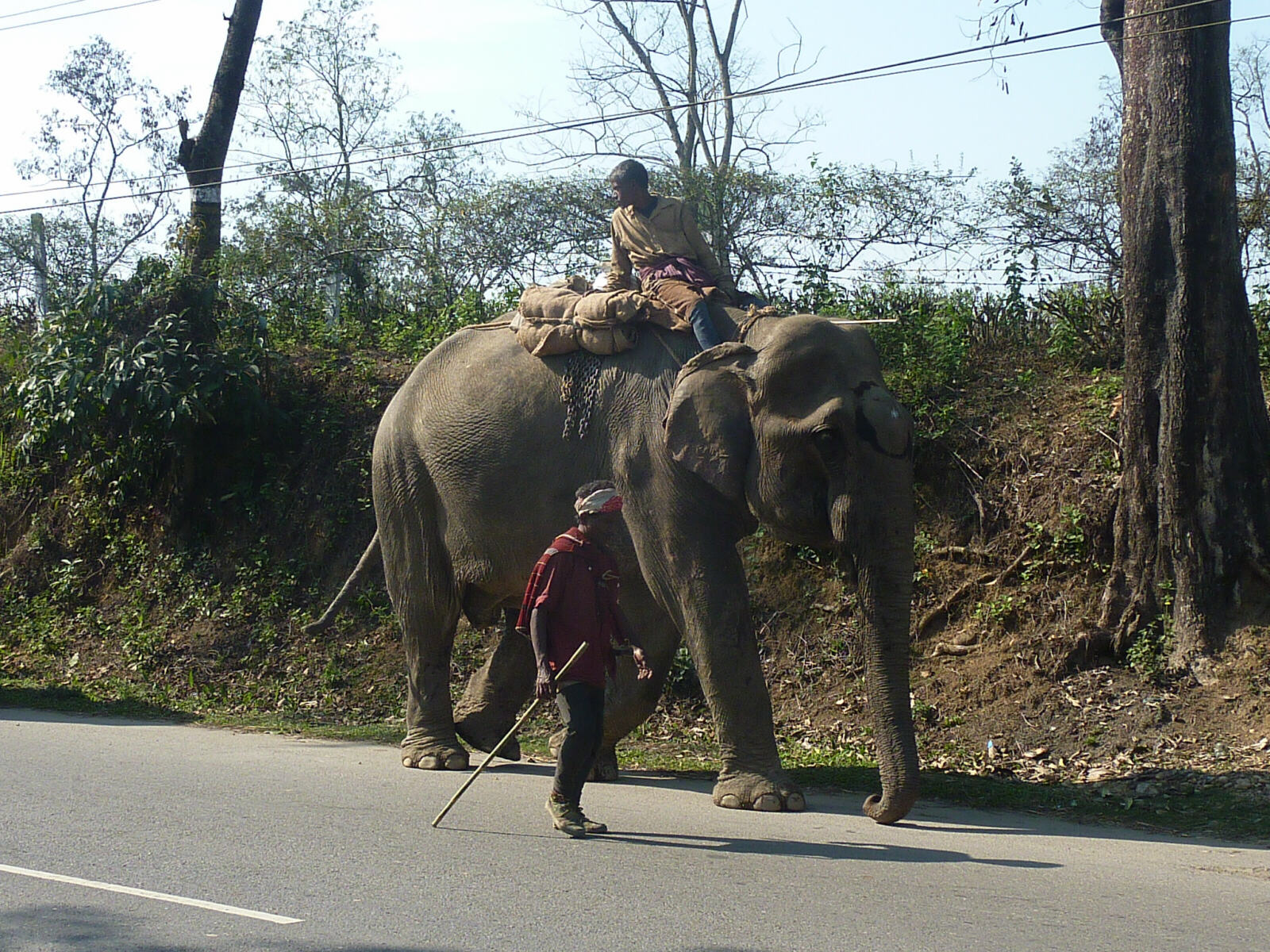
|
Then the journey was uneventful until we were in the outskirts of Dibrugarh and as we went to turn left into a side road a man pushed a barrow up alongside us which of course collided with the car. Our driver stopped, took the car keys and ran after the barrow man, leaving our car in the middle of the road blocking a junction. Immediately queues of traffic formed in all directions hooting at us and each other. A crowd of bystanders and interested parties urged us to move the car out of the way, but with no keys and the steering locked our options were limited. The cheerful and good-natured crowd started to push the car along the road, unable to turn it into the side, and it was about a hundred yards up the road by the time the driver reappeared to rescue us. We got back to the hotel without further incident and wallowed in a hot bath in our actual bathtub, to wash off the road dust. We went back to the Gymkhana Club bar and were in the middle of a wonderful meal of veg pakoda, green peas masala and tandoori aloo with Four Seasons shiraz red wine and Sula chenin blanc, watching the Asia Cup cricket when the bar staff dropped their bombshell – thanks to an Assam State law all bars will be closed on the last and first days of the month, i.e. tomorrow and the next day. So we took the rest of the shiraz and a bottle of Kingfisher beer back to our room for a picnic tomorrow.
Mon 29th. We went by shared auto-rickshaw to the bus stand to buy our bus tickets for tomorrow, then had a quiet day in our nice hotel room. It wasn’t the tea-picking season – all the tea bushes looked tired and some appeared dead, nobody was among them picking anything and the drying machinery was switched off, so we didn’t try to arrange a visit to a tea plantation. |
Tezpur and a glimpse of Kaziranga National Park
|
Tues 1st March. We were in the bus station at 8am for the AC ‘luxury’ 8:15 bus to Tezpur, which arrived about 8:45 and left about 9. It was quite comfortable with reclining cloth seats and for once we had a good bus driver. After the obligatory lunch stop the road ran alongside Kaziranga National Park and suddenly in a patch of grassland we saw a rhino, then in two more swathes of grassland we saw two more. We were still excited about this when along the road came two elephants, each loaded up with bamboo canes, which made our day. Eventually we crossed the Brahmaputra river again, this time on a 3km-long bridge rather than a wooden ferry, and arrived in Tezpur. We stayed at Hotel KRC Palace which was nice, and ate in their restaurant which was absolutely delicious – chicken lababdar, kadai vegetables, an onion kulcha, a mix veg raita and spicy chutneys.
Wed 2nd. We went by cycle rickshaw through quiet suburban streets to the Arunachal Pradesh government office where Indians were getting permits at a small window on the verandah. The office opened at 10am but we had to sit and wait until 11 or so when we were ushered into the deputy resident commissioner’s office. He was a nice man but told us we had been misinformed, they were not authorised to issue permits for foreigners here and we would have to go to Delhi! Disappointed we returned to the hotel and Sheila consoled herself with a very good full beauty and hair treatment in the hotel’s salon. We therefore skipped the Arunachal Pradesh section of our itinerary, resolved to come back another year, made arrangements to go on to Shillong tomorrow and retired to the bar to plan some extra things to do to fill the gap, over a few beers. We then had another extremely tasty meal in the hotel’s restaurant. |
Shillong, Meghalaya State
|
Thurs 3rd. We went for the easy option again and set off in the hotel-booked car for the 5-hour drive to Shillong. Quite a bit of the road was a new, smooth dual carriageway with light traffic and we sped along comfortably. As soon as we turned off the Assam Trunk Road and entered Meghalaya state it became hilly and we went up and up to Shillong, a former British hill station spread over more hills. Assam was quite hot but now it got chilly again. We were back in the hill culture again, with a different language, Christian churches and beef eating. We drove through what seemed to be the whole town, through seething bazaars and busy commercial streets, until we went up to the colonial-era town, past the Shillong Club and Ward’s Lake in a park and checked into the Pinewood Hotel (established 1898) and had one of the large, characterful rooms with chairs outside on the verandah. |
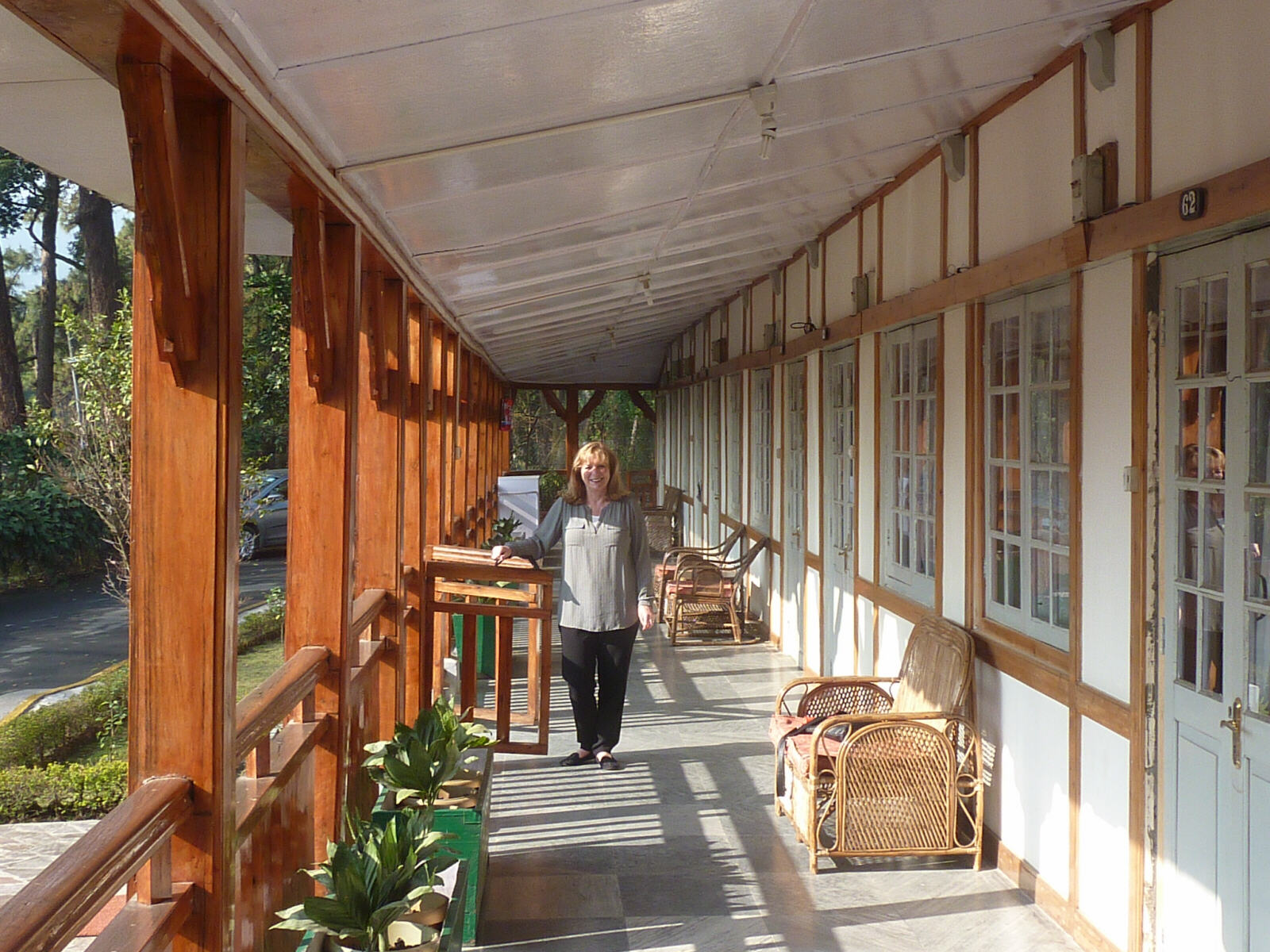
|
It had clouded over on the drive up and as we were unpacking we thought ‘what’s that noise?’ and found it was a sudden torrential downpour, just to remind us that we are close to the wettest place on earth. We stood on the verandah watching the rain pour off the roof onto the garden. |
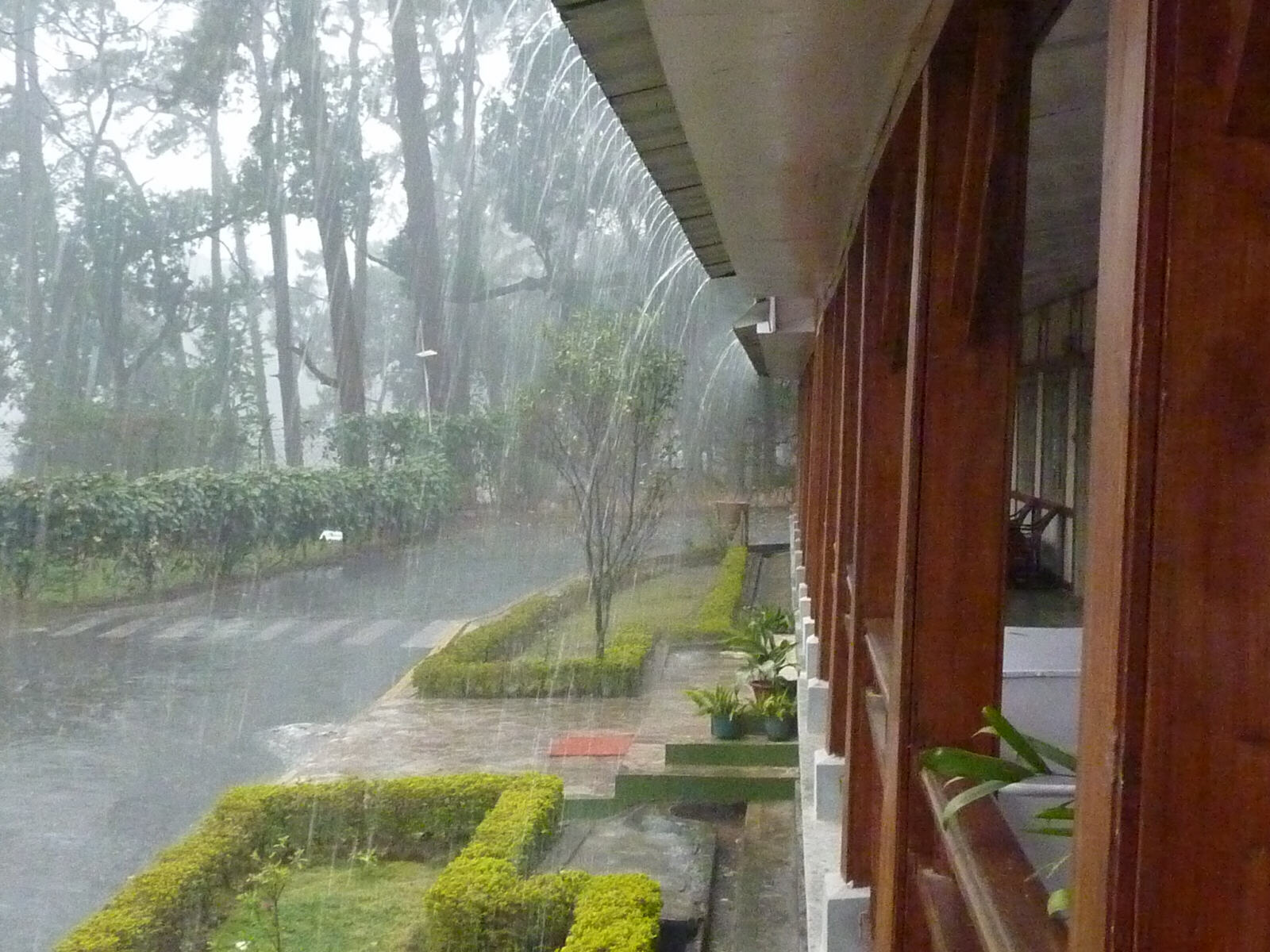
|
By early evening the rain had stopped and we went into the main building to the bar where we had reasonably-priced bottles of Sula cabernet shiraz and chenin blanc wines (not the whole bottles, they are for tomorrow night as well). When the restaurant opened at 7pm we had another amazingly tasty meal of chicken bharta and aloo korma with onion kulcha and a raita. They gave us two hot water bottles for the bed which Sheila immediately commandeered, she was over the moon! We like it here.
Fri 4th. The breakfasts in most of the hotels on this trip have been similar – a buffet with five or six Indian dishes, boiled eggs or an omelette, a couple of plates of fruit and toast, butter and jam, and they will fry eggs to order if you ask. Here it was the same, but better – all the dishes in the buffet were good and hot and plentiful. We decided to switch from our usual fried or boiled eggs and went for the all-Indian option with a delicious potato and peas curry with a paratha. It was so nice we had a couple of refills and we had so many potatoes that the nice young waiter asked if we had potatoes in our country! There was no sign of the tourist office lady in her little office by the hotel entrance so we went out to see the town. We walked down to the main road, stopped the first bus that came by and asked if it went to Bata Bazaar. The consensus among the passengers and conductor was that it did, and a nice lady passenger told us it would cost us 5 rupees each (5 pence). We went slowly though the traffic jam along the main street in the town, talking with a Canadian lady who was here for several months to study anthropology. The bazaar was the last stop so we got off and plunged into one of the narrow bazaar streets and zig-zagged to and fro amongst the interesting tribal people buying and selling and making and mending all sorts of things. |
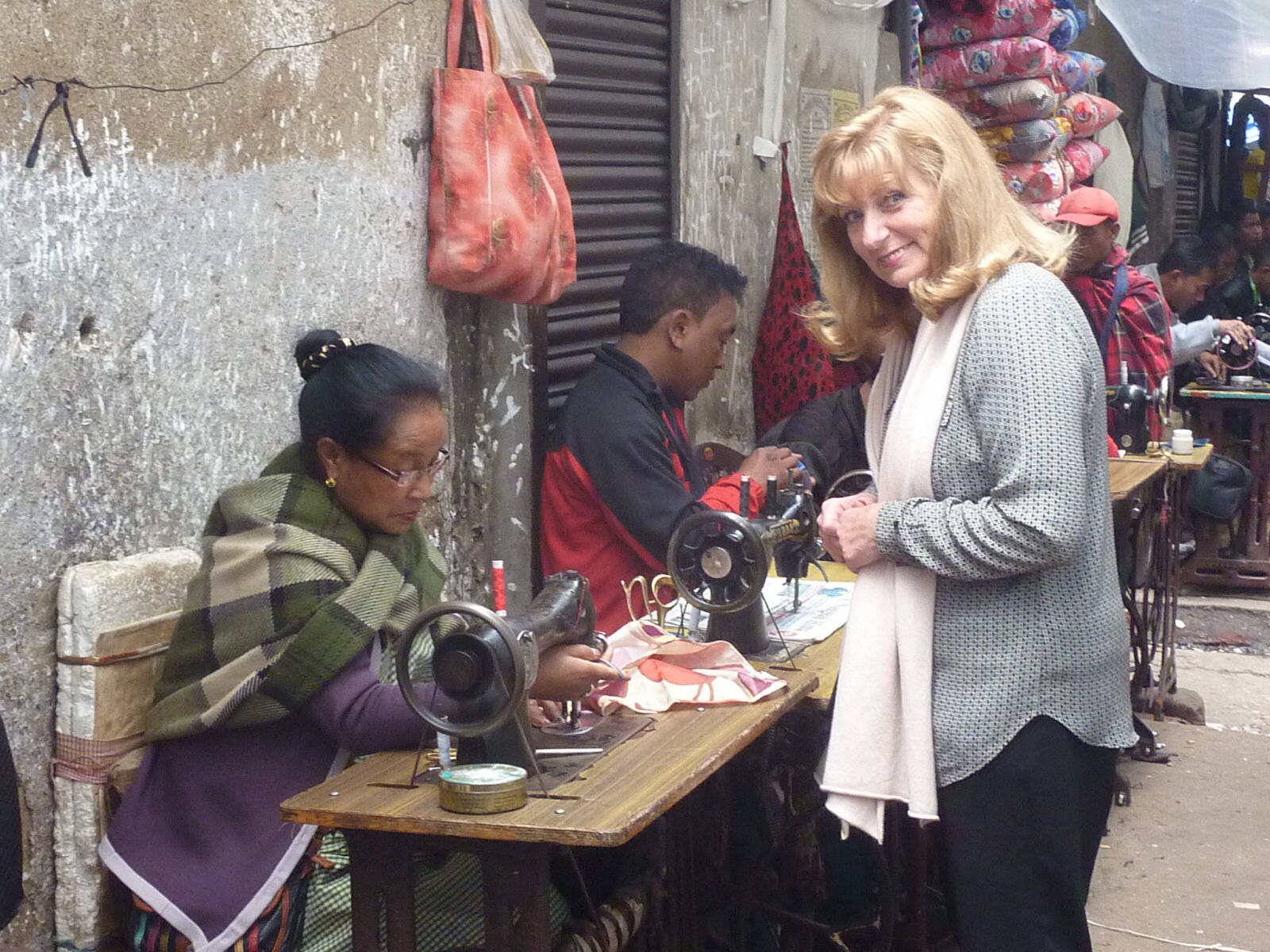
|
Eventually we emerged back onto the main road and walked back down to Police Bazaar, a big roundabout at the junction of seven roads. Amazingly one of them was a pedestrianised shopping street so we strolled along that without having to dodge the traffic, then navigated through winding back streets past the botanical gardens to Ward’s Lake, a popular well-kept park with nice flower beds and walkways and people pedalling round the lake in pedalos. We had a lovely evening, first in the hotel bar finishing off yesterday’s bottles of wine then in the restaurant having the most delicious chicken jalfrezi and aloo gobi.
Sat 5th. We went on a tour by local taxi with an extremely good driver to some of the sights up on the hills beyond Shillong. After a couple of hours’ drive we got to Rivai village and walked down steps and a rocky path to the ‘living root bridge’ over the river in the valley. The bridge was made of the roots of several rubber trees intertwined and it looked very old. |
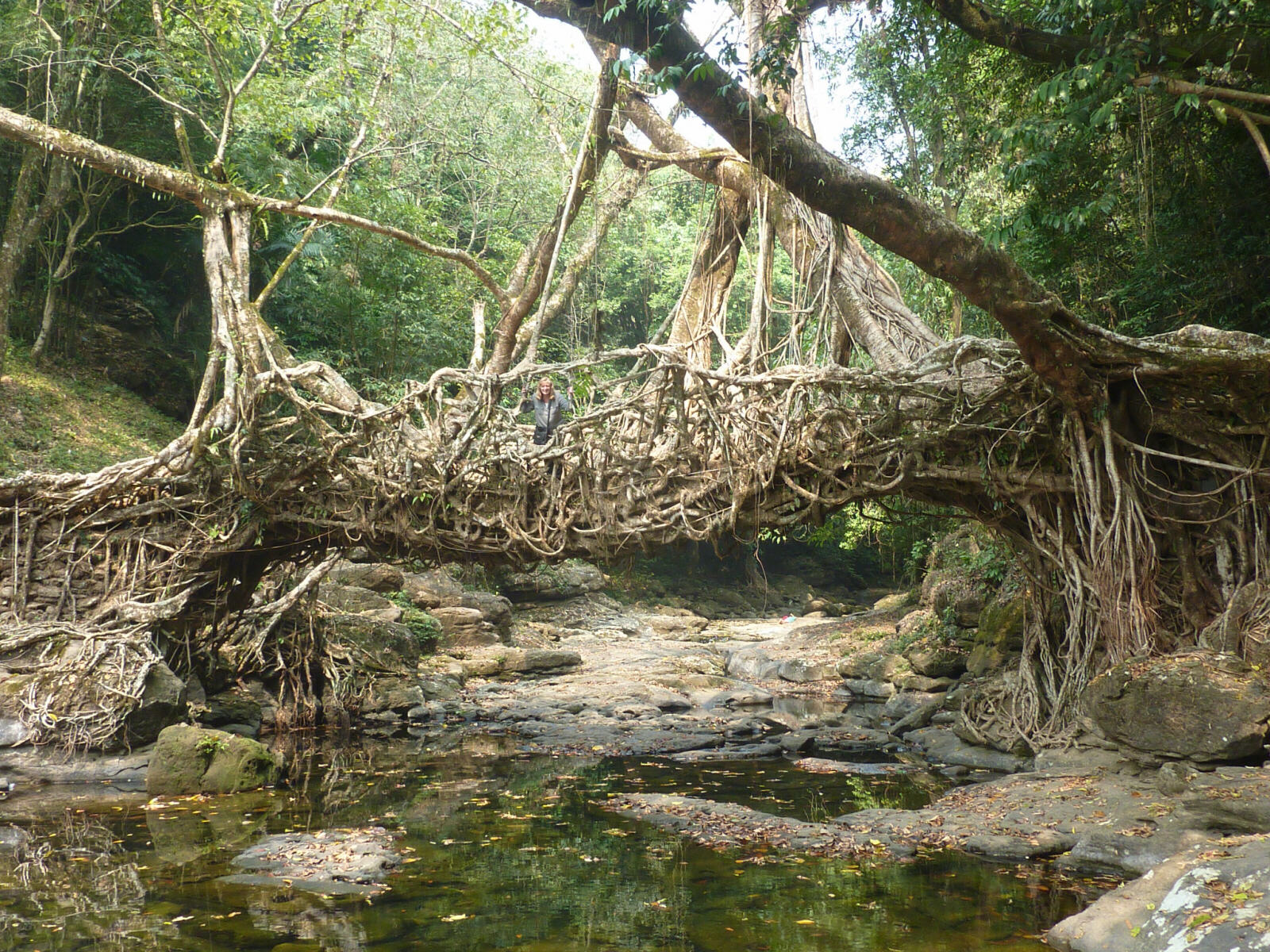
|
The villagers were washing their clothes and kids were playing in the river and it was all very picturesque. |
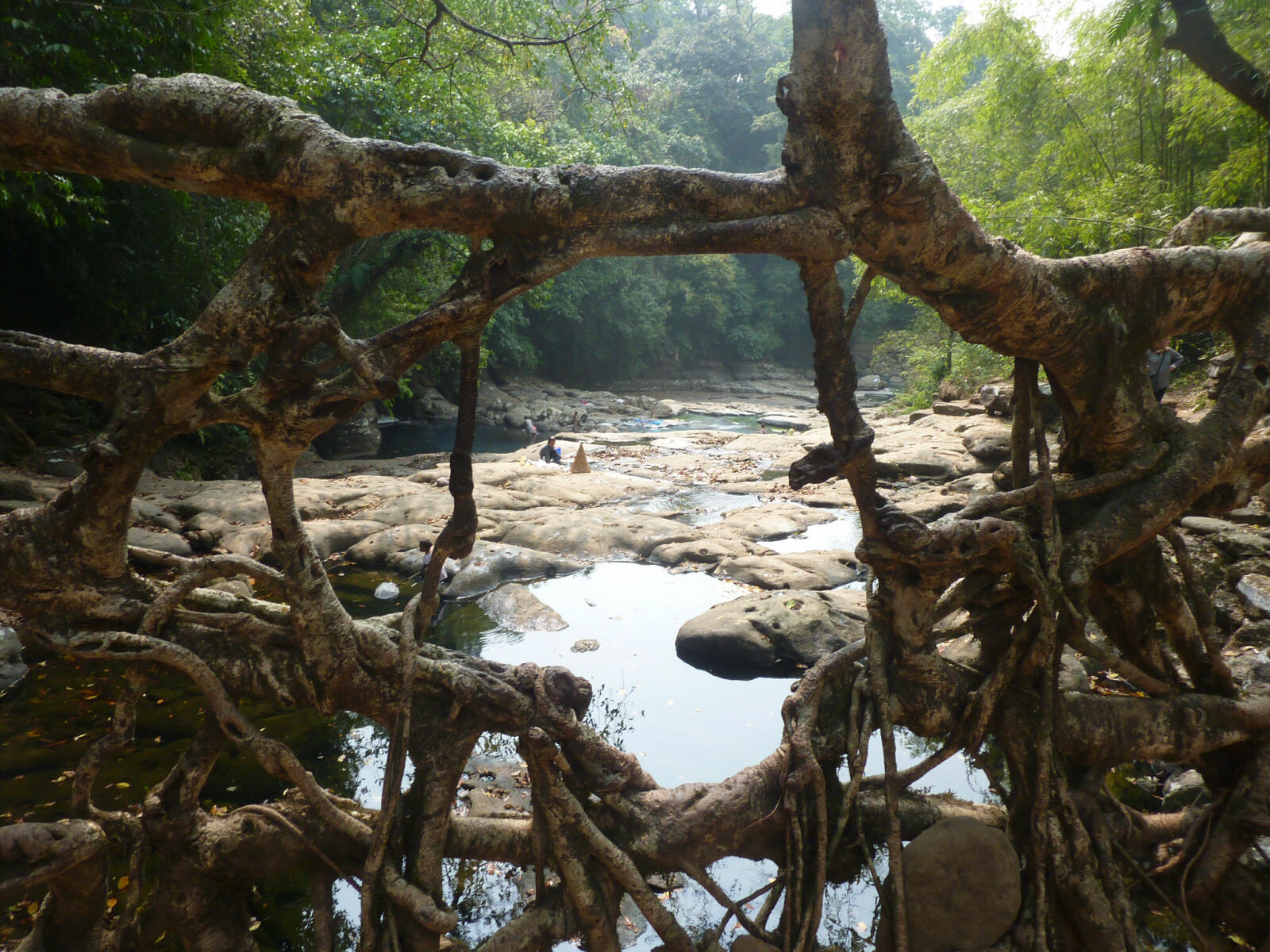
|
Back up in the village we climbed up rickety bamboo ramps and steps to an even more rickety bamboo treetop viewpoint. The view was good but the most interesting part was the lookout itself. |
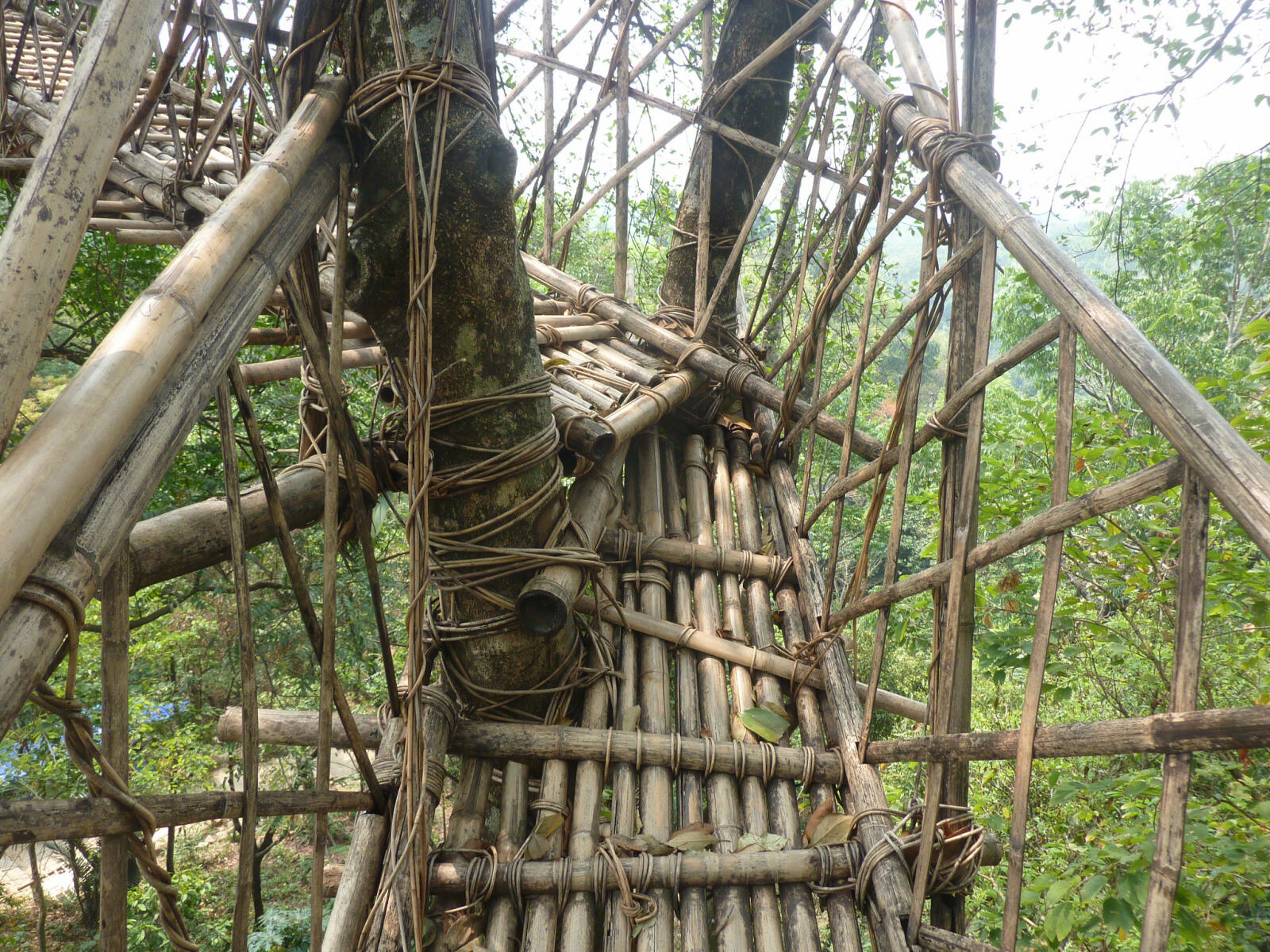
|
A little way down the road we stopped at ‘balancing rock’, a huge boulder balanced precariously on a smaller rock. Then we reached our main destination, Mawlynnong which is advertised as the cleanest village in Asia. We expected a bit of a tourist trap but it was lovely – we walked along paths between well-kept bungalows in colourful flower-filled gardens. |
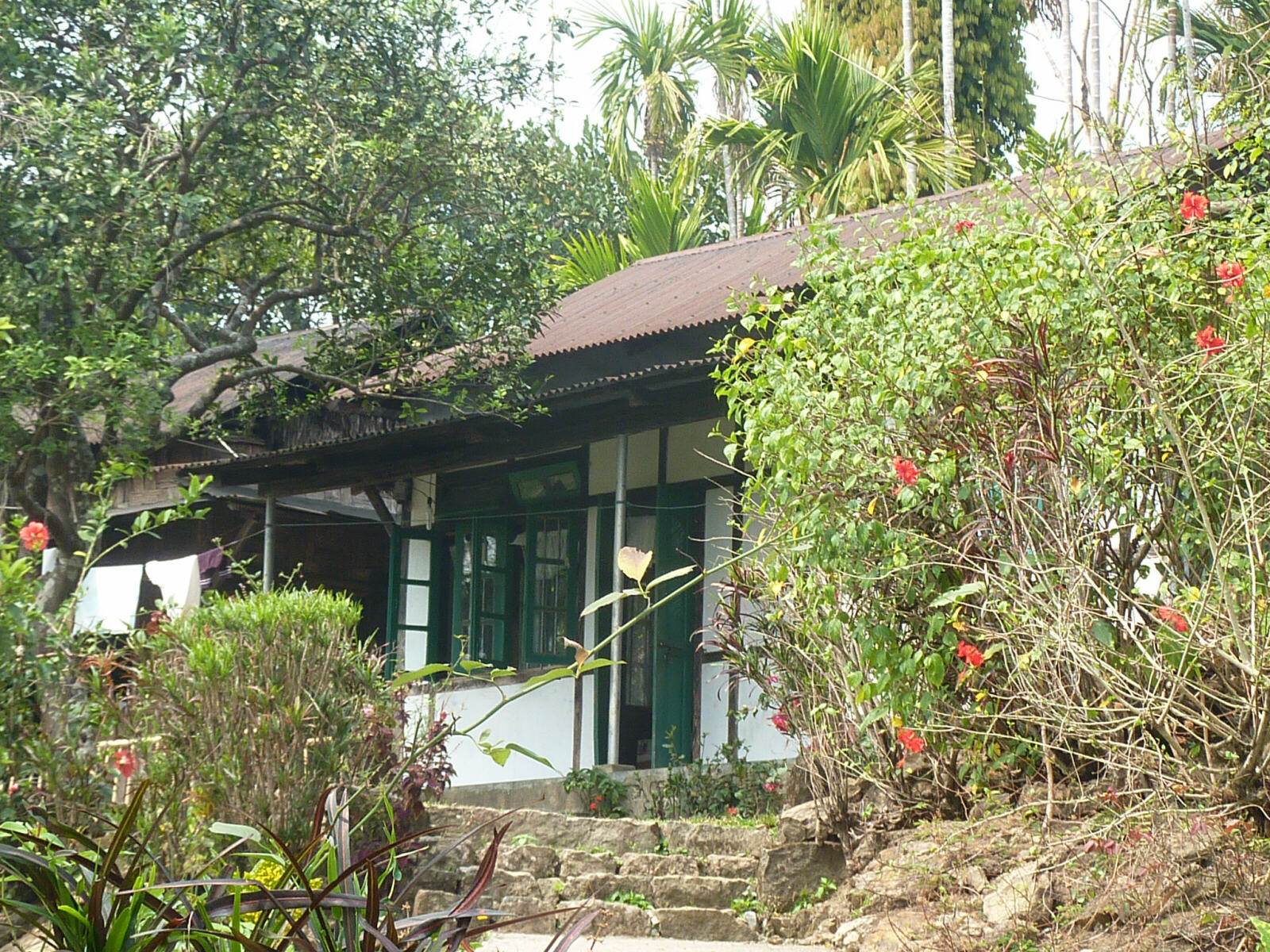
|
We stopped for a chai and a bun in a little tea stall by the main square and while we were there a nice young man asked if he could take ‘one photo’ – of course we said yes and 20 or so people came out of nowhere to join in and take photos! |
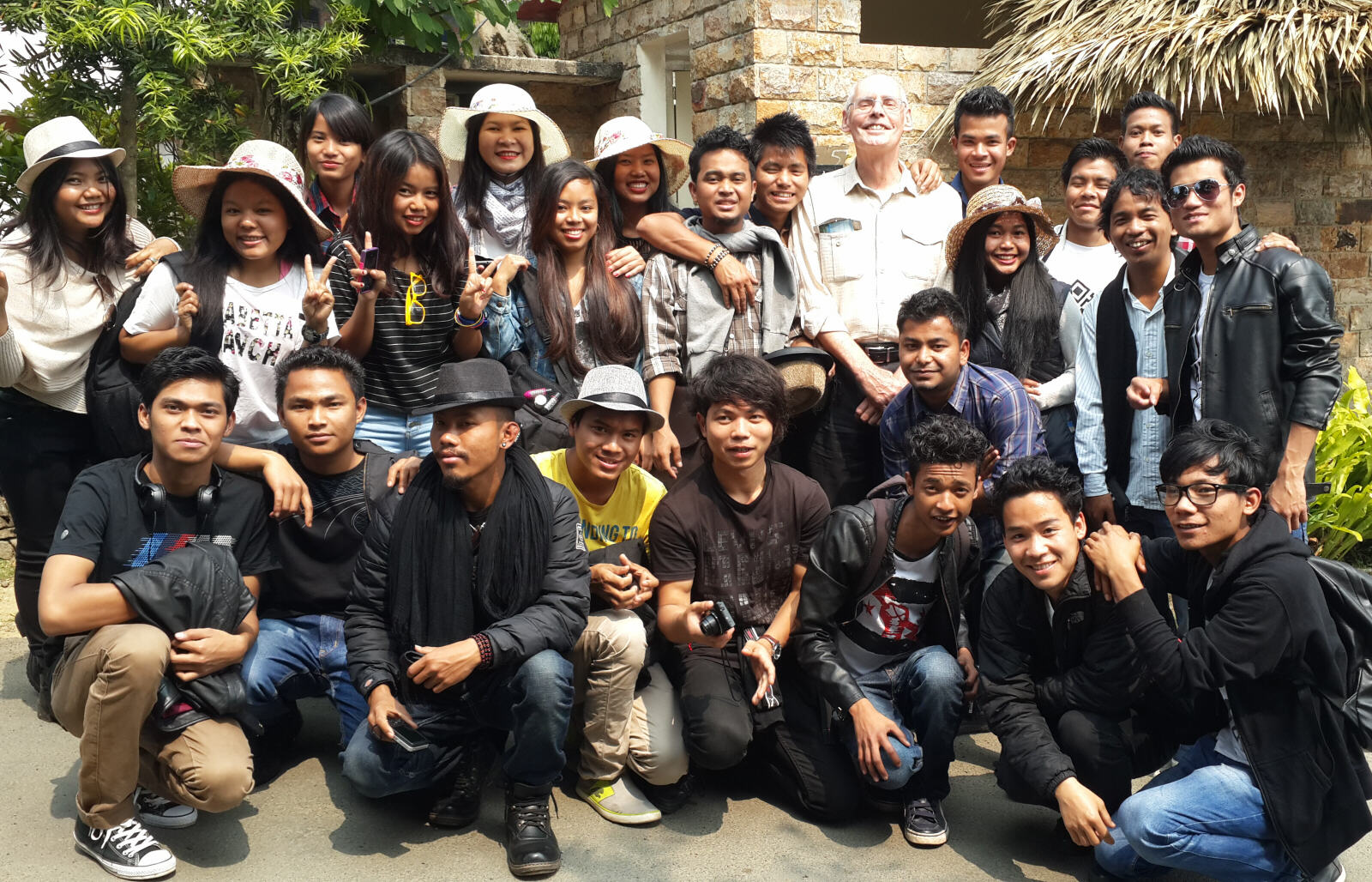
|
We set off back to Shillong and so far it had been hot and sunny all day, but to remind us that we were very near what is, statistically, the wettest place on earth, it soon clouded over and we drove through a torrential downpour. Our driver offered to stop at a viewpoint over a spectacular valley that plunged all the way down to the Bengal plains, but the valley was completely obscured by mist and clouds so we didn’t stop. Back in Shillong the sun was shining again so while Sheila relaxed in her bathrobe in our nice room at the Pinewood hotel I walked down to pretty All Saints Cathedral, built 1902. I started to walk back and it started to rain, so I sat it out in a little café with a samosa and chai then walked the rest of the way back in gentle drizzle. We finished a nice day with glasses of wine in the bar and another delicious meal in the restaurant. |
Guwahati, Assam
|
Sun 6th. After a nice lazy start and a nice spicy breakfast our car came at 10am to take us down the hills to the heat of Assam again and into Guwahati, the state capital, where we found the Atithi hotel with no trouble at all. The hotel was in Paltan Bazaar in an interesting location on a crossroads opposite the Nepali temple. |
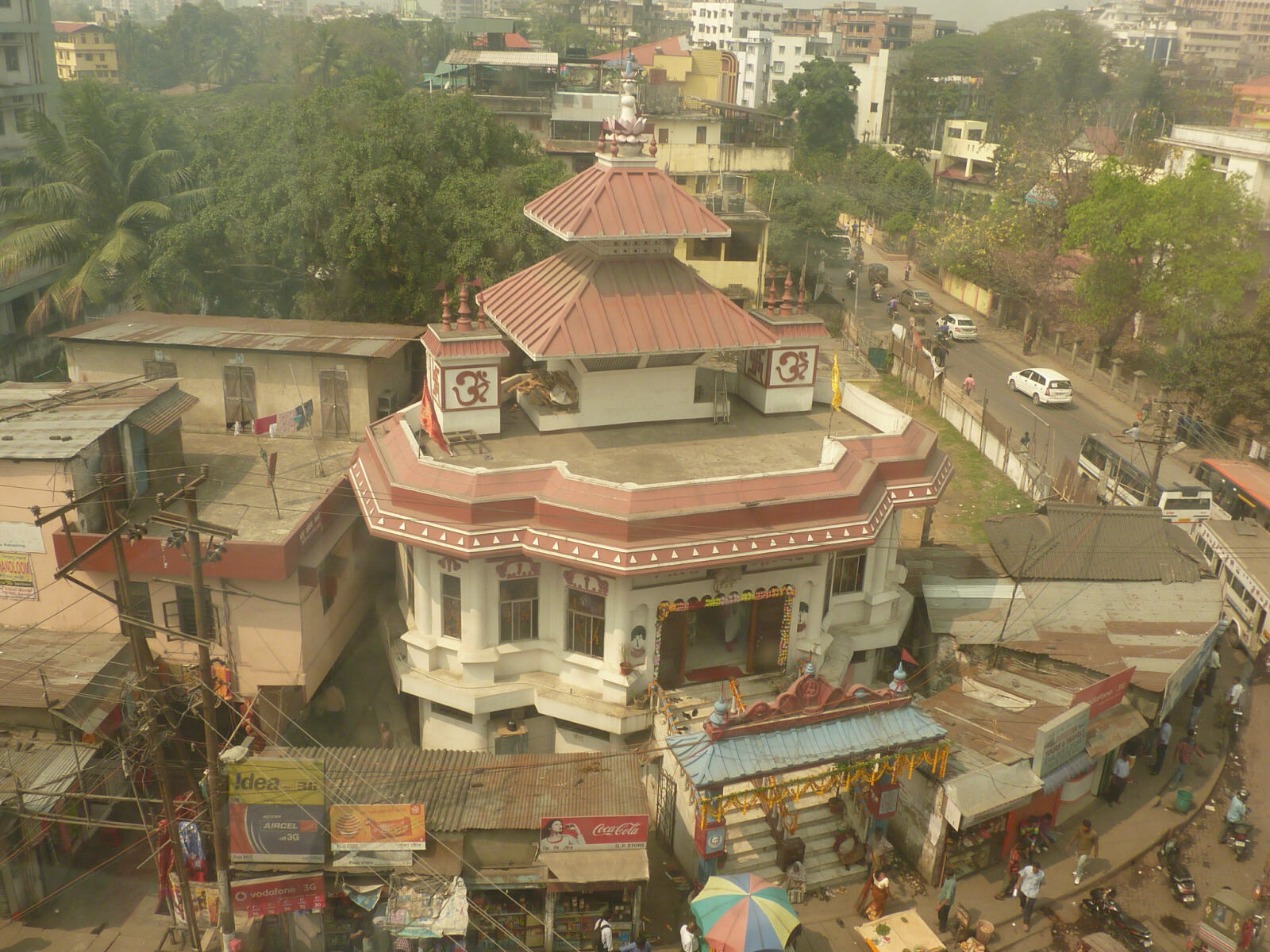
|
The helpful staff made a train reservation for us so we walked through the bazaar to the railway station to check it out. A long-distance train was just arriving on platform 1 and we watched a whole platform-full of people be absorbed into the train. Down at the luggage-car porters were loading huge, heavy, sealed straw baskets from wooden barrows into the train, pushing and shoving them in to fit, and when we enquired what was inside them we were amazed to learn that they were full of tomatoes! |
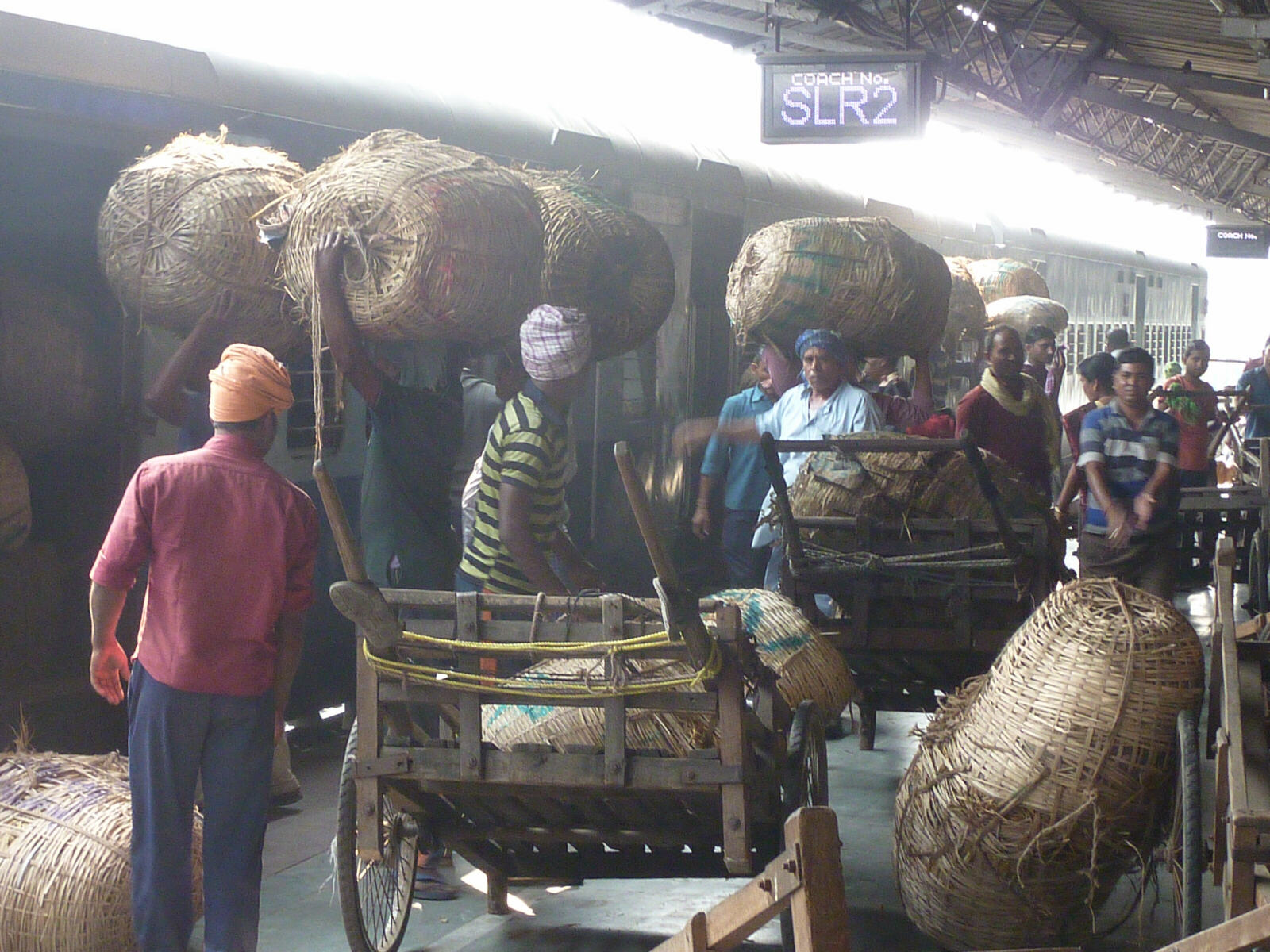
|
Inevitably some of the departing passengers wanted to take our photo and a few minutes later as the train pulled out we waved goodbye to our new-found friends. Back at the hotel we had a very frustrating time to get a ticket for the train reservation they supposedly made earlier. The hotel said the travel agent’s ‘boy’ would take us to the station with our passports to complete the reservation. He didn’t turn up and after several phone calls he eventually came and took me on the back of his motorbike to the station where he didn’t have a clue what to do. After asking at several booking windows and being turned away, they directed him to an office the other side of the car park, which was closed. He said try tomorrow so I declined to ride back on the motorbike and walked through the station and across the railway bridge to the hotel where we had snacks and a beer for dinner.
Mon 7th. After a nice breakfast at the extensive breakfast buffet we walked over to the railway station and bought our train ticket with no fuss, bother or queueing, which made yesterday’s fiasco even more pointless. We rested a while in the room then it was time to get out amongst it in today’s festival. We got an auto-rickshaw down to a small park on the Brahmaputra riverfront where boats were ferrying pilgrims across to a temple on an island a short way upstream. |
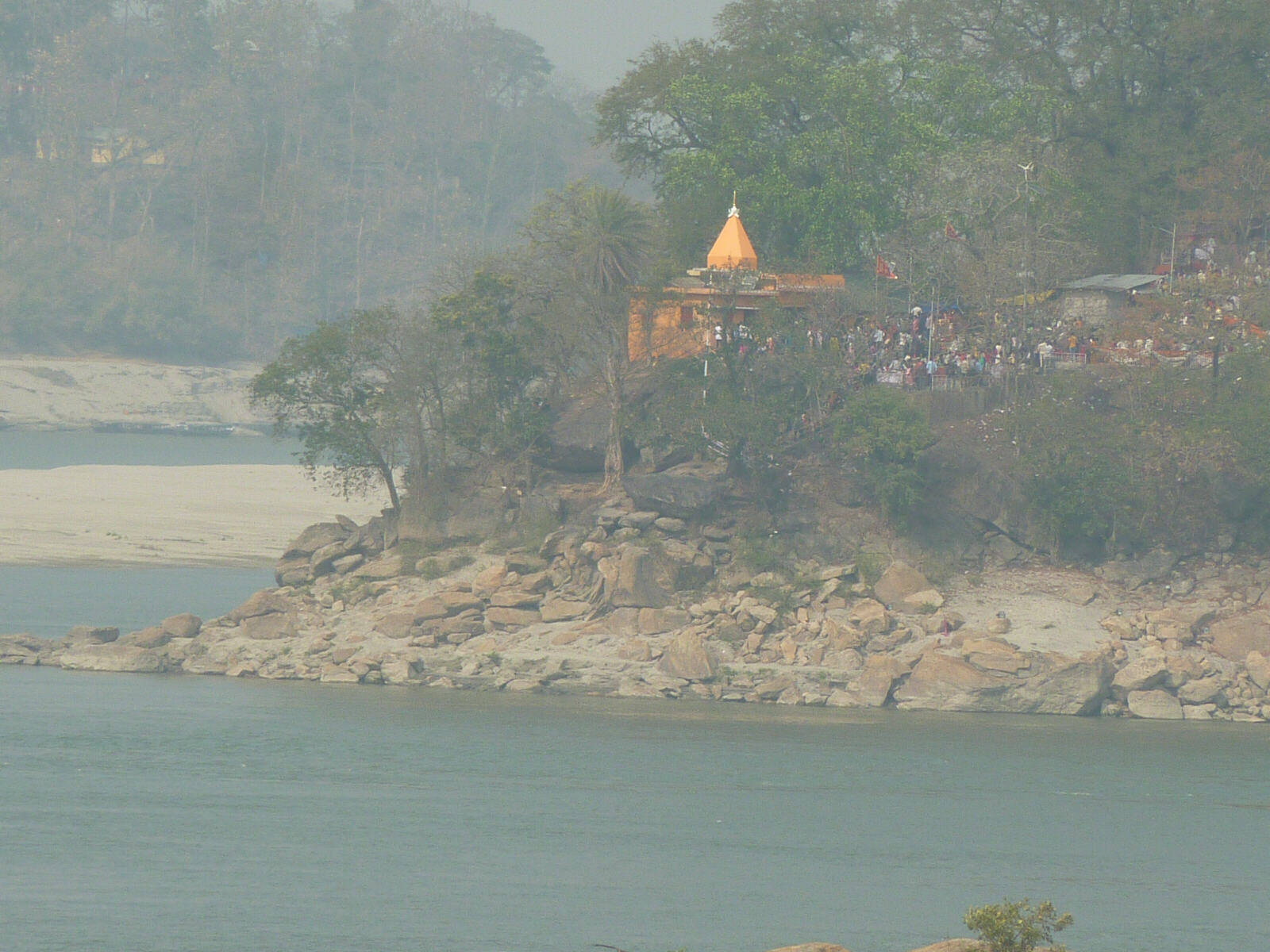
|
Nearby at Sukreswar (or Shukla Shucoar), apparently the main temple in town, a huge slow-moving queue of worshippers stretched out of the entrance and out of sight down the street. Soldiers stood by in groups to keep the crowd in order. |

|
We stood at the entrance watching the crowds then one of the officers beckoned us to come in, jump the queue and he escorted us like VIPs round the whole complex! At the main temple itself a friendly priest/temple guardian took over and guided us into the inner sanctum where packed, jostling worshippers were pouring milk and offerings over Shiva’s lingam and the floor was slippery with milk and flowers and leaves (everyone was barefoot of course). |
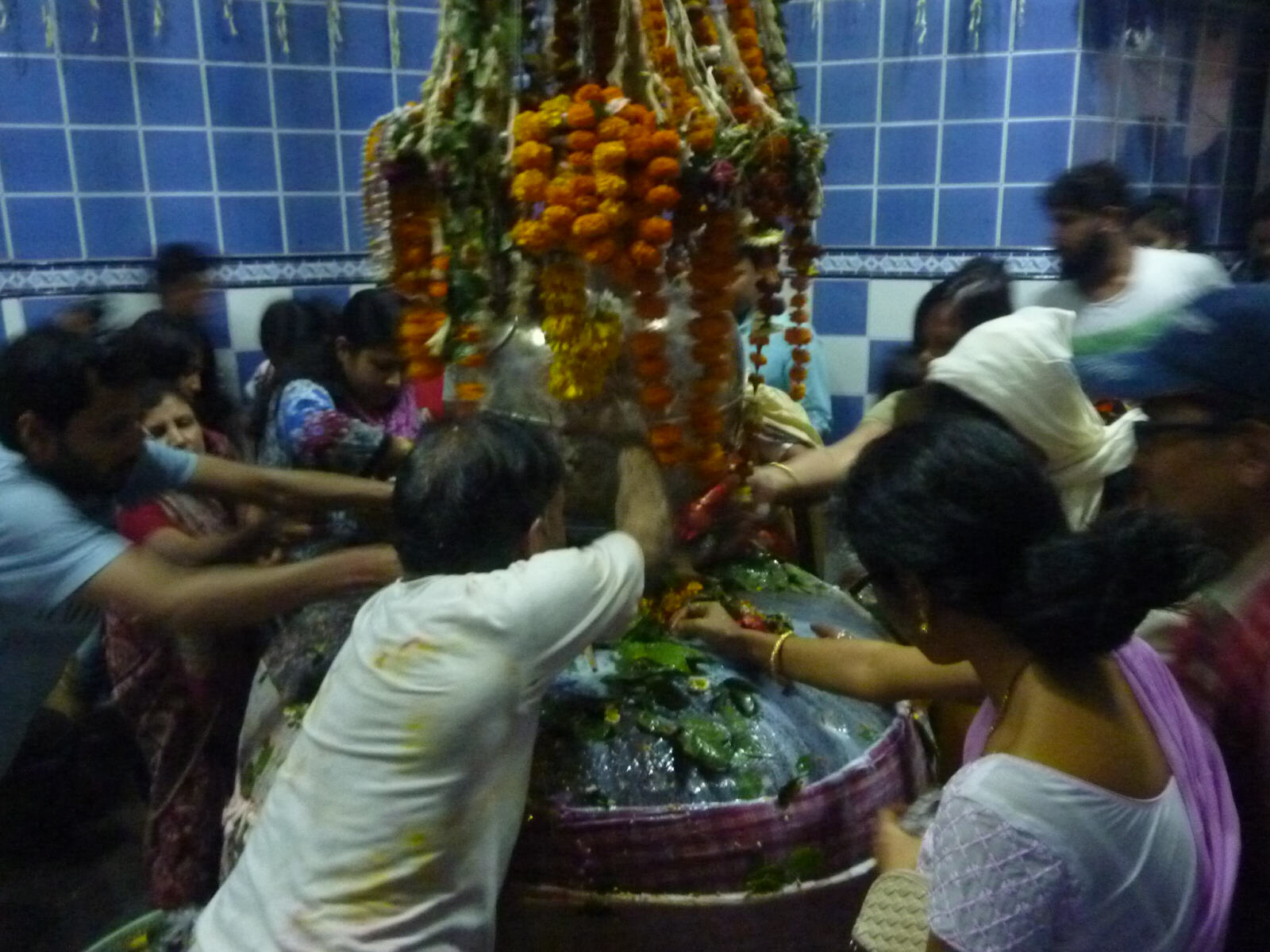
|
From the main temple our soldier took us up to a pavilion overlooking the river where food was being dished out to all the pilgrims and we were encouraged to have hot rice pudding and a savoury fried veg ball. It was all fascinating. Our waiter in the restaurant last night said there were two temples we had to go to, that one and the Balaji temple which was on the other side of town, so we found an auto-rickshaw and asked to go there next. He asked rather a high price but we said OK and drove across town, and out of town, and on and on for over an hour until we finally came to a modern, clean, quiet temple complex with four separate open shrines and only two or three pilgrims there. It was very serene and parklike but we had been expecting the crush, chaos and colour of the previous temple experience. The same rickshaw driver took us finally to the Nepali temple right opposite our hotel. In the temple I noticed some sort of automated ‘drum and bell’ machine looking dusty and forgotten in a corner, and as I was looking one of the temple guardians came up, pressed a hidden switch and it started belting out a drum and bell rhythm! |
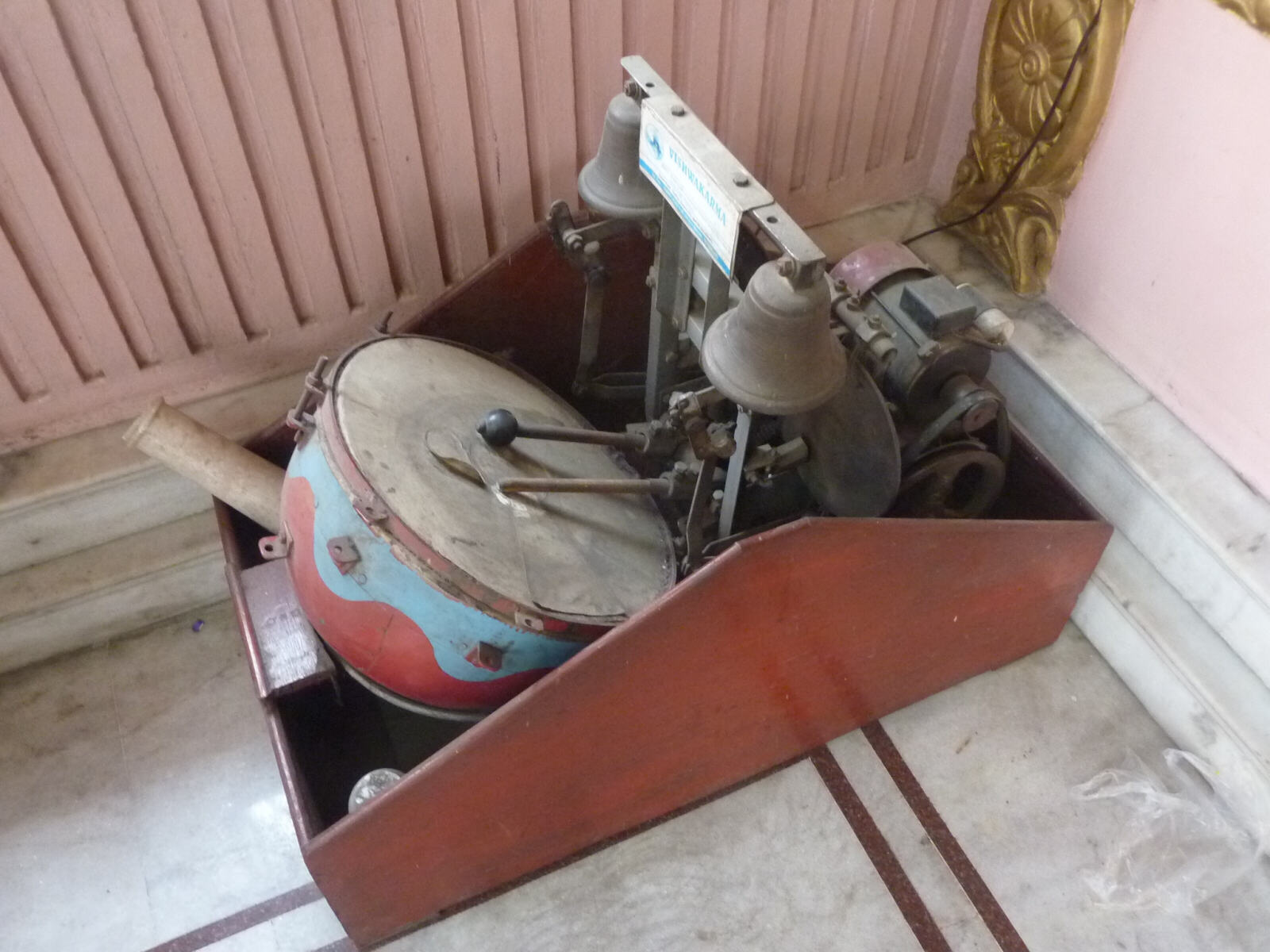
|
We whiled away an hour in our room then opened the bottle of Sula sparkling ‘champagne’ and packets of crisps we’d bought and celebrated our 45th wedding anniversary with champagne and nibbles in our room. |
West Bengal,
Darjeeling
|
Tues 8th. We checked out of the nice Atithi hotel and went to the railway station, got a porter to carry our bags over the footbridge and found our seats on the 9:45 Northeastern Express, all with no fuss or bother at all. We knew that our seats weren’t together but the train didn’t seem full so with a bit of shifting around and a chat with the ticket inspector we ended up in our favourite seats, one up (including bedding, for Sheila to snooze) and one down (for me to look out of the window) in a longways pair – the other four in each 6-seat section of a 2AC carriage are two up and two down cross-ways, so we had a nice little section not sharing with anyone. Chai, food, water, newspaper and plastic trinket sellers went up and down the corridor, as did men selling phone chargers and SD cards, a new addition to the in-train commercial scene. We set off right on time and before long crossed the big, wide Brahmaputra river again, this time on a train rather than car or boat. We arrived in New Jalpaiguri station, near Siliguri, an hour late at 6pm and decided to go straight to Darjeeling. For 30 pence each a porter carried both our suitcases, heavy with Sheila’s emergency chocolate supply, on his head over the footbridge to the car park and had visibly shrunk a couple of inches by the time he got there. There were plenty of taxis and jeeps lined up outside the station so after a bit of haggling we set off with Mr Rayesh, a good driver and nice man, and went up the winding road, following the toy train tracks and arrived in Darjeeling three hours later. We checked into the recommended Dekeling hotel, puffing and gasping up the 103 steps to our room (we’re at altitude again) then quickly went down again to the ground floor restaurant which was getting ready to close (Darjeeling is not a late-night place) for a tasty plate of Hakka noodles.
Wed 9th. The rooms in the Dekeling are nicely wood-panelled, thickly carpeted and the beds are so cozy and comfortable that we slept in and didn’t want to move, apart from a quick photo from our window at 6:30am of the misty peak of Kanchenjunga catching the rising sun. |
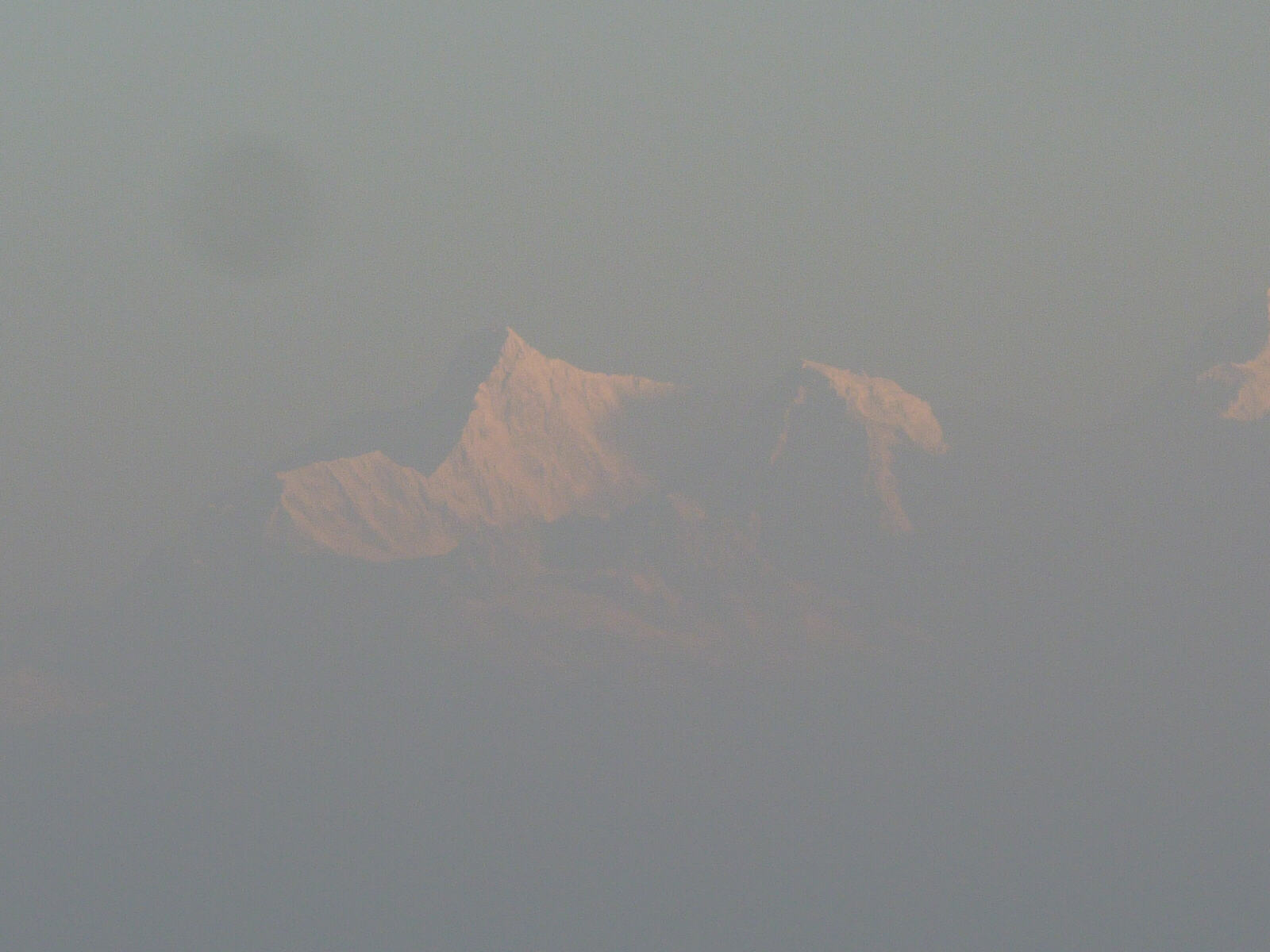
|
Right next door to the Dekeling is the historic Planter’s Club where we stayed on our last visit 10 years ago, and up at the top of the hill is the extremely historic Windamere hotel where we stayed 20 years ago. The Windamere now only seems to do full-board basis for £120+ and we’d rather try different restaurants, so we ruled it out. Sheila was clearly set for a very extended lie-in in the very comfy bed so I went along the Mall to the historic Glenary’s Tea Room (lots of things in Darjeeling are historic!) and sat near the window with a vista of the mountains, having fried eggs and a pile of salty bacon for breakfast. |
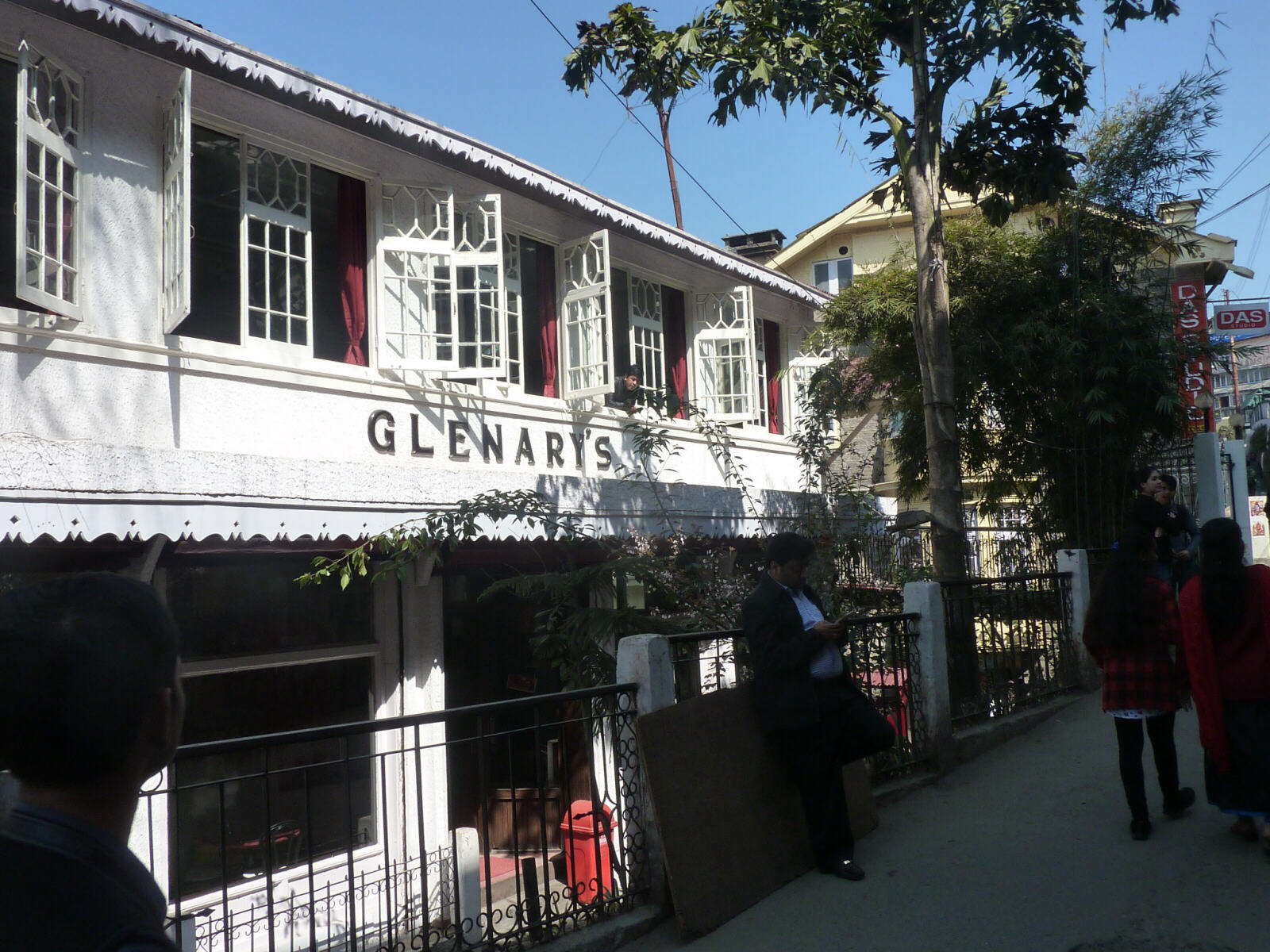
|
We got going but not far before Sheila insisted on her pile of bacon for breakfast, then walked up and down the traffic-free Mall, posing for photos with the colourfully-dressed ladies on the stage at the top. |
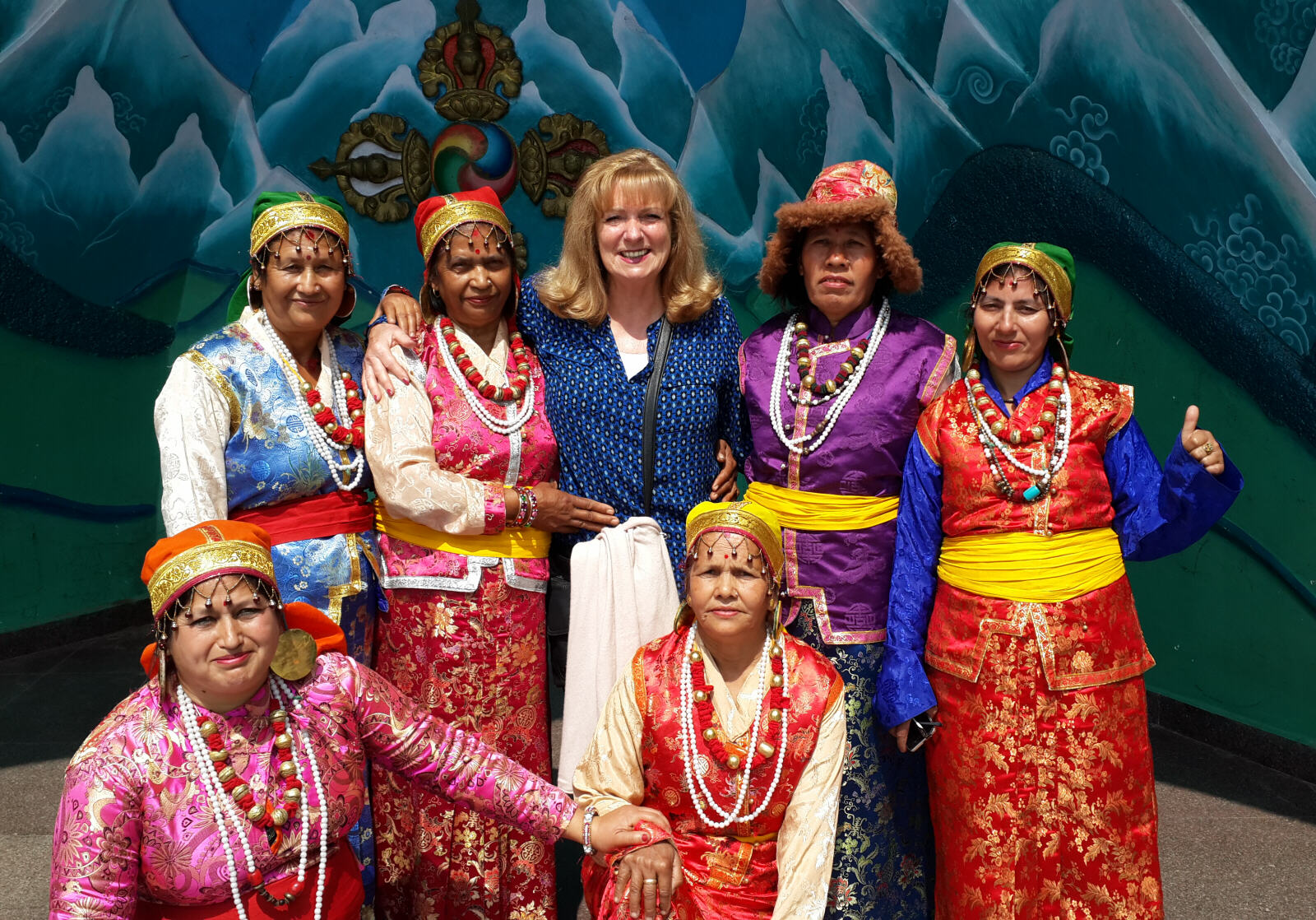
|
We came back to the hotel and shifted from room A5 to A4, a nice bright double-aspect room with fantastic views, then went down to the post office to post some letters. Along the way we stopped at a travel agent who said our next train from New Jalpaiguri to Calcutta would cost £39 each and no discounts were available for old-age pensioners, so we carried on down to the railway reservation office and got exactly the same seats for £8 each with lots of old-age discount (50% for women, 30% for men). Buyer beware! After that we regarded everything that agent con-man had told us with a degree of skepticism. We stopped at Glenary’s again for a roast beef sandwich and a pot of tea for lunch, then later on came back to their upstairs restaurant for a bottle of wine and a nice meal sitting by the fire for dinner.
Thurs 10th. We went across the road to the taxi office and booked a 3-day trip to Pelling in Sikkim, starting tomorrow. Then Mr Rayesh, who brought us up from Siliguri, took us on the ‘Gompa tour’ to see Tibetan-style monasteries. We went 8km or so down the road to Ghoom and down a little side road to Yiga Choling (the old monastery) which was interesting and ancient-looking but rather deserted apart from a young monk who unlocked the door then carried on playing games on his mobile phone. Back on the main road we went a short distance to Ghoom railway station where we were in time to see one of the old steam locomotives manoeuvering a carriage in and out of the sidings, watched by a cluster of tourists and rail enthusiasts. |
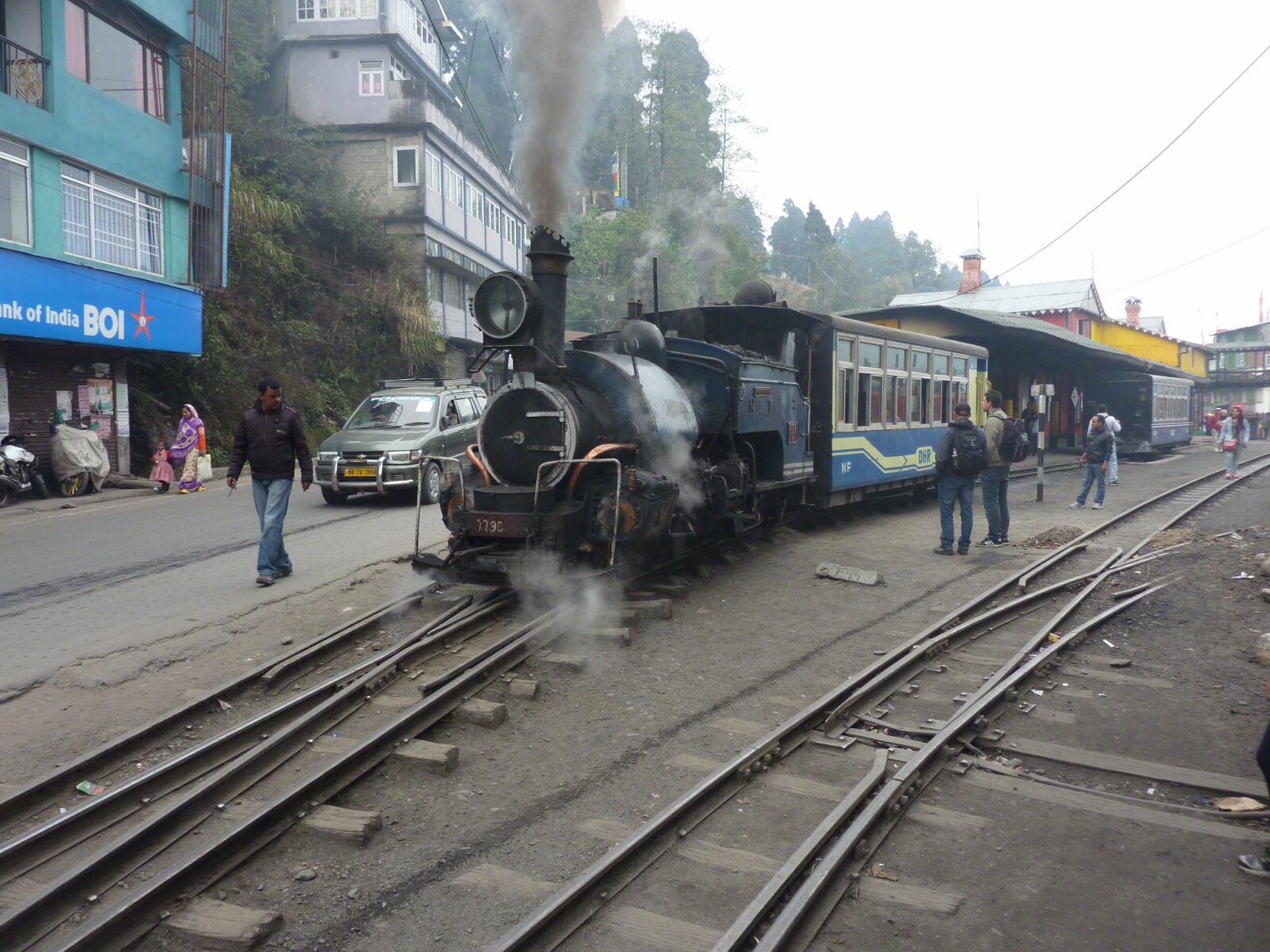
|
Returning a little way along the main road we went to Samten Choling (the new monastery) which was another atmospheric Tibetan-style monastery, but this one was alive with novice monks playing cricket in the courtyard and other people to-ing and fro-ing. |
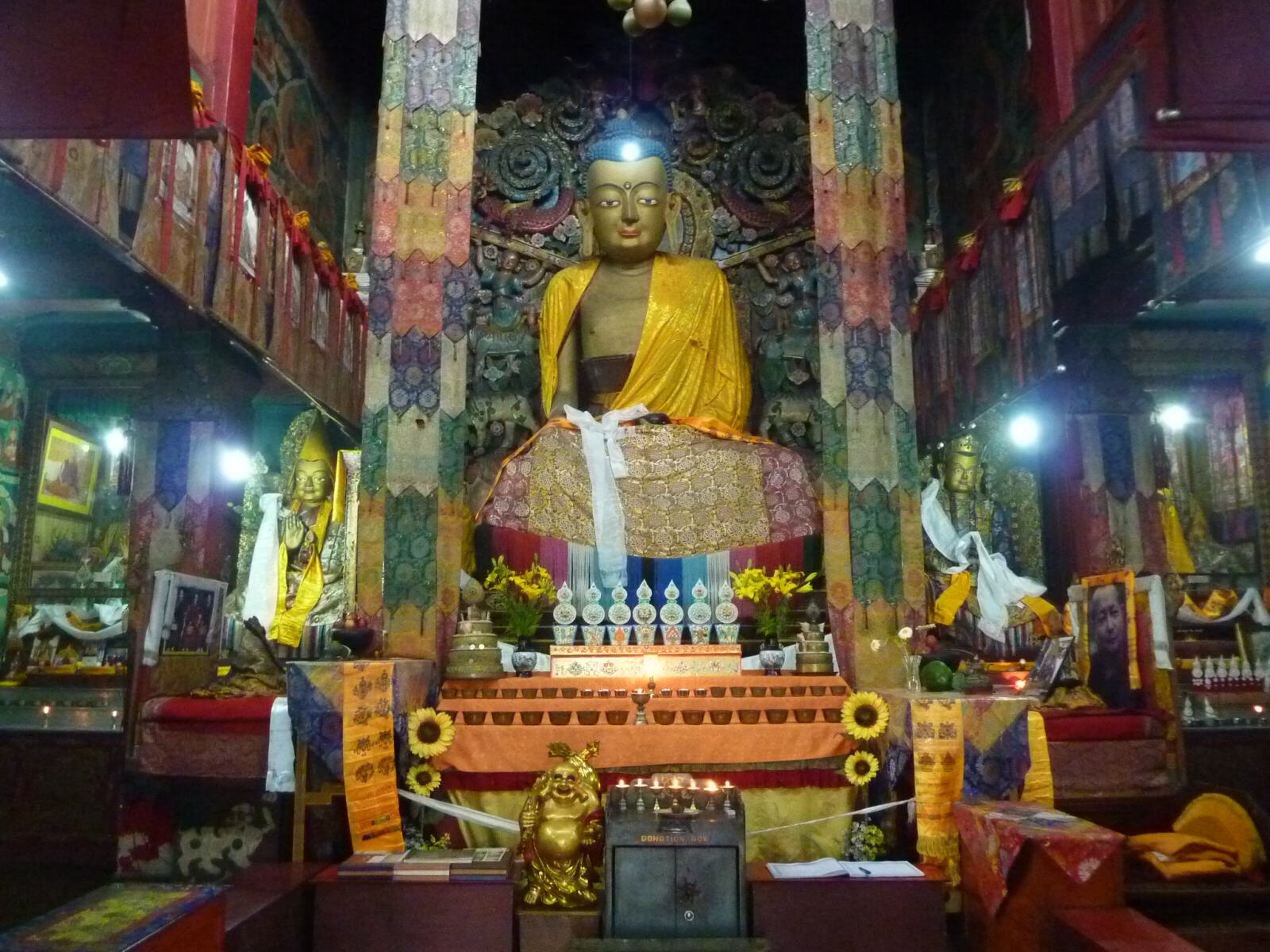
|
Finally, half-way back to Darjeeling we stopped at Druk Sangak Choling, a large modern colourful complex with a side room full of huge prayer wheels powered by an old monk sitting cross-legged in a box hypnotically pulling a cord, soon to be joined by you-know-who. |
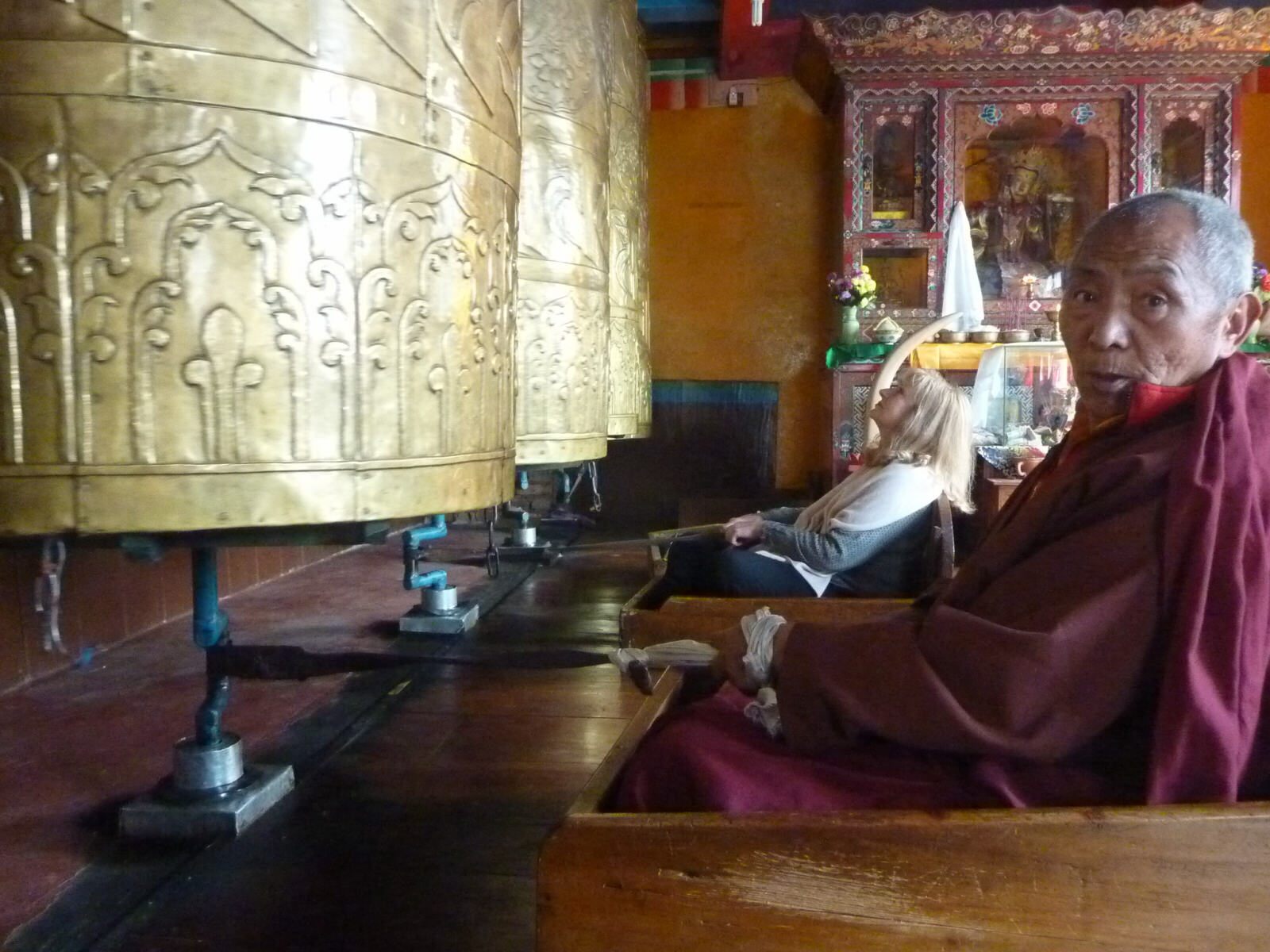
|
Then we heard horns being blown to summon the monks to the main monastery building (which had been locked a few moments ago) and we watched an atmospheric service with horns, drums, cymbals and deep rhythmic chanting. Lucky timing again. We returned to Darjeeling very pleased and had a masala dosa for lunch in Hasty Tasty snack bar on the Mall. That evening we returned to Glenary’s restaurant for another tasty meal sitting by the fire. |
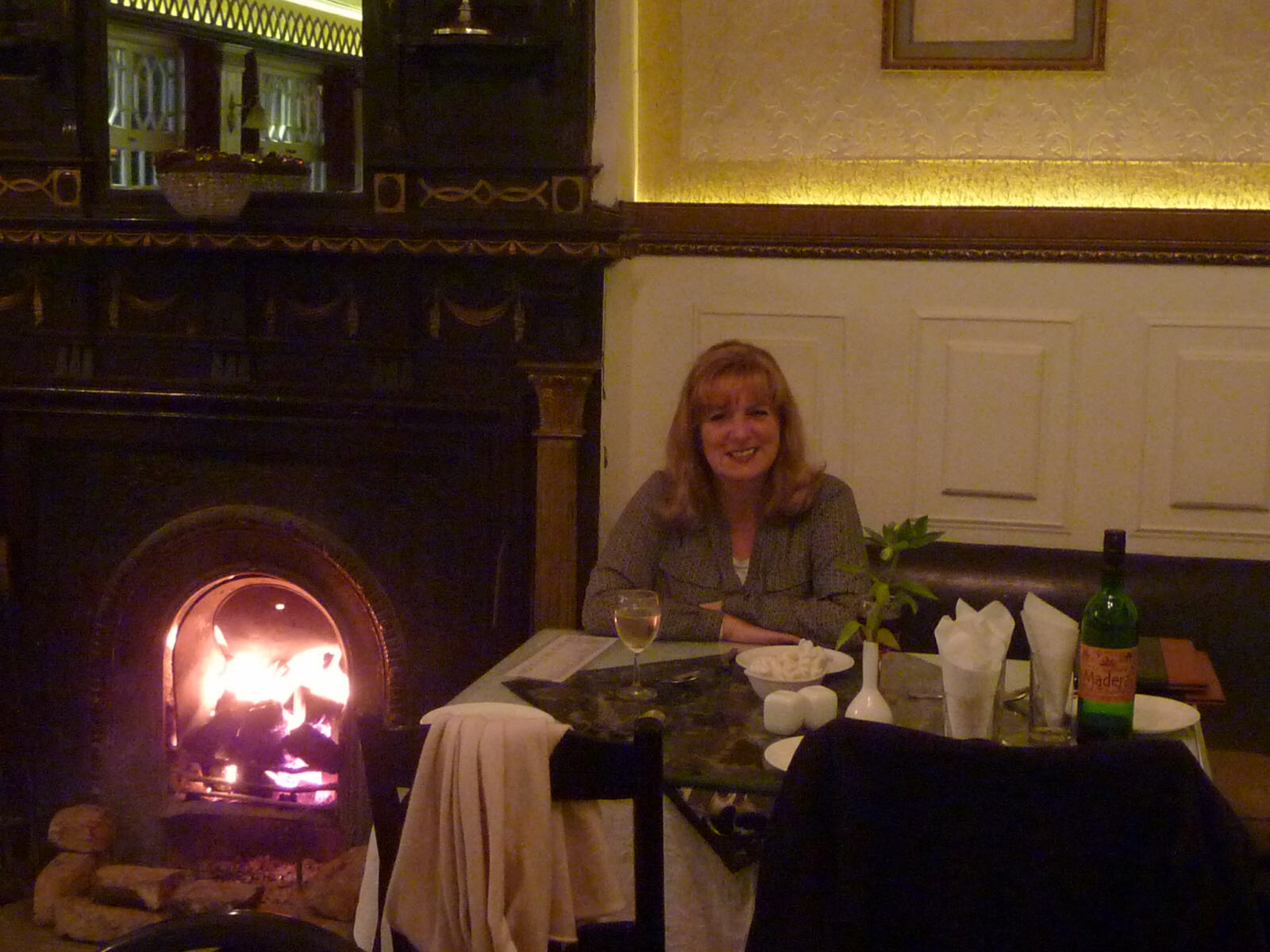
|
Pelling, Sikkim State
|
Fri 11th. We set off with Sonam our nice driver in a very comfortable Mahindra 4WD car and drove to Sikkim. The road was quite good but very winding until we turned off the main road to Gangtok, stopped at a checkpoint to be entered into the computer, then pressed on along really bad roads in deep valleys beside rushing rivers and crossed into West Sikkim district. From there it was uphill all the way until we arrived in Pelling about 5pm and went to the Mountain View hotel which was rather basic and freezing cold for £10 a night (and only 76 steps up to our room this time). We walked down from Middle Pelling to Lower Pelling and found the Newa Regency hotel which had a nice restaurant and bar where they put a couple of beers in the freezer for us and before long we had tasty fried snacks with cold beers.
Sat 12th. We went on our sightseeing tour around Pelling, driving on winding roads through towering mountains, over plunging valleys and across rickety bridges over white-water rivers. We went north-west for an hour or so to Yuksom, the first capital of Sikkim, where the coronation throne of the first Chogyal (king) was in a nice park with stupas and a big prayer wheel. On the way back we stopped at Kangchenzonga waterfall where Sheila had a ride on the ‘death slide’ over the falls, but they ran it slowly because she’s old, which she objected to vehemently. A few km the other side of Pelling we visited Pemayangtse Gompa, an old, colourful and historic Buddhist temple and from there had a view of the ruins of Rabdentse, the second capital of Sikkim. We then drove for an hour along another spectacular road to the west of Pelling, to see the ‘second-highest hanging bridge in Asia’. For some reason Sheila had interpreted this as a rope bridge and was looking forward to wobbling across it but it was actually a normal, but spectacular, suspension bridge. |
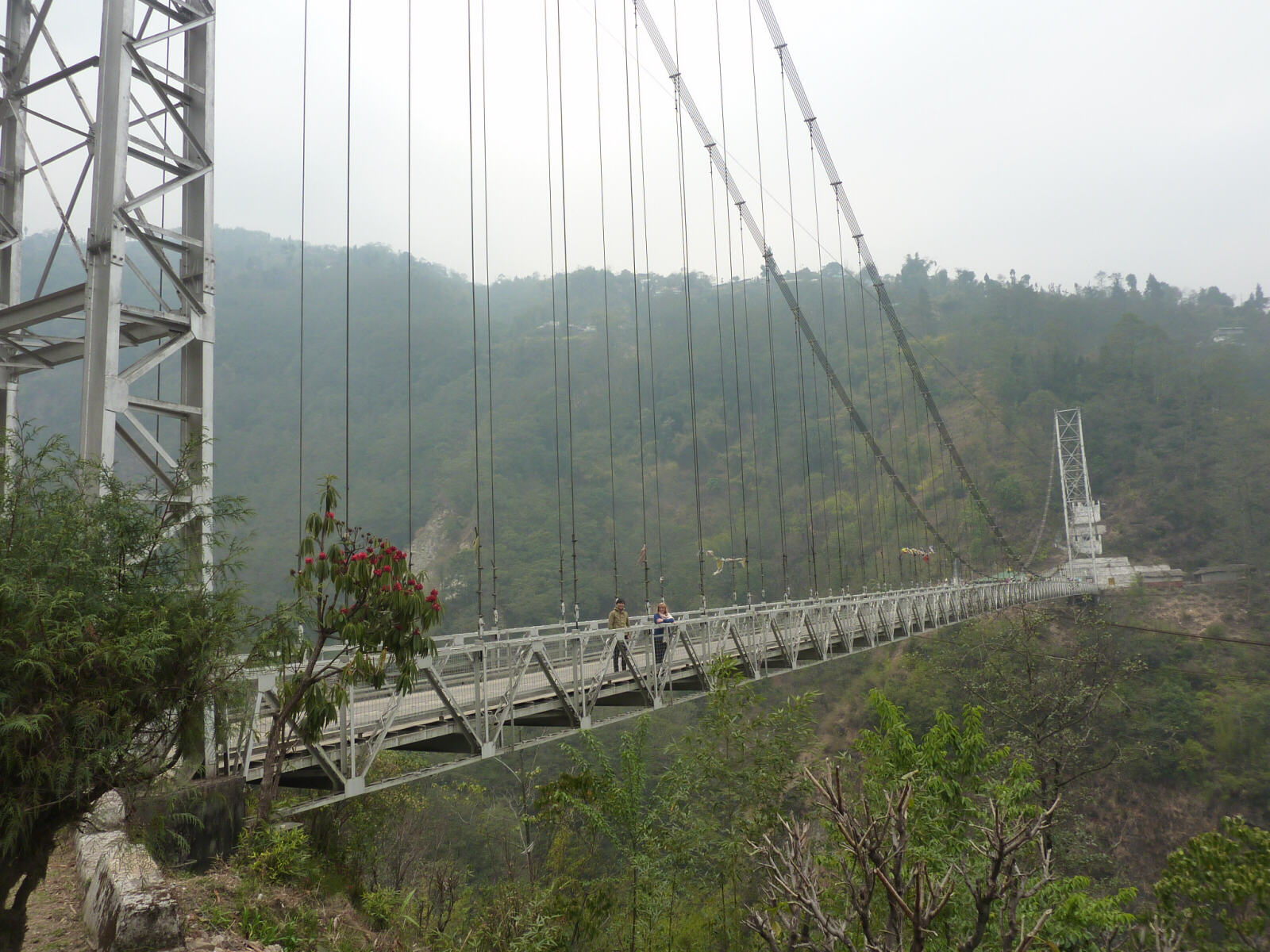
|
Back in Pelling we had a walk up to the centre of Upper Pelling and swapped some books at the Garuda hotel and restaurant, then went back to Newa Regency for more cold beers and a delicious meal.
Sun 13th. For the second morning the fabulous view of Kanchenjunga and the mountains for which Pelling is famous, was completely obscured by mist and we could hardly see the other side of the road from our window. After another nice breakfast at Newa Regency Sonam drove us down to NJP (New Jalpaiguri railway station), arriving about 5pm. We had four hours to wait until our train so we left our cases in left luggage and went to see about a shared taxi into Siliguri, but changed our minds and had nice egg and veg thali meals in ‘Food Line’ in the station, then sat in the ‘upper-class waiting room’ chatting to a nice Indian family returning to Calcutta who had been to ‘point zero’ somewhere at 16,000 feet high in the Sikkim mountains. They left on the 8pm Darjeeling Mail train to Calcutta so we read a bit more until our 9pm train to Calcutta arrived. We made our beds with the bedding provided and settled down to read while the rest of the passengers sorted themselves out. The train left more or less on time, everyone settled in quite quickly, the lights were switched off, peace descended and amazingly not a single seller went shouting his wares up and down the corridor. It was a very pleasant ride, the train went along at a good express pace and we slept well. |
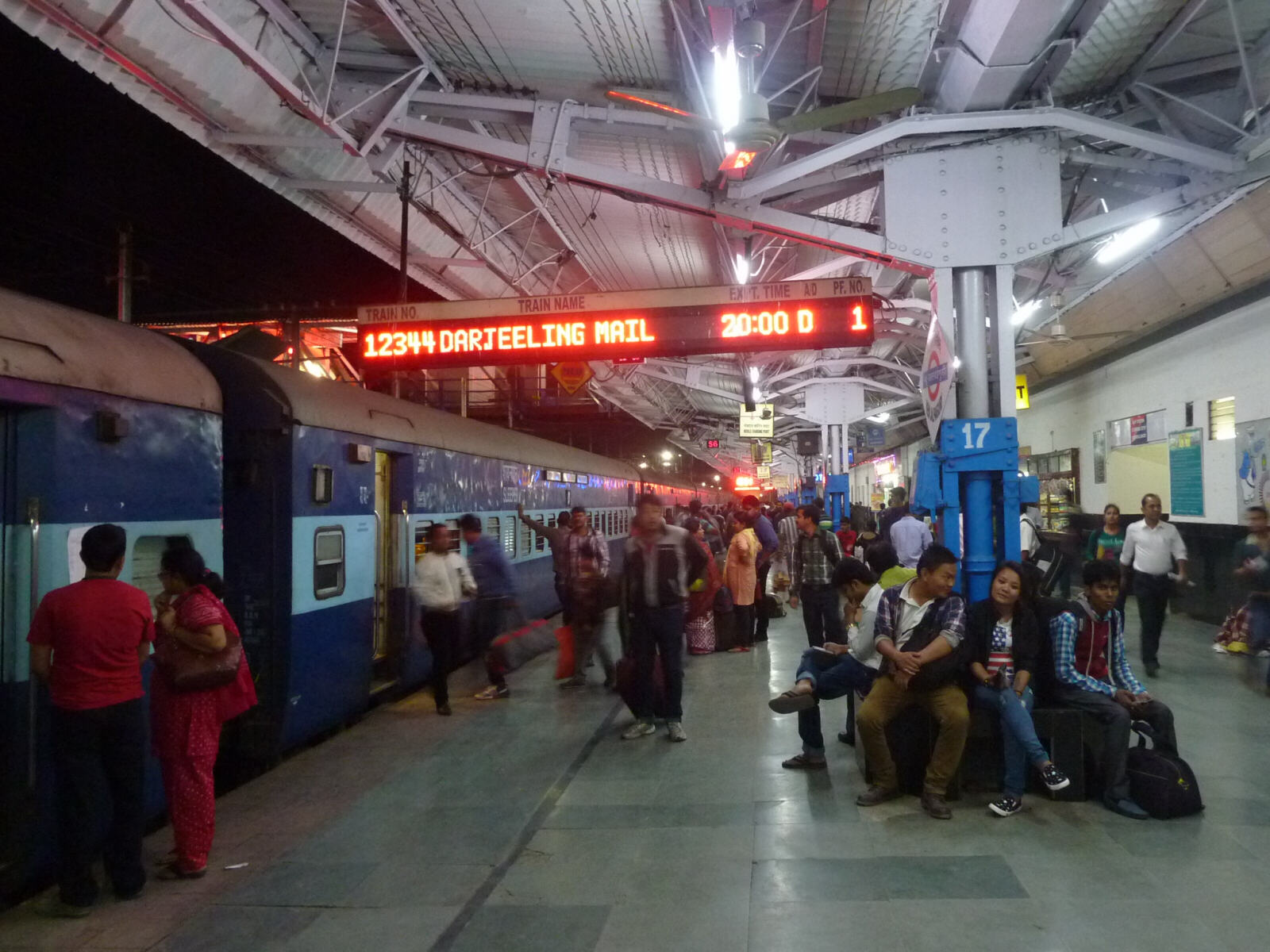
|
Calcutta again
|
Mon 14th. We arrived at Calcutta Sealdah station only a little bit late and sat dozing in our beds until the bedding-boys kicked us off (all the Indians had gone ages before), then strolled through the station concourse packed with commuters from the suburban trains, to the parking area where there seemed to be a problem with the taxis. Apparently there was a ‘taxi strike’ and touts were about, demanding high fares for the many taxis parked all around, while the queue to the prepay taxi booth didn’t seem to be moving. There at the front of the taxi queue was the nice family we talked to at NJP, who had been waiting for an hour! After a quick reunion with them an odd taxi came up to the booth and they were whisked away. We waited for a while then gave in to one of the touts who was asking slightly less than the others. We went to the Fairlawn, a characterful, historic favourite that we’ve stayed in before and where we made a specific booking six weeks ago at the start of this trip, for room 6 which is supposed to be the best. There was a moment of disappointment when they said sorry, room 6 is not available, someone has been in it for two weeks and they can’t turn them out. I thought Sheila was going to explode at this point but they offered us room 8 instead which turned out to be a very nice room, bright, spacious and quiet. We were too early and the room wasn’t ready so we went over to the Blue Sky Café for a refreshing mango juice and breakfast and Sheila had her favourite comfort food, mashed potato with cheese and fried onions on the top. Then we had a walk around the fish market, full of fish in all stages of dismemberment being chopped up by cheery men who were all happy to have their photos taken .... |
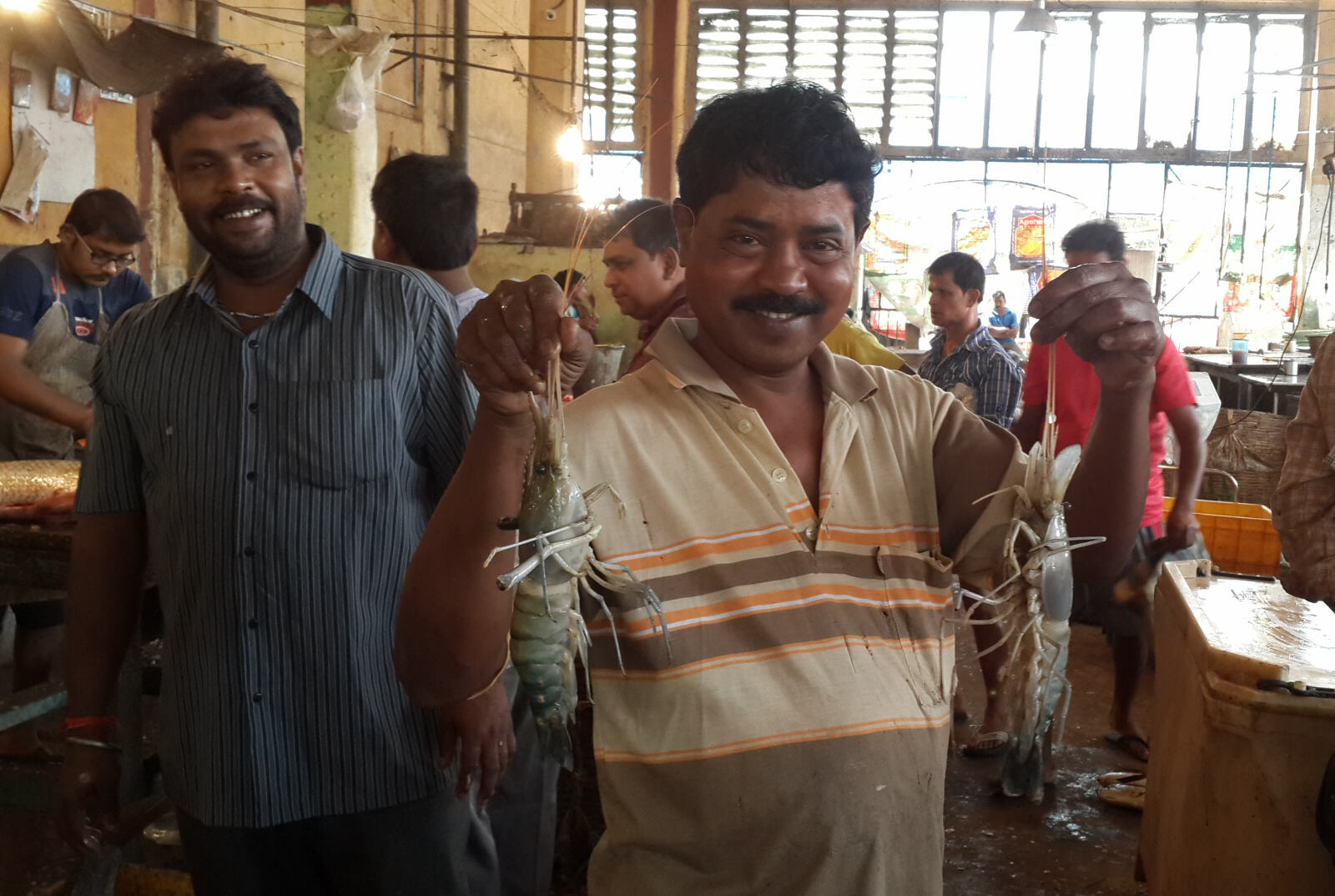
|
.... while opportunistic crows grabbed what they could ....
|
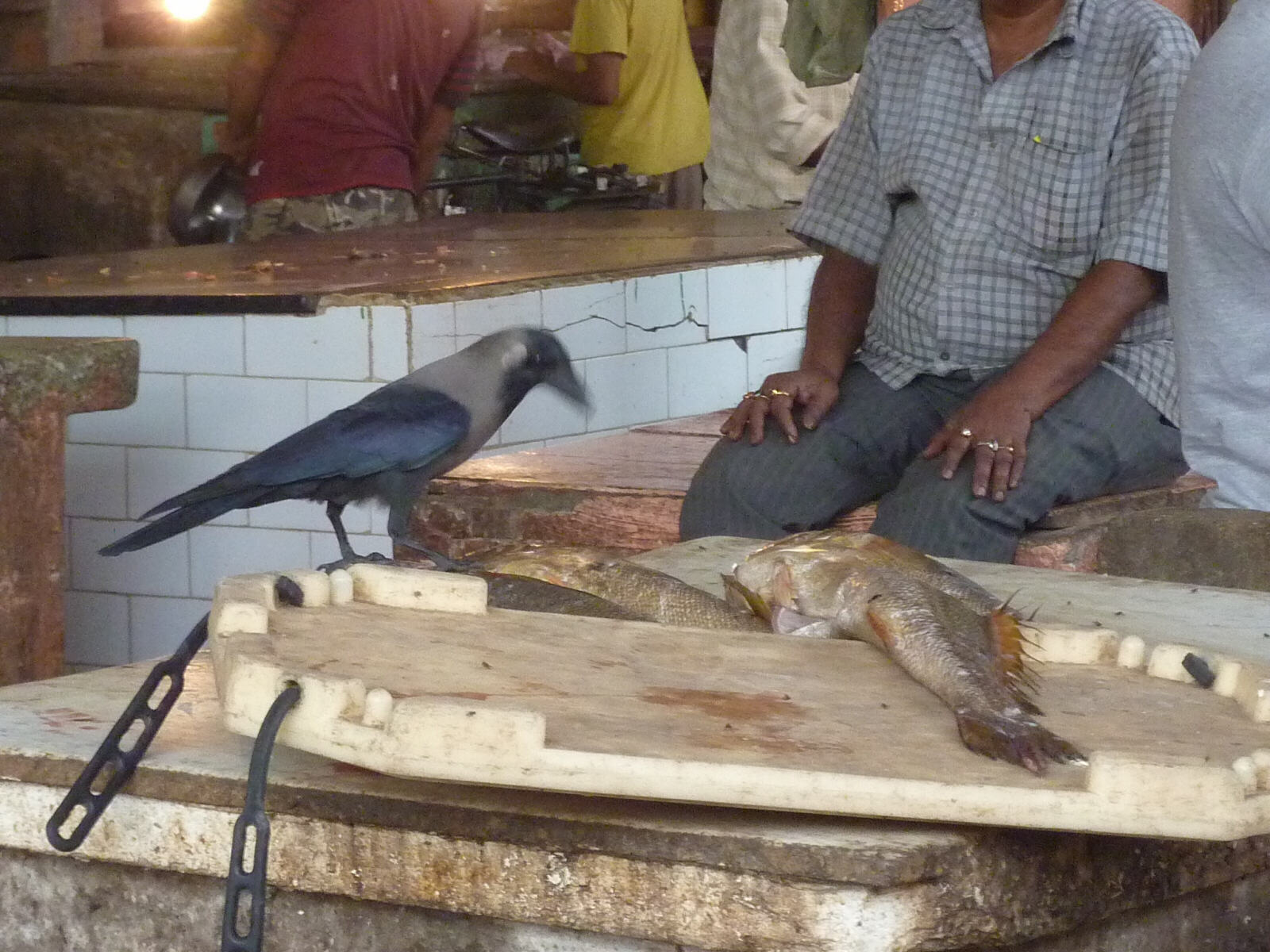
|
.... and next door the equally fascinating but less welcoming meat market where photos were less acceptable.
|
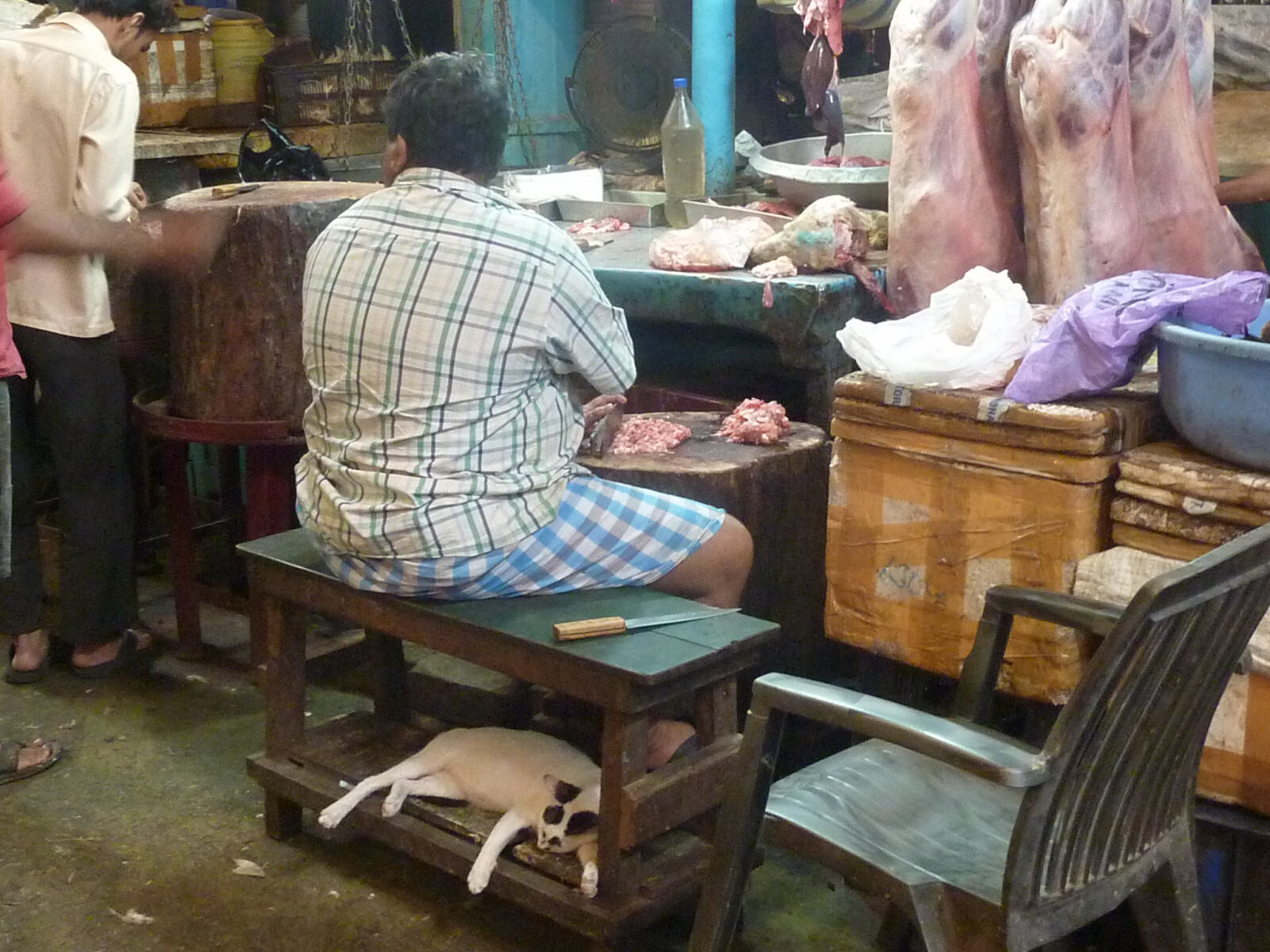
|
Not a place to visit early in the morning when the floors would have been swimming in blood. Back at the Fairlawn we happily settled in, freshened up and it felt very civilized. In the afternoon I went out to finish the ‘Second City of the Empire’ walk that we didn’t quite complete six weeks ago, visiting St Andrew’s Church (closed), the Old Currency Building, the Postal sorting office and Raj Bhavan again. In the evening we set out to find a dry cleaner’s establishment we thought we’d seen but despite several directions we couldn’t find it, but we ended up on Park Street and found Trinca’s restaurant (which we looked for and failed to find six weeks ago) and had nice glasses of wine and a very tasty meal.
Tues 15th. A quiet last day in Calcutta with a bit of shopping, an 80 pence haircut and a nice meal at Trinca’s.
Wed 16th – Thurs 17th. We flew home. We had an 8-hour shopping stopover in Dubai but to Sheila's disappointment everything she wanted was more expensive than in England. We spent the time surveying the Marhaba lounges in the three sections of the terminal and decided that 'B' was by far the best. The plane from Calcutta to Dubai was rather cramped and the selection of films was not great, but on the flight from Dubail to Gatwick there was an enormous selection of films in all sorts of languages as exotic as Ethiopan. The food was delicious too. |
If you would like to see more of our travels just click the map.
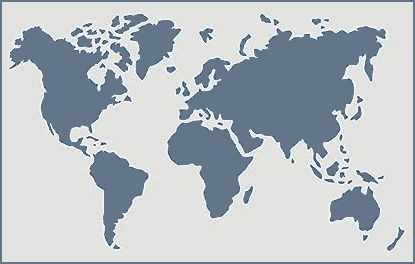
|